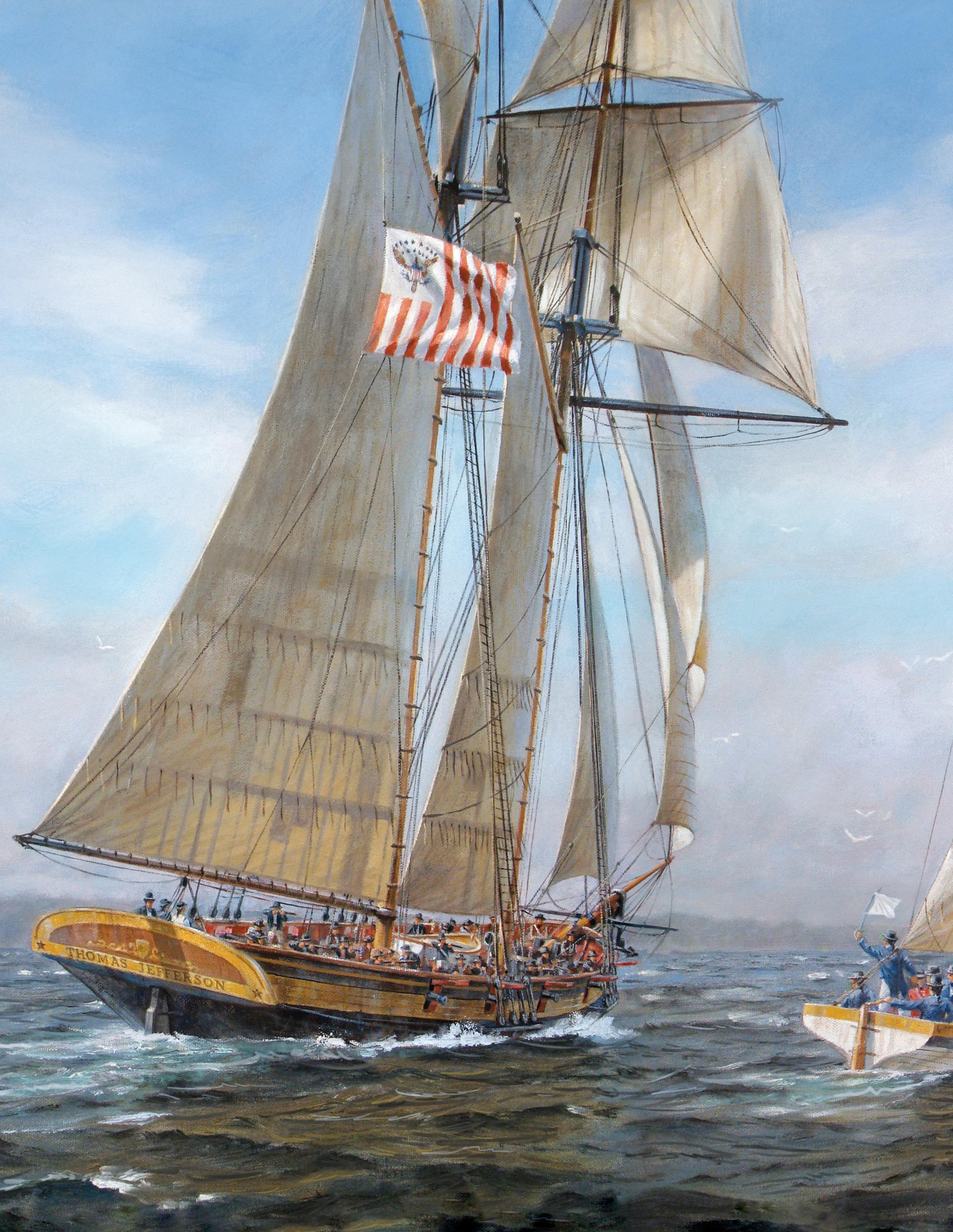
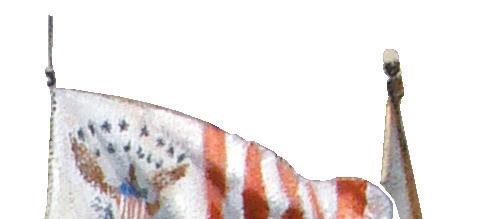
WINTER 2022 – 23 No. 181 THE ART, LITERATURE, ADVENTURE, LORE & LEARNING OF THE SEA $4.95 SEA HISTORY Blockade Runner Aground Spanish Plate Fleet Wrecks U-boats vs. Windjammers NATIONAL MARITIME HISTORICAL SOCIETY
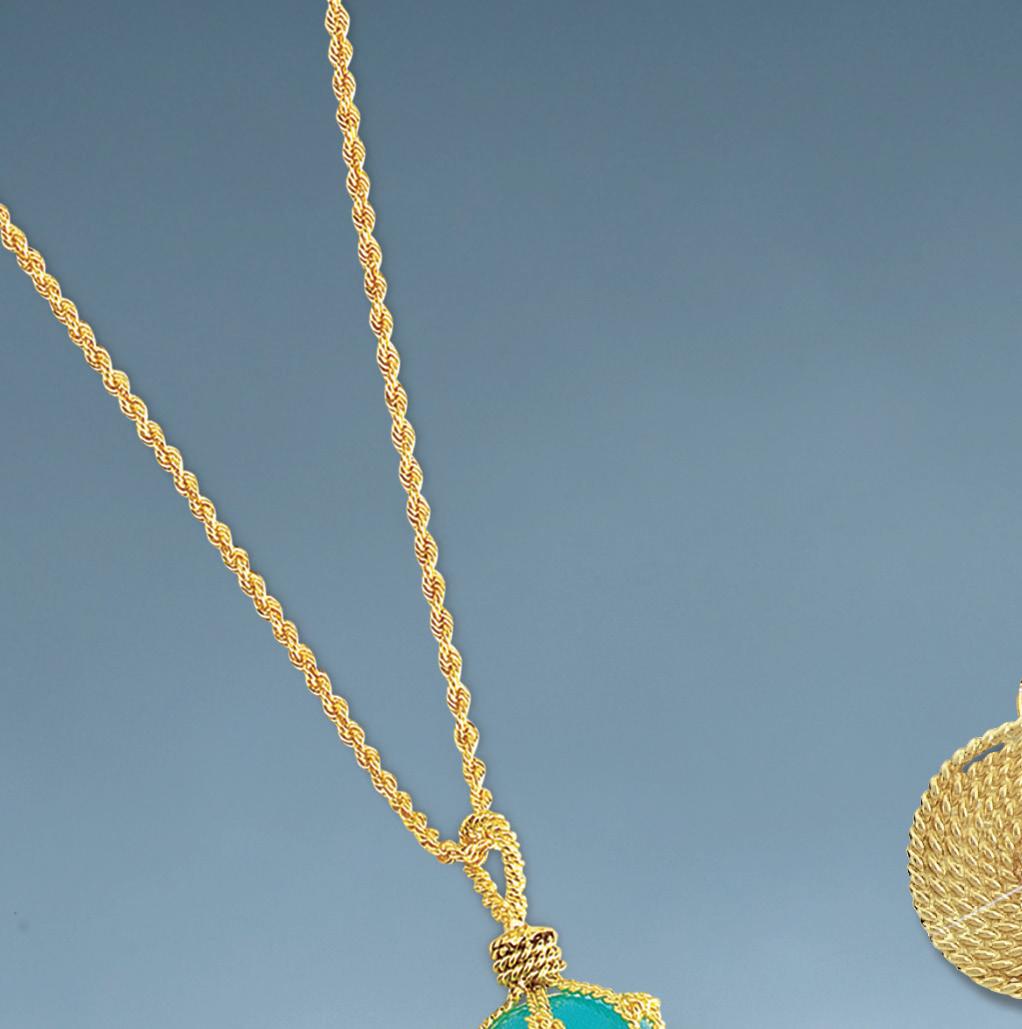







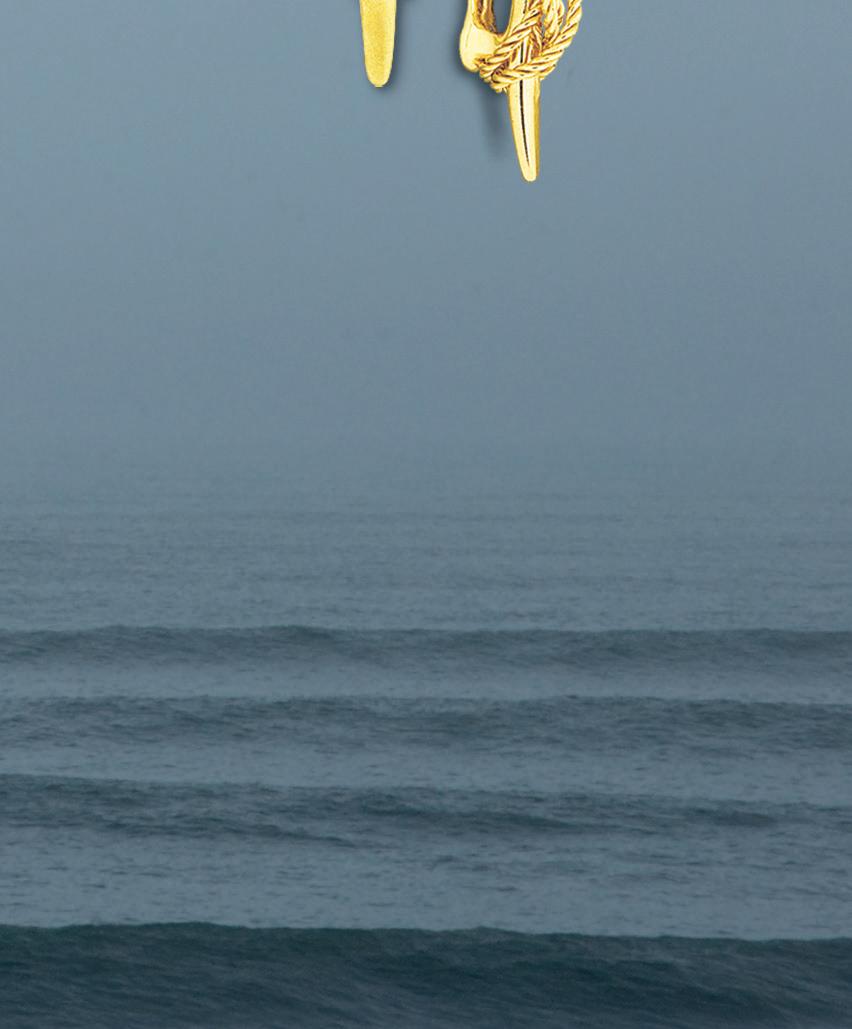



14k 18k A - Fish Float Sphere with Aqua Chalcedony Pendant (U.S. Patent D678,110) n/a ------------- $2100. B - Flemish Coil Pendant (matching earrings available) ---------------------------------------------- $1650. ------------ $2100. C - Compass Rose with working compass Pendant ----------------------------------------------- $2100. ------------ $2900. D - Correa/Chart Metalworks 3/4" Sailboat Pendant $1850. ------------ $2500. E - Reef Knot Bracelet -------------------------------------------------------------------------------------------------- $5250. ------------ $6900. F - Monkey's Fist Stud Earrings (matching pendants available) --------------------------------- $1400. ------------ $1900. G - Deck Prism Anchor Chain Dangle Earrings (matching pendant available) -------------n/a ------------- $2300. H- Cleat Hitch Dangle Earrings (hand-tied and matching pendant available) ----------- $1900. ------------ $2750. I - Port & Starboard Hand Enameled Dangle Earrings -------------------------------------------------n/a ------------- $2250. J - Anchor with Rope Earrings (matching pendants available) ---------------------------------- $1400. ------------ $1850. K- Two Strand Turk's-head Ring with sleeve (additional designs available) -------------- $2300. ------------ $2900. • 18" Rope Pendant Chain $750. C A G PO Box 1 • 11 River Wind Lane, Edgecomb, Maine 04556 USA • M-F 10-5 ET customer.service@agacorrea.com • Please request our 52 page book of designs • 800.341.0788 • agacorrea.com B D J E H F K Over 1000 more nautical jewelry designs at agacorrea.com ® A.G.A. CORREA & SON JEWELRY DESIGN I ©All designs copyright A.G.A. Correa & Son 1969-2022 and handmade in the USA Jewelry shown actual size | Free shipping and insurance
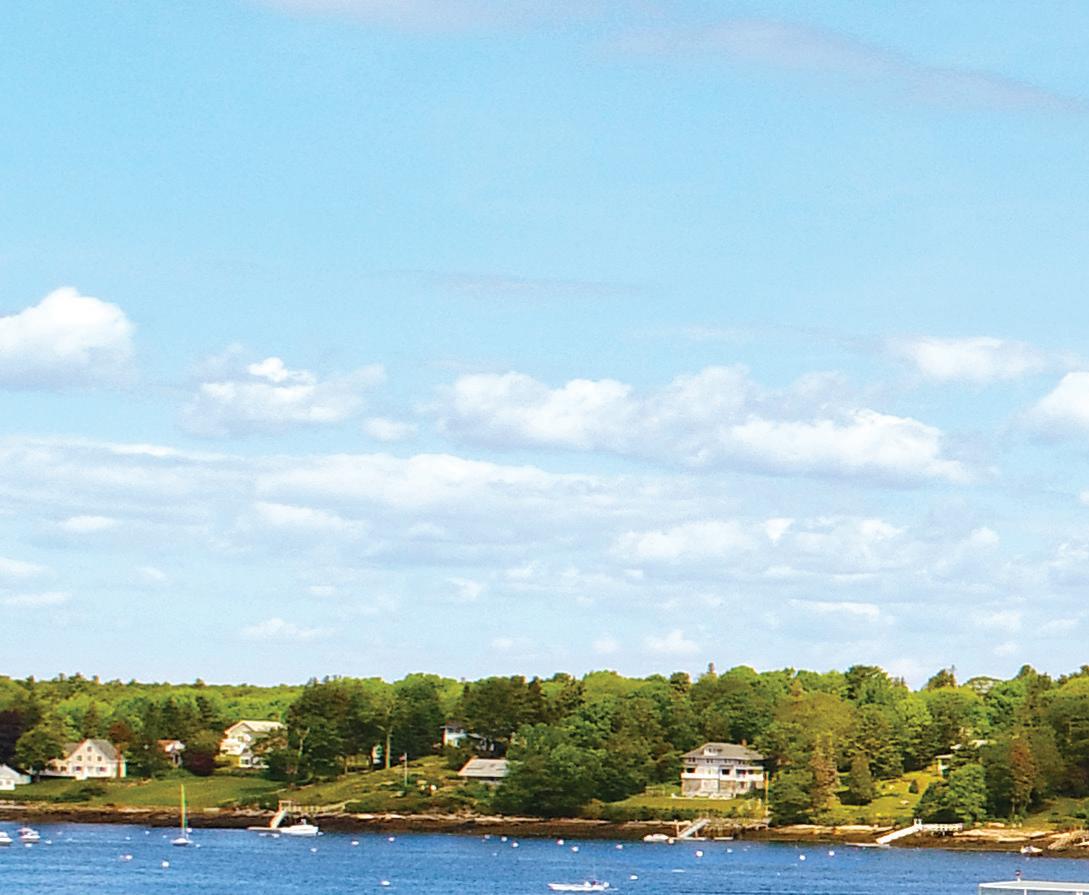

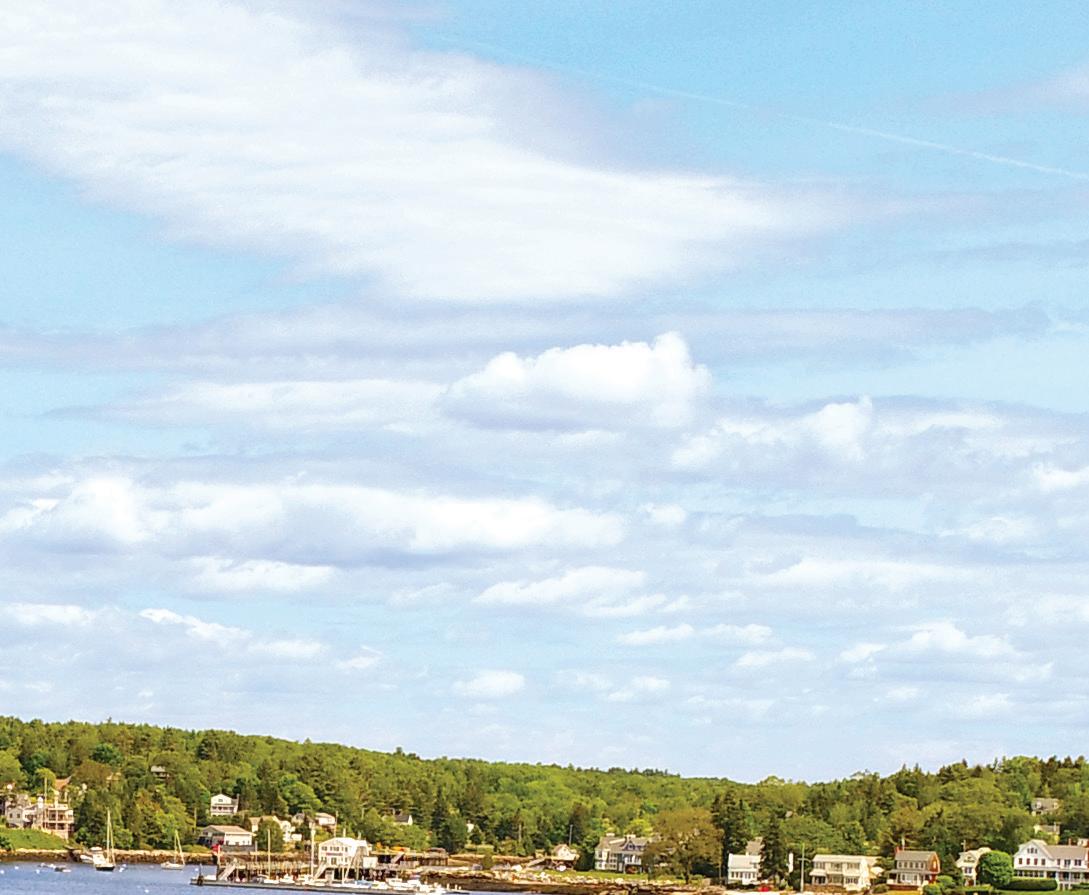











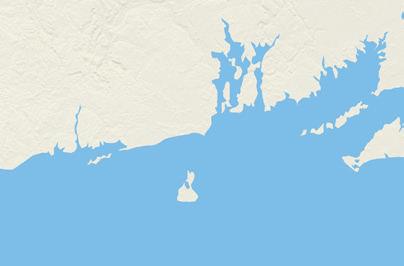



Portland Rockland Boothbay Harbor Bath Camden Bucksport Gloucester Bar Harbor Boston Atlantic Ocean Provincetown Newport Martha’s Vineyard MAINE NEW HAMPSHIRE MASSACHUSETTS RHODE ISLAND Immerse yourself
the
Small Ship Cruising Done Perfectly ® Explore New England with the Leader in U.S. Cruising Call today 866-229-3807 to request a free Cruise Guide Your New England Explorer Cruise Includes: 11-days/10-nights on board the ship An exploration of 10 ports of call, with guided excursion options at each All onboard meals and breakfast room service Full enrichment package with guest speakers and nightly entertainment Our signature evening cocktail hour with hors d’oeuvres
in
sights, sounds, and tastes of New England. From the quaint island villages of Nantucket and Martha’s Vineyard, to the scenic beauty of coastal Maine, summer in New England is a delightful experience. Enjoy a local Lobsterbake, indulge in the area’s rich maritime history, and witness magnificent mansions of the Gilded Age.
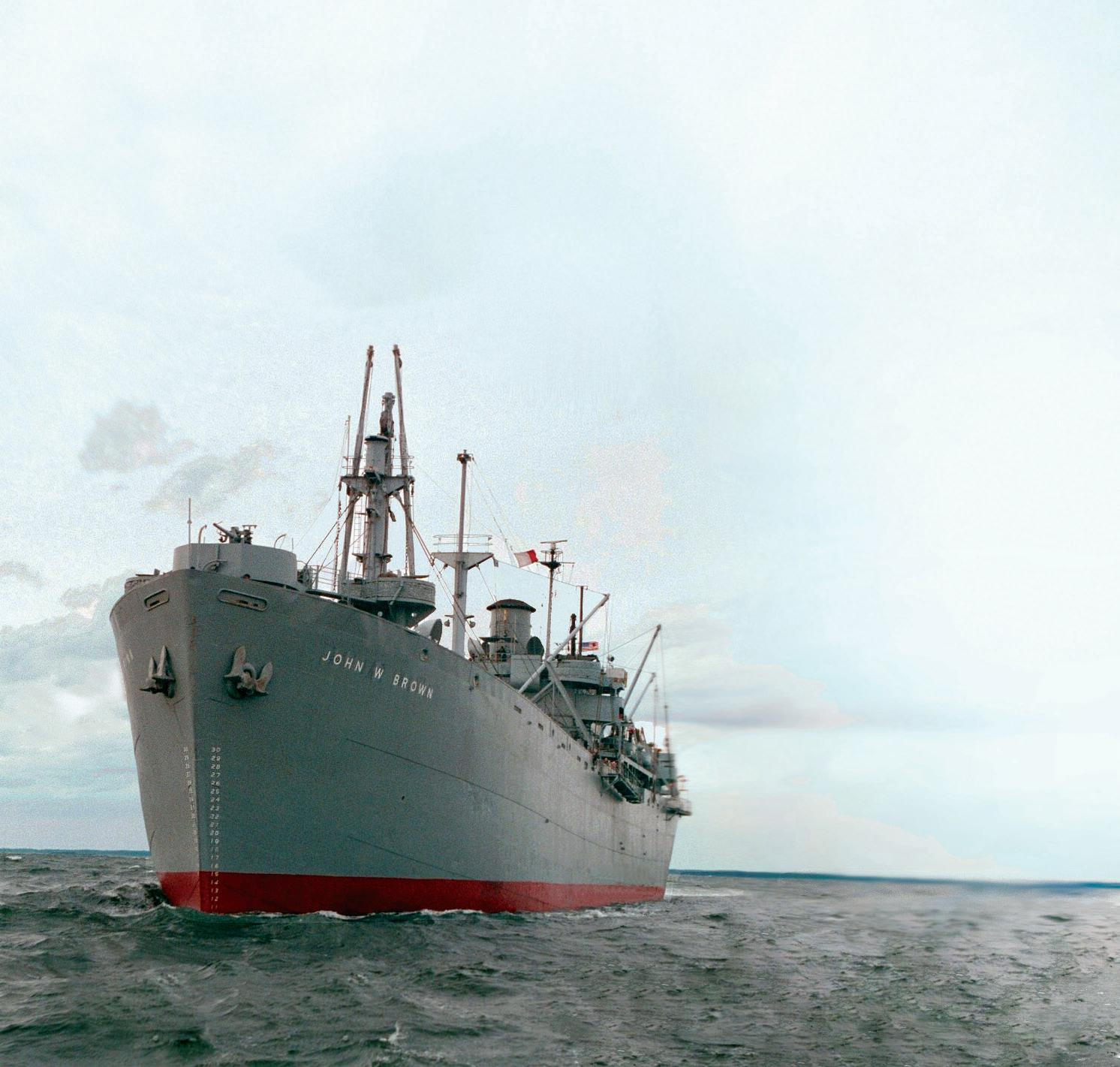

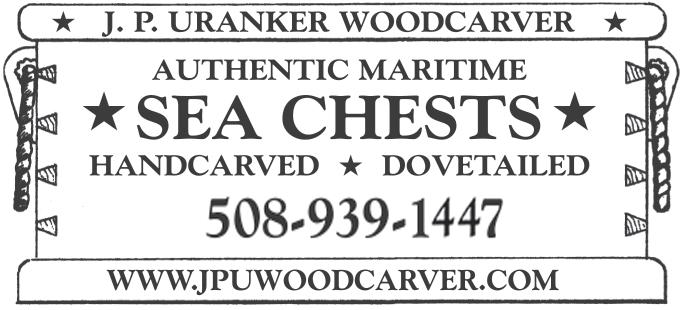






Sail Aboard the Liberty Ship John W. B roW n Reservations: 410-558-0164, or www.ssjohnwbrown.org Last day to order tickets is 14 days before the cruise; conditions and penalties apply to cancellations. Check our Website for 2023 Cruise Dates On a cruise you can tour museum spaces, bridge, crew quarters, & much more. Visit the engine room to view the 140-ton triple-expansion steam engine as it powers the ship though the water. Project Liberty Ship is a
all volunteer, nonproft organization. SS
W.
is maintained in her
Visitors must be able to climb
Mystic Knotwork A New England Tradition For 60 Years 25 Cottrell St. • 2 Holmes St. Open 7 days a week - 860.889.3793 MysticKnotwork.com Traditional Knotwork made in Downtown Mystic CHESAPEAKE BAY MARITIME MUSEUM Your Chesapeake adventure begins here! 213 N. Talbot St., St. Michaels, MD | 410-745-2916 | cbmm.org
Baltimore-based,
JOHN
BROWN
WWII confguration.
steps to board.
CONTENTS
10 Submarine Warfare and the Decline of Sailing Fleets, 1914–1918 by Steven Woods

By the start of WWI, sailing vessels were still a popular choice for carrying cargo, but they were relatively easy prey for submarines. Steven Woods discusses how it was the U-boat, and not the steam competitor, that contributed most to the decline of the sailing ship.
14 Marked for Disaster— e Tragic Loss and Inspiring Legacy of the 1554 Spanish Plate Fleet of Padre Island, Texas by Amy Borgens e 1964 discovery of a legendary 16th-century eet of treasure-laden ships o the coast of Texas, and the state’s legal struggle to establish control over the site, inspired the establishment of a legal framework for the protection of Texas’s underwater heritage assets.
22 Curator’s Corner—Historic Photos from the Archives by Kevin Cullen
Wisconsin Maritime Museum curator Kevin Cullen combed the archives, and shares a charming 1890 photograph of a winter scene on Lake Michigan, shot by Captain Edward Carus, who faithfully documented much of the maritime heritage of his Great Lakes routes.
24 Greenland Beckons: Explorer Louise Arner Boyd aboard the Veslekari by Joanna Kafarowski
In the 1930s, high-society heiress, Arctic explorer, and dedicated geographic photographer Louise Arner Boyd organized, paid for, and led four expeditions to the Arctic. For each mission she chartered the Norwegian sealer Veslekari, sister ship of explorer Roald Amundsens’s Maud.

30 Navigating Risk: Early American Marine Insurance and the Growth of a Nation by Hannah Farber, PhD
When shipowners began buying shares in multiple vessels vs. owning fewer outright, it was in large part to share the risk if the ship and cargo were damaged or lost. Historian Hannah Farber deciphers a typical contract between American shipowners and early marine insurance underwriters.
34 A Grounded Flight: e Harrowing Rescue of an American Blockade Runner in the Dark Days of War by CAPT Daniel A. Laliberte, USCG (Ret.)
During the War of 1812, the treacherous shoals of the Chesapeake Bay and the vagaries of weather often contributed to the jeopardy of the cat-and-mouse pursuit of blockade runners and British ships.
Cover: US Revenue Cutter omas Je erson chasing down three Royal Navy boats on 11 April 1813. Painting by Patrick O’Brien, courtesy USCG Art Collection. See article on pp. 34–38.

Sea History and the National Maritime Historical Society
Sea History e-mail: seahistory@gmail.com • NMHS e-mail: nmhs@seahistory.org Website: www.seahistory.org • Ph: 914 737-7878; 800 221-NMHS

MEMBERSHIP is invited. Afterguard $10,000; Benefactor $5,000; Plankowner $2,500; Sponsor $1,000; Donor $500; Patron $250; Friend $100; Regular $45. All members outside the USA please add $20 for postage. Sea History is sent to all members. Individual copies cost $4.95.
norsk
SEA HISTORY (issn 0146-9312) is published quarterly by the National Maritime Historical Society, 1000 North Division St., #4, Peekskill NY 10566 USA. Periodicals postage paid at Peekskill NY 10566 and add’l mailing o ces.
COPYRIGHT © 2022 by the National Maritime Historical Society. Tel: 914 737-7878.
POSTMASTER: Send address changes to Sea History, 1000 North Division St., #4, Peekskill NY 10566.
HISTORY No. 181 WINTER 2022–23 4 Deck L og 5 L etters 8 NMHS: A C ause in Motion 40 M arine A rt News 42 Sea History for K ids 46 Ship Notes, Seaport & Museum News 56 R eviews 64 Patrons NATIONAL MARITIME HISTORICAL SOCIETY
24
polarinstitutt DEPARTMENTS SEA
10 nhhc , us navy 14 art by peter rindlisbacher 30 boston public library
DECK LOG
A New Decade Invites Us to Set New Goals
In 2023, the National Maritime Historical Society will celebrate its 60th anniversary. As we look to the future, we’re also giving a lot of thought to what has been our mission since 1963, and what it means today to “preserve maritime history, promote the maritime heritage community, and invite all to share in the adventures of seafaring.” As we chart the course ahead, we’re asking ourselves how we can improve our programs, embrace new perspectives, and expand our impact.
NATIONAL MARITIME HISTORICAL SOCIETY
PUBLISHER’S CIRCLE: Peter Aron, Guy E. C. Maitland, Ronald L. Oswald
OFFICERS & TRUSTEES: Chairman, James A. Noone; Vice Chairman, Richardo R. Lopes; Vice Presidents: Jessica MacFarlane; Deirdre E. O’Regan, Wendy Paggiotta; Treasurer, William H. White; Secretary, Capt. Je rey McAllister; Trustees: Charles B. Anderson; Walter R. Brown; CAPT Patrick Burns, USN (Ret.); CAPT Sally McElwreath Callo, USN (Ret.); William S. Dudley; David Fowler; Karen Helmerson; VADM Al Konetzni, USN (Ret.); K. Denise Rucker Krepp; Guy E. C. Maitland; Salvatore Mercogliano; Michael Morrow; Richard Patrick O’Leary; Ronald L. Oswald; Timothy J. Runyan; Richard Scarano; Capt. Cesare Sorio; Jean Wort
CHAIRMEN EMERITI: Walter R. Brown, Alan G. Choate, Guy E. C. Maitland, Ronald L. Oswald; Howard Slotnick (1930–2020) FOUNDER: Karl Kortum (1917–1996)
PRESIDENTS EMERITI: Burchenal Green, Peter Stanford (1927–2016)
OVERSEERS: Chairman, RADM David C. Brown, USMS (Ret.); RADM Joseph F. Callo, USN (Ret.); Christopher J. Culver; Richard du Moulin; Alan D. Hutchison; Gary Jobson; Sir Robin Knox-Johnston; John Lehman; Capt. James J. McNamara; Philip J. Shapiro; H. C. Bowen Smith; John Stobart; Philip J. Webster; Roberta Weisbrod
I am inspired by the conversations and exchanges that I’ve had with so many of our members over the last few months, and I look forward to continuing the dialogue in the year ahead. anks to the leadership of people like the late Peter Stanford, Burchenal Green, and our dedicated board of trustees, we’ve come a long way over the past six decades, broadening our horizons from an initial focus on historic ships and ship-saving to include the world of marine art, mariners and the blue economy, ocean conservation, maritime archaeology, and broader maritime history.
In addition to Sea History, published since 1972, we hope to launch a new educational publication aimed at school-aged children. Building on the success of Sea History for Kids, one of the magazine’s most popular regular features, our goal is to invite this youngest generation to a lifetime of interest in and awareness of our maritime world. To succeed in reaching out to new and diverse audiences in an increasingly digital world, we also plan to invest in our educational content and to expand our presence online.
We hope you’re as excited as we are. Please wish us a happy 60th and let us know how we’re doing! You can share your vision with me at nmhs@seahistory.org, or schedule a time to chat about all the work we’re doing. I look forward to hearing from you!
 —Jessica MacFarlane, NMHS Executive Director
—Jessica MacFarlane, NMHS Executive Director
NMHS ADVISORS: John Ewald, Steven A. Hyman, J. Russell Jinishian, Gunnar Lundeberg, Conrad Milster, William G. Muller, Nancy H. Richardson
SEA HISTORY EDITORIAL ADVISORY BOARD: Chairman, Timothy Runyan; Norman Brouwer, Robert Browning, William Dudley, Lisa Egeli, Daniel Finamore, Kevin Foster, Cathy Green, John O. Jensen, Frederick Leiner, Joseph Meany, Salvatore Mercogliano, Carla Rahn Phillips, Walter Rybka, Quentin Snediker, William H. White
NMHS STAFF: Executive Director, Jessica MacFarlane; Vice President of Operations, Wendy Paggiotta; Director of Special Projects, Nicholas Raposo; Senior Sta Writer, Shelley Reid; Business Manager, Andrea Ryan; Manager of Educational Programs, Heather Purvis; Membership Coordinator, Marianne Pagliaro
SEA HISTORY: Editor, Deirdre E. O’Regan; Advertising Director, Wendy Paggiotta
Sea History is printed by e Lane Press, South Burlington, Vermont, USA.
4 SEA HISTORY 181, WINTER 2022–23
in the wild productions
photo by chris hamilton ,
LETTERS
Fair Winds Burchie Green!
On 22 September, a group of women, known in the New York maritime industry as the Waterfront Wenches, gathered on board the historic Coast Guard buoy tender Lilac at Pier 25 in Manhattan to honor one of our longtime members on her retirement from the National Maritime Historical Society. Due to the pandemic, it had been a number of years since our last
We Welcome Your Feedback!
Please email correspondence to editorial@seahistory.org.
events and at informal get togethers; for your support in publishing my Harbor Voices book; for earning an a ectionate place in the hearts of so many people over so many years with your arduous work and your beautiful smile. Sea History magazine has ourished over the past two decades due to Burchie’s leadership, and Deirdre [O’Regan] carries on Sea History’ s mission smartly and engagingly. Burchie always
e Launch is Just the Beginning for Maine’s First Ship
Many thanks to Charley Seavey for his ne account of the launch of Maine’s First Ship, the pinnace Virginia, in the autumn issue of Sea History, an excellent account of a day

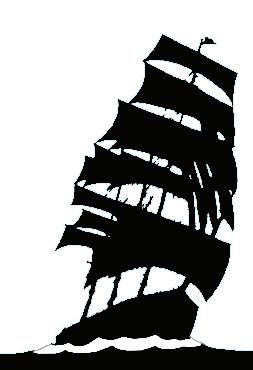
NMHS president emeritus Burchenal Green (center) is fêted by the Waterfront Wenches, Lauretta Bruno (left) and Lucy Ambrosino, aboard the historic buoy tender Lilac in NYC.

get together, but Burchie’s retirement was an event we could not let pass without a salute to her many years of devoted service to NMHS and Sea History and the maritime industry as a whole. A wonderful time was had by all, reconnecting with old friends, toasting the memory of one of our original founders, the late Linda O’Leary, and wishing the best to our friend and colleague—dear Burchie.
Janet H ellmann
Staten Island, New York
How tting to honor Burchie on a New York Harbor pier! I know that all present felt a ectionate and grateful for this power lady’s years of smart, capable, successful attention to all things maritime. She and Peter Stanford worked grandly together. I know that he believed in her deeply, as did other seasoned ship souls near and far. Burchie, thank you for the million ways in which you have helped maritime history stay alive and well in the hearts and minds of so many.
You have been my steadfast friend: for always greeting me so warmly at NMHS
made all of us welcome with her warm smile, incredible memory, attention to detail, and the greeting in her eyes.
Happy retirement to you, Burchie!
Terry Walton Cold Spring Harbor, New York
that turned out better than any of us had dared hope, even after more than a year of planning. It will surprise no reader of Sea History to learn that putting the ship in the water does not mean that construction is done. Far from it. And indeed, work has been ongoing since her launch in early June. I thought perhaps an update on Virginia’s progress and her future might be appropriate to share with your readers.
e most visible progress has been on the ship’s rigging, where a gang of about
Join Us for a Voyage into History
Our seafaring heritage comes alive in the pages of Sea History, from the ancient mariners of Greece to Portuguese navigators opening up the ocean world to the heroic efforts of sailors in modern-day conficts. Each issue brings new insights and discoveries. If you love the sea, rivers, lakes, and
bays—if you appreciate the legacy of those who sail in deep water and their workaday craft, then you belong with us.
Join Today ! Mail in the form below, phone 1 800 221-NMHS (6647), or visit us at: www.seahistory.org (e-mail: nmhs@seahistory.org)
SEA HISTORY 181, WINTER 2022–23 5
Yes, I want to join the Society and receive Sea History quarterly. My contribution is enclosed. ($22.50 is for Sea History; any amount above that is tax deductible.) Sign me up as: $45 Regular Member $100 Friend $250 Patron $500 Donor Mr./Ms. ____________________________________________________________________ _________________________________________________________ZIP_______________ Return to: National Maritime Historical Society, 1000 North Division St., #4, Peekskill, NY 10566 181
courtesy james nelson
courtesy
Maine’s First Ship, Virginia.
janet hellmann
seven volunteers (numbers vary) and I have been getting the shrouds set up and ratlines in place, and installing the hundreds of blocks, pennants, lizards, etc. that we have built in the loft over the past ve years. We stepped the mizzen mast in September. Shortly afterwards, we were contacted by a television production crew from the Midwest, who wanted to shoot a piece on sea chanteys based on the new book Songs of Ships and Sailors, by Maine’s First Ship volunteers Fred Gosbee and Julia Lane. Of course, if we were going to sing a hauling chantey for the cameras we needed something to haul, which was excellent
motivation to get the mizzen yard rigging and ready, which we did.
OWNER’S STATEMENT: Statement led 9/30/22 required by the Act of Aug. 12, 1970, Sec. 3685, Title 39, US Code: Sea History is published quarterly at 1000 N. Division Street Suite 4, Peekskill NY 10566; minimum subscription price is $27.50. Publisher and editor-in-chief: None; Editor is Deirdre E. O’Regan; owner is National Maritime Historical Society, a non-pro t corporation; all are located at 1000 N. Division Street, Suite 4, Peekskill NY 10566. During the 12 months preceding October 2022 the average number of (A) copies printed each issue was 10,875; (B) paid and/or requested circulation was: (1) outside county mail subscriptions 5,734; (2) in-county subscriptions 0; (3) sales through dealers, carriers, counter sales, other non-USPS paid distribution 3,503; (4) other classes mailed through USPS 526; (C) total paid and/or requested circulation was 9,763; (D) free distribution by mail, samples, complimentary and other 693; (E) free distribution outside the mails 248; (F) total free distribution was 941; (G) total distribution 10,704; (H) copies not distributed 171; (I) total [of 15G and H] 10,875; (J) Percentage paid and/or requested circulation 91%. e actual numbers for the single issue preceding October 2022 are: (A) total number printed 9,905; (B) paid and/ or requested circulation was: (1) outside-county mail subscriptions 5,610; (2) in-county subscriptions 0; (3) sales through dealers, carriers, counter sales, other non-USPS paid distribution 3,463; (4) other classes mailed through USPS 312; (C) total paid and/or requested circulation was 9,385; (D) free distribution by mail, samples, complimentary and other 0; (E) free distribution outside the mails 515; (F) total free distribution was 515; (G) total distribution 9,900; (H) copies not distributed 5; (I) total [of 15G and H] 9,905 (J) Percentage paid and/or requested circulation 95%. I certify that the above statements are correct and complete. (signed) Jessica MacFarlane, Executive Director, National Maritime Historical Society.

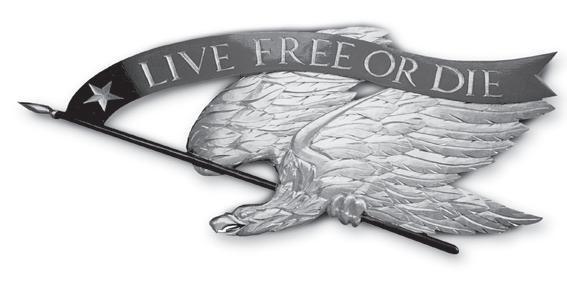
Below decks, work has also continued under the supervision of Rob Stevens, master shipwright of Virginia since before the keel was laid, and Jeremy Blaiklock, who oversees vessel construction. Watertight bulkheads have been installed and crew quarters in the forecastle are taking shape. Aft, the engine is slowly coming on line with fuel tanks, controls, venting, and all the myriad things an iron topsail requires. e ultimate goal, of course, is a Coast Guard Certi cate of Inspection (COI), which will allow us to sail with passengers, trainees, and school children. We still have a long passage ahead before we get there, but we hope to have the COI in hand by summer 2023.
Along with Virginia, Maine’s First Ship oversees the Bath Freight Shed (a wonderful historic building in its own right), on the banks of the Kennebec River, where the ship is tied up. Under the direction of Lori Benson, we maintain a visitors center and use the space for demonstrations, educational programs, lectures, rental space, and other events, including a farmer’s market in the winter months.
For all of the ongoing activity, Maine’s First Ship is without doubt in a period of transition. For more than a decade now, the organization has been essentially a loose-knit group of men and women dedicated to building a wooden ship, drawn to the project by the camaraderie, the chance to learn new skills, and the opportunity to be part of this greater thing. With

the ship in the water and the bulk of the construction completed, over the next year we’ll move from the task of building a ship to operating one, with all that entails, including sta ng, programming, scheduling, and more intensive fundraising. We are on the verge of becoming an entirely di erent kind of project.
e change began most clearly with the hiring of an executive director, Kirstie Truluck, MFS’s rst full-time employee. With eyes toward how the ship will be used in the future, we are beginning to do outreach programs in the local schools, Maine Maritime Museum (just down the road a piece, as we say in Maine), and the Bath community, looking for how to best utilize Virginia going forward. It’s a brave new world, but like the colonists who built the original Virginia, we’re eager to explore.
Readers can learn more about Virginia at www.MFShip.org, visit our Facebook page, or follow us on Instagram. e Kennebec River, Virginia’ s usual home, is not a great place to be in the winter, given the strong current and massive ice ows that come sweeping down. For that reason the ship will over-winter at the town dock in nearby Wiscasset. Come spring, she’ll be back on the waterfront in Bath, where she will once again welcome visitors who wish to see her up close. I would encourage all sailing ship enthusiasts to pay us a visit, learn about this unique vessel, and, the Good Lord and the Coast Guard willing, come with us for a sail.
Jim Nelson Harpswell, Maine
6 SEA HISTORY 181, WINTER 2022–23
Virginia’s deck has been a hive of activity since her launch on 4 June 2022.
courtesy
james nelson
J.P.URANKERWOODCARVER WWW.JPUWOODCARVER.COM THETRADITION OFHANDCARVED EAGLES CONTINUES TODAY (508) 939-1447 ★ ★ ★ ★
NMHS Legacy Society
Help keep history alive!
Each one of us can make a difference. Together, we make change.
— Senator Barbara Mikulski, 2015 NMHS Distinguished Service Award recipient
Since our founding in 1963, the National Maritime Historical Society has striven to tell the stories, great and small, near and far, that make up the broad panorama of our maritime history. Over the last six decades, hundreds of thousands of readers have discovered in the pages of Sea History magazine a treasure-trove of stories that captivate, connect and enlighten us all about the vital role of our seas, rivers, lakes and bays.
Ensure our maritime history is not lost.
It is more important than ever to bring the lessons of our maritime heritage to young people tomorrow’s maritime leaders. Now you can create a legacy for the next generation of sea service men and women, underwater archaeologists and ocean conservationists, maritime librarians and museum curators, shipwrights and preservationists, marine artists and musicians, ocean racers and tugboat captains, history teachers and writers.
Making a legacy gift to the Society is a deeply personal and transformative way to support our lifelong work, helping us to prepare for the future while bolstering the work we do now for our maritime heritage.
Including the National Maritime Historical Society in your will or living trust is one of the most effective ways to provide for the Society’s future while retaining assets during your lifetime. No matter the size of your gift, you’ll be playing an important role in preserving our shared maritime heritage and inspiring future generations.
Please email plannedgiving@seahistory.org, or call us at (914) 737-7878 Ext. 0 for more information.

Have you already made a legacy gift?
We hope you will notify us when you have included us in your future planning so that we may thank you and welcome you as a new member of our NMHS Legacy Society.
SEA HISTORY 181, WINTER 2022–23 7
NOAA divers explore the shipwreck of the Schurz. Photo: Tane Casserley/NOAA.
NMHS: A CAUSE IN MOTION
A Celebration of Our Maritime Heritage & the Contemporary Maritime Community— e 2022 National Maritime Historical Society Annual Awards Dinner
e National Maritime Historical Society is grateful for our esteemed honorees, presenters, dinner committee members, trustees, and guests for enriching this year’s Annual Awards Dinner with their incredible insight and experience, generous support, and for giving us moments of laughter, admiration, and re ection.
It was heartwarming to be able to meet in person again at the historic New York Yacht Club for the rst time since 2019, when we honored Matt Brooks and Pam Rorke Levy for their restoration of the 1929 Olin Stephens-designed Dorade and returning her to blue water racing. Our dinner chairs were joined by nearly 200 guests from diverse maritime elds—a wide-ranging group of dedicated leaders exemplifying the strength and vitality of the maritime heritage community today. We were gathered to honor the extraordinary accomplishments of RADM Joseph Callo, USN (Ret.), CAPT Sally McElwreath Callo, USN (Ret.), Steven P. Kalil, and omas A. Whidden.

As Pam Rorke Levy poignantly remarked from the podium, “Innovators today are the people who are making history, and the four people we’re honoring here tonight certainly demonstrate that not only are they a part of our history, but that even today they are still innovating and changing the way we all sail and appreciate and enjoy and bene t from our relationship with the seas.”
NMHS chairman CAPT James A. Noone, USN (Ret.) paid tribute to the remarkable work of our president emeritus Burchenal Green, “who has been the heart of the Society since joining it over a quarter century ago.”
Before taking to the podium to fête this year’s honorees, dinner chairs Pam Rorke Levy and Matt Brooks (center) pause for a photo with master of ceremonies Richard du Moulin (right), America’s ambassador of sailing Gary Jobson (left), and NMHS Distinguished Service Award recipient omas Whidden (second from right).

Our awardees were pro led in videos produced by NMHS vice chairman Richardo R. Lopes and his son Alessandro Lopes of Voyage Digital Media. Erik K. Olstein, former president of the Board of the American Friends of the National Museum of the Royal Navy and former NMHS trustee, presented RADM Joseph Callo, USN (Ret.) and CAPT Sally McElwreath Callo, USN (Ret.) with the NMHS David A. O’Neil Sheet Anchor Award in recognition of their important work as NMHS global ambassadors and on behalf of the naval and maritime heritage communities. Introducing the Callos, Olstein said “ ey are the epitome of excellence, grace and humility… and the personi cation of sel ess service.”
Erik Olstein (left) presents the David A. O’Neil Sheet Anchor Award to CAPT Sally McElwreath Callo and RADM Joseph Callo.
8 SEA HISTORY 181, WINTER 2022–23
photos by allison lucas
In perhaps one of the most charming moments of the evening, RADM Callo focused his remarks on “my sailing companion, Sally. She’s not only my buddy, but she’s my true partner… there could not be a better partner in a boat.” CAPT McElwreath Callo added “that it is truly amazing to be rewarded for doing things that you really love to do, and it’s been a very interesting journey.”
Capt. Jonathan Boulware, president and CEO of South Street Seaport Museum, presented Steven P. Kalil with the NMHS Distinguished Service Award in recognition of his outstanding expertise, commitment, and vision that have helped steer Caddell Dry Dock to great success. “ e phrase ‘maritime heritage’ runs through the evening here,” he said. “I don’t know how many people have had the privilege of being at Caddell Dry Dock, but it is a place that typi es that exact thing. But we’re also in the company of contemporary maritime, which will be maritime heritage as it ages. It is a continuum.”
Ever modest and gracious, Steve Kalil shared his initial reluctance to accept the Society’s Distinguished Service Award, stating “I really don’t belong here”—we couldn’t have disagreed more. Under Kalil’s leadership, Caddell Dry Dock has continued the maritime traditions of an exceptional shipyard business founded in 1903, constructing and servicing thousands of vessels, and working on some of our most signi cant historic ships. “I really thought it was going to be a summer job,” he said, “but it wasn’t, and here I am, 47 ½ years later, and who knows when I’ll nish. I love this job.”

We saw a glimpse of the long-standing friendship between master of ceremonies and NMHS overseer Richard T. du Moulin and America’s ambassador of sailing Gary Jobson: “You might have noticed Gary trying to get up to the podium before me,” said du Moulin. “Gary, Tom Whidden, and I have been racing against each other and with each other for our whole sailing lives, and Gary, I’m supposed to go before you because I’m introducing you.”
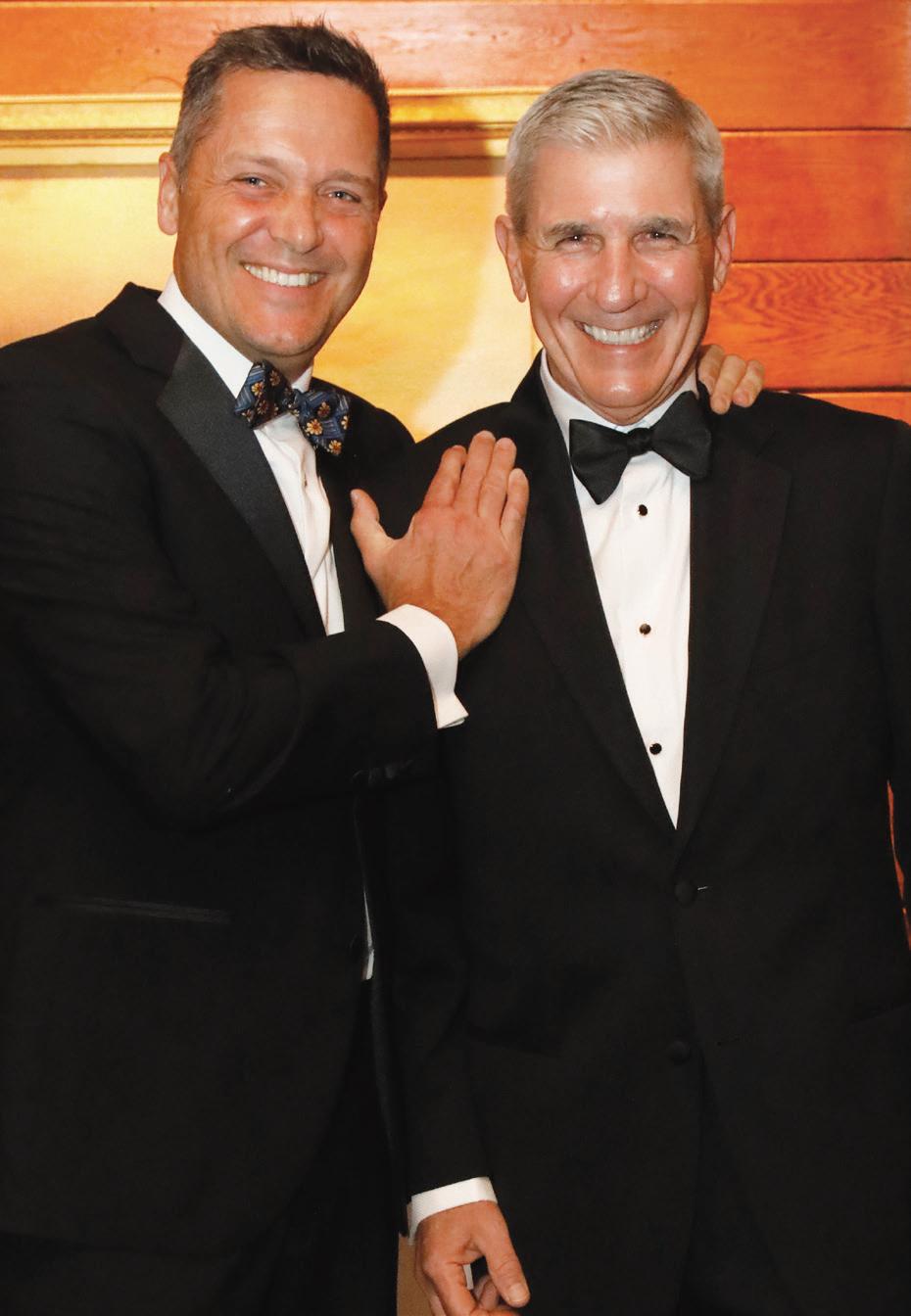
Jobson then introduced omas A. Whidden, presenting him with the NMHS Distinguished Service Award in recognition of his outstanding contributions to yachting, for his unparalleled leadership in the design and manufacture of technologically advanced sails, and for encouraging younger generations to value and participate in the sport. Jobson said: “Tom was on winning boats and he’ll tell you he was on losing boats too. And sometimes I think you learn more when you lose than when you win. It’s a great testament to how when things go bad, don’t give up. Tom came back and went on to an even greater high.”
Tom Whidden told us: “It has always been amazing to me to be recognized for the only thing I really ever wanted to do with my life.” Of NMHS, he said “our missions are quite comparable. We both live to promote the maritime heritage community and to share in the sport of sailing and more generally enjoying the sea, whether it be racing, sailing or cruising, making a living on or o the water or around the sea, or just appreciating the deep history that the maritime community enjoys.” He added, “I did okay for a guy with a full-time summer job.”
—Jessica MacFarlane NMHS Executive Director
e vocal talents of the US Coast Guard Academy Cadet Chorale, directed by Director of Cadet Vocal Music Daniel McDavitt, are always a highlight of the NMHS Annual Awards Dinner.
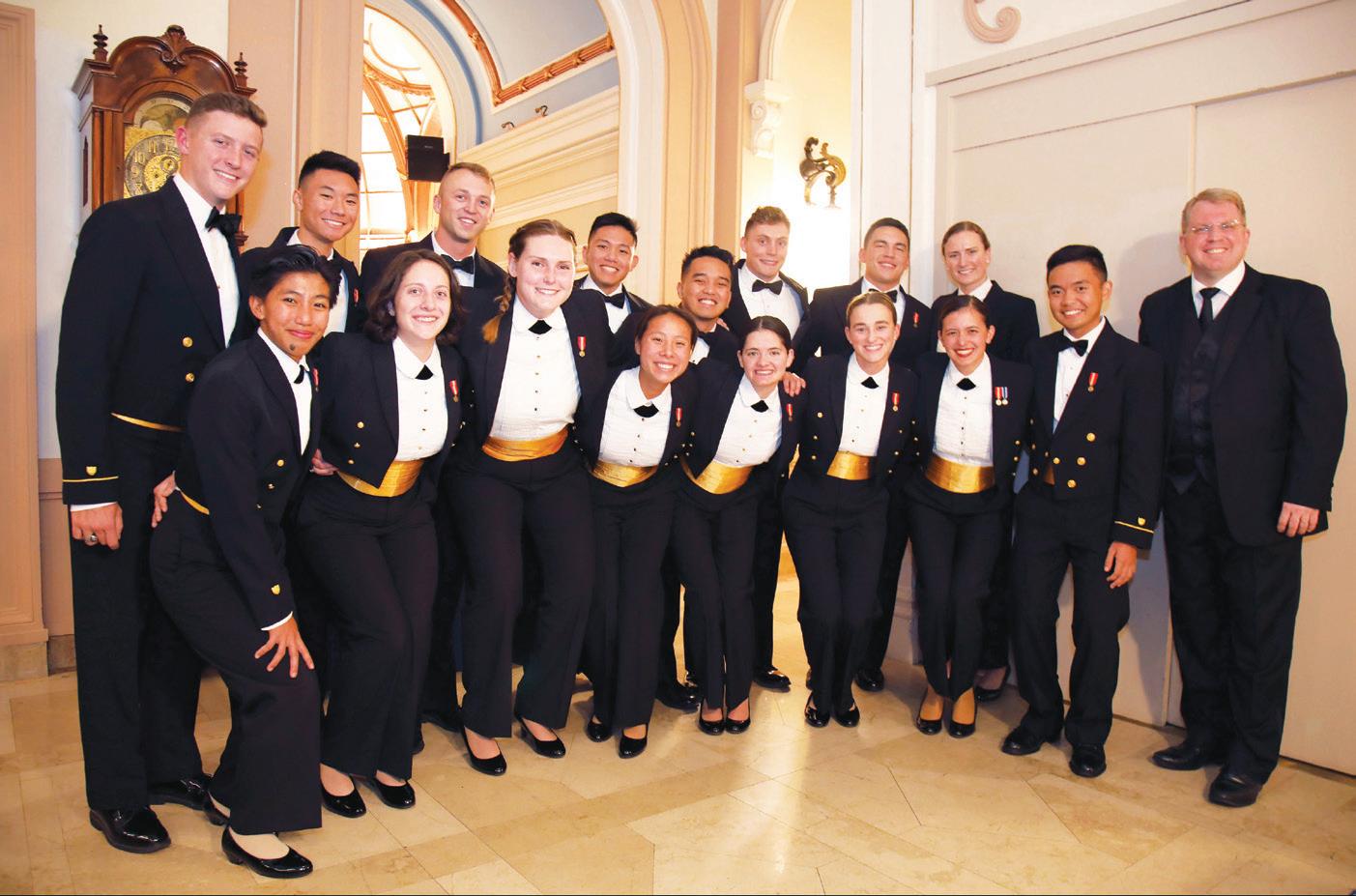
SEA HISTORY 181, WINTER 2022–23 9
Jonathan Boulware (left) had the honor of presenting Steven Kalil with the NMHS Distinguished Service Award.
Submarine Warfare and the Decline of Sailing Fleets, 1914–1918
by Steven Woods
Large sailing ships were still viable into the 1930s. is 1933 photo was shot by Alan Villiers from the deck of the Flying P Liner Parma and shows the barquentine Mozart (left) underway, with the barque Penang at anchor. e Penang was still sailing commercially until 8 December 1940, when she was torpedoed by U-140 northwest of Tory Island, o the west coast of Ireland. Penang capsized after the hit and sank.
Conventional wisdom holds that the early 20th century saw the end of working sail, what is now termed “sail freight,” on transoceanic routes because windjammers lost the technological race around this time. Under close examination, however, we discover this conclusion doesn’t hold up. Not until 1900 did the steam tonnage of the American eet exceed sailing tonnage, with Europe passing this mark only eleven years before.1 Sailing cargo vessels were still being built worldwide, employed extensively in the nitrates and collier trades, as well as lumber and grain.2 On some routes, sail freighters could out-perform steamers in both speed and cost, meaning the technoeconomical advantage was not entirely in favor of fossil-fueled vessels.3 Windjammers were still being ordered and built into the 1920s, both in Maine and Europe.4
Competition from the diesel-cycle marine engine was relatively minor until 1920–40, when it became more fuel and space-e cient than steam turbines. It was predicted in December of 1920 that advanced windjammer designs would remain pro table for many years to come.5 Longdistance routes were still economically viable for windjammers into the 1940s, with new motor-sailing vessels being built through the 1920s.6 With many sailing
ships having a service life of 25–50 years, and nearly 50% of global tonnage under sail in 1900, one would expect retirement by attrition to be a slow process lasting into the 1960s and 1970s. Instead, a rapid decline in the use of sail freighters for transAtlantic trade was seen in the rst quarter of the 20th century.
In 1914, the First World War broke out across Europe and its global empires and rapidly intensi ed into the rst truly mechanized war. is con ict was not limited to land, of course, as the submarine made its debut during this era. German U-boats became legendary for their devastating e ects on international shipping, especially during the periods of unrestricted submarine warfare. It was this outside force that was responsible for greatly reducing the transoceanic windjammer eet.
Sailing ships were especially vulnerable to submarine attack, as they were unable to make rapid course changes to avoid torpedoes, the recommended course of action when a torpedo launch was detected. Compared to submarines, which could make sixteen knots on the surface and eight submerged,7 windjammers were relatively slow and particularly at risk when winds did not favor a high cruising speed.
When armed, windjammers had a means to deter U-boats, and some sailing
vessels actually sank their attackers. One such incident was described in the Naval Institute Proceedings in 1918: “As the German [U-boat] came within range his re was answered, the sailing vessel ring 13 shots. e chief gunner was a former petty o cer in the British Navy and he scored eight bullseyes in a space of less than two minutes.”8 Most windjammers, however, sailed unarmed. A lack of armaments to issue to merchant vessels compounded the problem: “ ere are not enough small guns loose in the world to arm every merchantman. Few if any sailing ships are armed. At any rate a gun… compels in most cases a torpedo attack. at means expenditure of torpedoes.”9
e main method of defending merchant shipping, whether under sail or steam, was the convoy system. Although adopted relatively late in the war, this system placed a screen of anti-submarine vessels around the cargo-carrying ships. It was opined that of the measures taken to reduce losses to submarines by 1918, “the most important [is] the convoy system. All ships, including sailing ships and shing craft, are convoyed. e late sinkings have been chie y of slow or isolated steamers… e sinkings are now accidental. It is like walking past a building and being hit by a falling brick.”10

10 SEA HISTORY 181, WINTER 2022–23
p d national maritime museum , uk
On 13 October 1918, the Norwegian barque Sti nder was en route between New York and Fremantle with a cargo of case oil when she was stopped at sea by U-152. e German crew ordered the crew to abandon ship in the barque’s two long boats and then sank the windjammer 1,000 miles from land. Ten of the crew made it to shore. e second boat, with the captain onboard, was lost at sea. (above left) Lloyd’s Register list of 1918–19 war losses. Sti nder is listed in the 2nd column.


ere were a number of other e orts undertaken to reduce ship casualties from U-boats. Aside from arming ships and convoys, dazzle camou age was developed by using disruptive patterns and bold colors to confuse U-boats,11 but it isn’t e ective on sailing vessels, as their sails and the wind action provide the data for torpedo targeting and course prediction. e recommendation of the O ce of Naval Intelligence was to steer an unpredictable course if sailing under 16 knots, or to rely primarily on speed if capable of exceeding this mark.12 It is very di cult for windjammers to reach 16 knots in most conditions, and even more di cult for them to alter course as frequently as was recommended, about once every 10 to 20 minutes.
e e ect of submarines on sailing vessels was bad enough that the United States banned their charter to the war zone, favoring the use of sailing vessels in the coastal and South American trades, which
was deemed considerably safer. ese policies likely preserved a signi cant amount of the American sailing eet, as had US neutrality earlier in the war. e following excerpt from the Second Annual Report of the US Shipping Board neatly summarizes the threats faced by sailing vessels crossing the Atlantic:
As early as May, 1917, the Shipping Board announced the policy of refusing charters to American sailing vessels to foreigners to go into the war zone because of the danger of destruction and because the owner would want to sell the vessel if it reached a foreign port safely rather than risk a return voyage, for which the freight rates were not so attractive.
On October 10, 1917, the Shipping Board advised… sailing
vessels bound on voyages from ports of the United States or its possessions to European or Mediterranean ports were subject to excessive war risk… allowing no sailing vessel to clear for any… European or Mediterranean port.
Sailing vessels are obviously unsuited for war zone trade, particularly as they furnish a ready source from which submarines may obtain fresh supplies. ey are, however, valuable for replacing vessels taken from the coastwise and South American trade.13
Lloyd’s casualty registers for the First World War show the tremendous loss of tonnage from both normal attrition and war-related sinkings. In 1914, the major European and US eets (Great Lakes exclusive) amounted to some 5,787 vessels
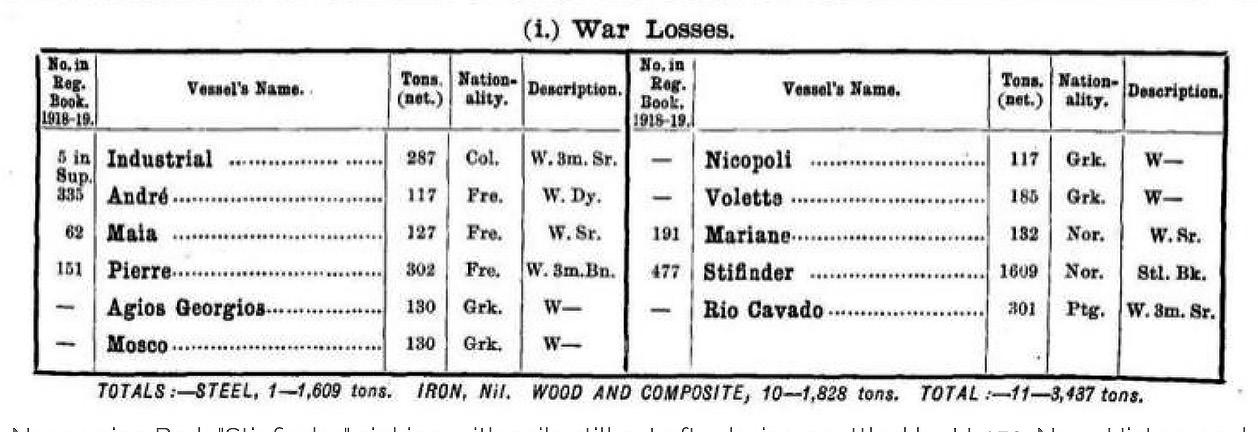
SEA HISTORY 181, WINTER 2022–23 11
stifinder photos and lloyd ’ s list courtesy naval history and heritage command (nhhc)
of 3,368,984 net tons. By 1920, when summaries were again published, the eet had declined to 4,220 vessels of 2,987,719 net tons, a 27% loss in vessels and 11% loss in tonnage. e di erence between these two numbers is 1,567, however between 1914 and 1918 some 2,049 sail freighters were lost, 977 directly attributed to war losses.14 e discrepancy is explained by the fact that at least 482 new sailing vessels of over 100 net tons were built or purchased into these major eets during the war.
By 1919 Russia’s windjammer eet was at 17.6% of its pre-war strength, while neutral Norway was at 33.8%. e only eets to have made a gain were those of Spain, which started out with 58 ships and ended the war with 148 (255% of pre-war strength), and the British colonies, which replaced Atlantic windjammers with steamers from elsewhere.
More than 1.3 million net tons of windjammer capacity were lost during the war, 3.4 times the di erence between the
pre- and post-war listed tonnages for the major powers. Tonnage losses listed in Lloyd’s Register of Shipping were 51.4% “war related,” with 47.7% of vessels lost— meaning above-average sized ships were being sunk. From 1909 to 1914, the sailing eet declined some 26.5%, while during the war it declined by 27.1% in vessels. It should be noted that the above 482 new vessels brought into these eets are not included here: a corrected vessel decline rate is 35.4%, nearly 9% more than the pre-war era. Wartime attrition was 134% of the peacetime rate.
ese numbers only consider vessels over 100 tons, but many smaller vessels were also targeted. Small coasters, trawlers and other commercial vessels were frequently subjected to U-boat deck guns. As they carried little more than small arms, their crews o ered no real resistance to this new type of warship. Small vessel losses would not appear in the Lloyd’s Register, but news reached the New England coast.

Four men landed in a dory at Cape Porpoise today reporting that their shing schooner the Robert and Richard of Gloucester had been sunk by a German submarine on Cashe Bank… e submarine, the men stated, came out of the water a few hundred yards distant and sent a shell across their bow. The crew promptly swung the schooner up into the wind and took to their boats. en the raider sent a boat aboard the schooner, apparently took only her papers, placed a bomb and left her. A few minutes later an explosion sent the trim little knockabout to the bottom.15
e Robert and Richard appears in the List of Merchant Vessels of e United States in 1917 at 89 net tons, below the Lloyd’s Register threshold. She was built at Essex, Massachusetts, in 1915,16 and was torpedoed with no loss of life on 22 July 1918.17
ere are three pages listing sailing vessels lost that year, six listed as “submarined,” with only one fatality. Twenty-nine of the vessels lost were under the threshold for inclusion in Lloyd’s Register at 100 net tons.18 In the 1918 volume of the same publication, 158 sailing vessels are reported lost, with a total tonnage of 106,566, and 173 lives lost; 34 are attributed to “war loss.”19
Estimating casualties from this period is di cult, as Lloyd’s casualty returns do not list fatalities. On the high seas, most crews from targeted vessels could not be put ashore and were unlikely to be rescued; coastal sailors were frequently put in their small boats su ciently close to shore to survive. is case o the Canadian coast in 1918 is typical: “
e Hollett after being robbed was sunk… e schooner was built in 1917... Search was continued by government vessels today for the German submarine which since Friday has destroyed six sailing ships and the Standard Oil tanker Luc Blanca… [Except for two of the tanker’s crew] all hands reached shore safely.20
12 SEA HISTORY 181, WINTER 2022–23
popular mechanics , vol . 3 0 , iss . 4 . ( oct . 1 9 1 8 )
A 1918 Popular Mechanics article featured these photos of the damage a windjammer su ered from an attack from a German U-boat in the Atlantic.
Mariners attacked in the English Channel were generally let go. is was a prudent move on the part of U-boat captains, as it allowed them to both save ammunition and resupply from the ships they stopped and boarded.21
In some cases, crews were taken onboard the submarine until they could be sent ashore, which seems to have been the norm during raids along the US Eastern Seaboard in 1917–18. Many of the vessels sunk in these operations, such as the schooner Edna, are not listed as “submarined” or even “lost” in the list of US merchant vessels, meaning any registry-based research on this topic will result in an undercounting of the real toll of submarine warfare.22
As the world once again considers moving freight under sail as a viable option to move cargo in a carbon-constrained future, research on the practicalities and efciencies of sail freight are paired with historical research on its decline. 23 e e ects of the First World War and submarine warfare in accelerating the decline of sail freight have not been well researched, despite their clear and lasting impact. Sail was already in a slow decline, but the increase of attrition and the predominance of steam and diesel propulsion in newly built ships for higher survivability meant little was left of the transoceanic windjammer eet after the war. is non-econom-
NOTES
1 Marine Review Publishing Co., Blue Book of American Shipping, 5th ed. (Cleveland: Marine Review, 1900). 4.
2 Ralph Linwood Snow and Capt. Douglas K Lee, A Shipyard in Maine: Percy and Small and the Great Schooners (Bath: Maine Maritime Museum, 1999).
3 Felix Riesenberg, Standard Seamanship for e Merchant Service 2nd ed. (New York: D. Van Norstrand, 1936).
4 Snow and Lee, A Shipyard in Maine
5 C. O. Liljegren, “Coal Oil or Wind?” Transactions of the Institution of Engineers And Shipbuilders In Scotland, Vol 64, 1920. 242–309.
6 Riesenberg, Standard Seamanship for e Merchant Service.
7 O ce of Naval Intelligence, Analysis of the Advantage of Speed and Changes of Course in Avoiding Attack by Submarine, ONI Publication No. 30. (Washington, DC: Government Printing O ce, 1918).
8 US Naval Institute Proceedings 44. (Annapolis:
Receipt given to the master of the American schooner Hauppauge by Korvettenkapitän Nostitz, 25 May 1918. e German commander brought the schooner’s crew onboard the U-boat so that their presence o the East Coast would not be detected. e crew was kept onboard for 8 days before being put into the schooner’s lifeboats (which were being towed by the U-boat), from which they were later rescued by an American steamship. e attempt to scuttle the Hauppauge failed and the schooner was later salvaged.

ic pressure needs to be understood when looking at the decline of sail freight in the Atlantic World.
It should also be noted that sail freight, while diminished, never completely stopped. Coastal sailing eets survived in Ireland and Australia into the 1960s and 1970s, while sail freight has endured in many small island states of the South Paci c.24 ose interested in learning more about sail freight should visit the Hudson River Maritime Museum’s exhibition,
US Naval Institute, 1918, 1144).
9 Henry Reuterdahl, “War Invisible” Saturday Evening Post, 189:48. (Philadelphia: Curtis Publishing Co., 1917. 67).
10 US Naval Institute Proceedings 44. 2183.
11 Waldemar Kaemp ert, “Fighting the U-boat With Paint” Popular Science Monthly 94:4 April 1919.
12 ONI, Analysis of the Advantage of Speed and Changes of Course in Avoiding Attack by Submarine
13 US Shipping Board, Second Annual Report of the United States Shipping Board ( Washington, DC: Government Printing O ce, 1918).
14 Lloyd’s Register of Shipping: Returns of Shipping Totally Lost, Condemned, etc. (London: Lloyd’s, 1914–1920).
15 US Naval Institute Proceedings 44. 2198.
16 US Bureau of Navigation, List of Merchant Vessels of the United States 49th ed. (Washington, DC: Government Printing O ce, 1917. 59).
17 US Bureau of Navigation, List of Merchant
A New Age Of Sail: e History And Future Of Sail Freight On e Hudson River on view at the museum and online through 2024. (www.hrmm.org)
Steven Woods is the Solaris and Education coordinator at the Hudson River Maritime Museum. He earned his master’s degree in Resilient and Sustainable Communities at Prescott College, where he wrote his thesis on the revival of sail freight for supplying the New York metro area’s food needs.
Vessels of the United States 51st ed. (Washington, DC: Government Printing O ce, 1920. 448).
18 US Bureau of Navigation, List of Merchant Vessels of the United States 49th ed. 59.
19 US Bureau of Navigation, List of Merchant Vessels of the United States 50th ed. (Washington, DC: Government Printing O ce, 1918).
20 US Naval Institute Proceedings, 44. 2203.
21 US Naval Institute Proceedings, 44. 2202.
22 O ce of Naval Records and Library, German submarine activities on the Atlantic Coast of the United States and Canada (Washington: Government Printing O ce, 1920).
23 Steven Woods and Sam Merrett, “Operation of a sail freighter on the Hudson River: Schooner Apollonia in 2021,” Journal of Merchant Ship Wind Energy, 2 Mar 2021.
24 Richard J. Scott, e Galway Hookers: Working Sailboats of Galway Bay (Boyle: Ward River Press, 1996). Rick Bullers, “Annie Watt: e Career of a Coastal Trading Ketch,” e Great Circle 36, no. 1 (2014), 8-32.

SEA HISTORY 181, WINTER
13
2022–23
naval history and heritage command ( nhhc )
Marked for Disaster
The Tragic Loss and Inspiring Legacy of the 1554
by Amy Borgens
Cramped in close quarters, the deafening sound of the heavy wind and waves only heightened the anxiety of the passengers and crew as the four ships moved perilously close to shore. e decision to sail closer to the mainland had been risky, perhaps intending to capitalize on the faster coastal currents to make up time lost at sea. e ships— San Esteban, Espíritu Santo, Santa María de Yciar, and San Andres —were already twenty days into a voyage that often just took twelve. ey had departed San Juan de Ulúa, o Veracruz (present-day Mexico), on 9 April, bound for Spain by way of Havana, Cuba. Unable to prevail in their e orts against an unexpected storm, three of the ships ran aground at Padre Island, present-day Texas, on 29

April 1554, with a precious cargo in silver, cochineal, and other goods intended for Spain. e loss of life was stunning—an estimated 300 individuals perished, and news of the tragedy e ected an immediate response from Spanish o cials in Mexico City to search for survivors and salvage the cargo.
For more than 400 years this story would be lost to history, save for the occasional silver coins that wash ashore, particularly after storms, fueling the local lore of treasure lost at sea. e accidental discovery of this forgotten eet in 1964, and its later salvage in 1967, would culminate in a landmark lawsuit, the passage of Texas’ antiquities law, and the state-funded and state-led excavation of San Esteban e archaeological investigation under-
taken by the Texas Antiquities Committee (TAC)—predecessor to the Texas Historical Commission (THC)—beginning in 1972 is believed to be the rst scienti c excavation of a shipwreck in the United States. During the second year of eldwork in 1973, the TAC partnered with the University of Texas (UT) to conduct an archaeology eld school, possibly the rst program of its type in US waters. With the 50th anniversary of the investigations in 2022, the importance of the 1554 eet cannot be understated for its contribution to the emerging eld of underwater archaeology. In the years that have passed since its discovery in 1964, these shipwrecks remain the oldest excavated wreck sites in the United States and the Gulf of Mexico.
14 SEA HISTORY 181, WINTER 2022–23
(top) Shipwreck: San Esteban Survivors Land on the Texas Coast by Peter Rindlisbacher, 2022. Mural for the Texas Maritime Museum.
Spanish Plate Fleet of Padre Island, Texas
Under the protection of a six-ship armada, the ill-fated San Esteban, Espíritu Santo, and Santa María de Yciar departed Sanlúcar de Barrameda, Spain, in November 1552, as part of a 54-ship otilla led by Captain-General Bartolomé Carreño. ese vessels comprised the regularly scheduled commercial eets that carried goods between Spain and its American colonies, including invaluable raw materials from New Spain—in particular, silver and cochineal. After experiencing severe losses in men and ships during their Atlantic crossing, the surviving 29 vessels diverged once they entered the Caribbean Sea. Sixteen sailed for San Juan de Ulúa, o Veracruz (New Spain), and the remaining ships set a course for Cartegena, in accordance

Plate Ships in the Rising Wind
 by Peter Rindlisbacher, 2022
by Peter Rindlisbacher, 2022
SEA HISTORY 181,
15
WINTER 2022–23
art by peter rindlisbacher
art
by peter rindlisbacher
with their original plan. e ships heading to Veracruz arrived in February and March 1553. At that time, the region was still recovering from an autumn 1552 hurricane, which delayed the unloading of the larger ships. ese challenges caused the vessels to miss the scheduled rendezvous with Carreño in Havana, and they remained in port to await the next convoy.
Finally, a rendezvous was arranged with an incoming eet commanded by Captain-General Cosme Rodríguez Farfán. After more than a year’s wait, they would accompany Farfán’s eet to Havana and then onwards to Spain. Sentiments changed, however, and it was decided they would depart alone to take advantage of favorable weather and sailing conditions.
e four-vessel otilla departed on 9 April, three weeks before any vessels of Farfán’s eet arrived at San Juan de Ulúa on 1 May. is change in plans would, of course, prove to be their undoing. e ships were still underway in the Gulf of Mexico heading for Havana, when a violent storm
ultimately drove them ashore along the barrier island. Only San Andres made it to Havana, but in too-damaged a condition to continue its voyage.
Conditions for the survivors at Padre Island were stark and unrelenting. A small group, led by Francisco del Huerto, master of San Esteban, rigged a small boat and sailed south to Veracruz to get help, arriving in May. A second group of approximately thirty survivors ultimately decided to march overland to Pánuco, near Mexico City, believing it to be a two- or three-day journey; it was, in fact, more than 500 miles. ey built a raft to cross the Rio Grande River and proceeded southwards, all the while being attacked by local indigenous tribes. Believing the attackers’ interest was solely aimed at material goods, such as their clothing, the survivors hesitantly surrendered them. With few possessions and nearly naked, they continued walking, but all were ultimately killed, except Fray Marcos Mena and the soldier Francisco Vásquez, who had earlier abandoned the
trek and returned to Padre Island. Mena’s survival was miraculous, as he had been wounded and partially buried, assumed by his comrades to be near death after being struck by arrows. With rest he was able dig himself out and continued on alone, wandering aimlessly in a dire condition. He was discovered by Indians at the Pánuco River, who helped him to Tampico. From there he traveled to Pánuco, where he recuperated from his injuries before continuing onward to Mexico City. News of the loss of the ships had already reached Spanish o cials, and a salvage expedition had been dispatched. It is Mena’s story, recounted to Fray Agustín Dávila Padilla thirty years later and published in 1596, that survives as the only rst-hand account of the tragedy.
Spanish o cials at Mexico City arranged for salvage of the vessels, valued then at more than 1.5 million pesos (worth more than 50 million USD today), rst sending troops overland in June to reconnoiter the coast and search for survivors.
In this detail of an early 18th-century Herman Moll map, the cartographer included the route that Spanish ships typically followed when sailing from Veracruz to Spain (with a stop at Havana) across the Gulf of Mexico. “ e Tract of ye only Passage of ye Flota from Vera Cruz to ye Havana occasioned by the Trade winds.” It is believed that the 1554 Spanish Plate Fleet ships were sailing closer to shore, far west of the traditional route, when the weather turned foul.

16 SEA HISTORY 181, WINTER 2022–23
map of the west indies , mexico or new spain , publ by bowles , london , 1736 david rumsey map collection
e commander of the land expedition, Ángel de Villafañe, arrived at Pánuco and organized a small-scale salvage e ort of San Esteban using a diver he retained from Veracruz. e recovered objects were then shipped overland from Pánuco to Mexico City, arriving safely at their destination on 30 July, by which time the salvage expedition of the ships and cargo, commanded by Captain García de Escalante Alvarado, had already commenced. Alvarado’s squadron of six vessels anchored o Padre Island on 22 July and set up camp onshore. e wreckage of Santa María de Yciar and Espíritu Santo was no longer visible from the surface. As a means to rediscover the shipwrecks, the salvage crews rigged a cable slung between two shallops as a dragline Divers worked to recover materials from the wrecks, which were carefully weighed and inventoried—a process that was completed on 12 September. In total, Spain salvaged less than half the collective cargo from the three shipwrecks, and a rather extensive political dispute ensued regarding the nal disposition of this wealth. In the years since, this tragedy was largely forgotten, albeit piquing interest on occasion when coins would emerge on the beach, adding to the already extensive mythos of mysterious shoreline treasures that abound in the region.

For Vida Lee Connor, the August of 1964 may have begun typically for that time of year, without any premonition of
how the end of summer would unfold. Connor was part of a voluntary exploration group working with noted oceanographer Harold Geis to help map o shore reefs. She discovered several reefs o Mans eld Cut, now believed to comprise portions of Sebree, Steamer, and Seven and One-Half Fathoms Reefs. An outdoors enthusiast and adventurer, known locally as a trophy
sher and avid sailor, Connor often entertained guests aboard a 42-foot power yacht named for her—Vida Lee III. She also had access to a private plane. During an aerial visual reconnaissance for reefs in 1964, Connor observed a “dark patch” in the water and later dived it. She observed sixteen underwater features, which at the time she misunderstood to represent sixteen unique shipwrecks. ese were, in fact, the disarticulated, concreted remains of the 1554 Spanish Plate Fleet.
In the spring of 1965, Connor cosponsored a student on a research trip to visit Spanish archives, during which the Padilla account was successfully located. In 1966 Connor announced her discovery to regional newspapers, including the location of the shipwrecks, their identity, and that she had marked the sites with buoys. She hoped to encourage other divers and specialists to validate her discovery, but on a subsequent return to the sites, she encountered a professional salvage expedition “draglining” one of the shipwrecks and removing artifacts. is unexpected event

SEA HISTORY 181, WINTER 2022–23 17 author
s collection
Plate Ships Driven by the Gale by Peter Rindlisbacher, 2022.
art by peter rindlisbacher
Vida Lee Connor and Harold Geis, press photo, Houston Chronicle , 2 October 1966.
brought Connor’s investigations of the shipwrecks to a close but opened the next complicated chapter in this story—one that exposed inadequacies in the state’s ability to protect its archaeological heritage on state property.
In the 1960s underwater archaeology was a new discipline pioneered by the graduate work of George Bass at the Late Bronze Age Cape Gelidonya shipwreck in Turkey, while a student at the University of Pennsylvania. At the time of the Texas discovery and salvage in the mid-1960s, the protection of submerged cultural resources was not directly addressed by existing Texas and federal laws. In Texas, for example, one needed to seek approval from a landowner or county commissioner for permission to search for an archaeological
Archaeologists recover a huge anchor from the wreck site, 1973.

site on private property or public land, respectively, but ownership, management authority, archaeological permitting, curation, reporting, and other now commonplace processes were not directly de ned or described.
In 1967, the Texas General Land O ce (GLO)—the state land manager— led an injunction against Platoro Limited, Inc., halting salvage by citing the Indiana-based company’s failure to obtain a permit to work within Texas, a requirement for out-of-state entities. us began a contentious lawsuit between the state and the salvors that would last 17 years. In 1984, Texas was awarded ownership of the collection. A bill was introduced in 1967 to create a state antiquities law. It was not enacted by the close of the legislative session and was reintroduced in the 41st Legislative Session of 1969, passing during a special session. e Antiquities Code of Texas (ACT; Natural Resource Code Title 9, Chapter 191) established protections for historic buildings, structures, archaeology (including shipwrecks), and other cultural heritage on state public lands, and introduced processes for protecting cultural resources in advance
State Marine Archeologist and Project Director Carl Clausen (right) and Assistant Project Director J. Barto Arnold (left) during excavations of San Esteban in 1973.

18 SEA HISTORY 181, WINTER 2022–23
texas historical commission
texas historical commission
of construction projects and the designation of state antiquities landmarks. e TAC, since merged with the THC, was created as the management authority for state cultural heritage on public lands with regulatory responsibilities for conducting project reviews on behalf of federal and state laws to ensure protection of cultural resources in advance of development activities. As part of these duties, the THC requests archaeological surveys, issues antiquities permits, and reviews technical reports summarizing investigative ndings.
After the enactment of the ACT, archaeological work would recommence on the 1554 Spanish Plate Fleet, now under the auspices of the THC. It was a priority to excavate, record, and remove the rest of the ship remains and their artifacts so that they could be conserved for posterity and stored in a protective environment. Failure to do so risked continued unsanctioned activity on the shipwrecks and theft and damage to the sites. In 1969, state archaeologist Curtis Tunnell and Dr. George Fischer of the National Park Service (NPS) visually inspected the beach at Padre Island National Seashore seeking secondary artifact deposits (coins, for example) that might indicate the vessels’ o shore locations. is endeavor, however, did not detect any cultural material and the agency proceeded to coordinate with Southern Methodist University (SMU) to arrange for a remote-sensing survey to locate the wreck sites. SMU was part of a larger partnership of experts and specialists assisting the THC, including the NPS, UT, Texas A&M University (TAMU), Texas Tech
Astrolabes, coins, and other artifacts from the 1554 Spanish Plate Fleet shipwrecks.

University, and the GLO. An antiquities permit—the rst for an underwater archaeological investigation in Texas—was issued to the Institute of Underwater Research, helmed by SMU researchers. e eldwork in July 1970 detected numerous buried magnetic targets, but only one shipwreck, later identi ed as San Esteban, was uncovered and observed by divers.

To investigate the archaeological sites, the THC recruited Carl Clausen, the state underwater archaeologist for the Florida Division of Archives, History, and Records Management, to plan the eldwork. In 1972 he was hired as the rst state marine
archaeologist of Texas and as head of the Underwater Archeological Research Section (now known as the Marine Archeology Program). Fieldwork at San Esteban began on 15 July 1972, with UT conducting a eld school on the site in 1973. ese investigations focused on mapping and recovery of San Esteban, and in 1974 new remote-sensing surveys were conducted to relocate Espíritu Santa and Santa María de Yciar. Espíritu Santo was rediscovered, and eldwork in 1975 included recovery of additional artifacts from this wreck that had not previously been removed by Platoro, and a few objects from San Esteban.
SEA HISTORY 181, WINTER
19
2022–23
Drawing of San Esteban’s stern section.
texas historical commission texas historical commission
Very little of San Esteban’s hull remained, likely degraded over hundreds of years by teredo navalis mollusk consumption, common to the warm Gulf of Mexico waters. e archaeologists recovered an articulated section of the stern, measuring nearly sixteen feet in length. e remainder of the wreck site was characterized by an often non-contiguous assortment of artifacts and concretions. More than 5,800 artifacts were recovered from San Esteban, including artillery, munitions, anchors, silver coins and disks, potsherds, tools, spikes, and ballast. e collection from Espíritu Santo, totaling nearly 2,000 artifacts, also featured silver and gold artifacts, in addition to artillery, ballast, anchors, crossbows, and navigational tools. e artifacts from the 1554 Spanish Plate Fleet were conserved at the Texas Archeological Research Laboratory at UT, under the direction of Donny Hamilton (while a doctoral student) using new methodologies developed speci cally for fragile artifacts from a submerged saltwater environment. Hamilton’s dissertation on metal conservation would be published in 1976 as the TAC’s rst publication of its underwater archaeological series.
Under the direction of State Marine Archeologist J. Barto Arnold III, who had served as assistant project director under Carl Clausen, another investigation of Espíritu Santo occurred in 1977. e THC later partnered with the NPS in 1985–1986
to re-evaluate the sites as part of a broader e ort to examine all known archaeological sites at Padre Island National Seashore. Due to the discovery of a 16th-century anchor that had been snagged and pulled ashore at the jetties at Mans eld Cut, it has been presumed that dredging of the cut in the 1950s may have destroyed the wreck. ough numerous compliance surveys have been conducted in the area, none have discovered the elusive Santa María de Yciar, and new ongoing investigations, initiated in 2020 and led by the NPS in partnership with the THC, again seek to locate this lost vessel.
With this new work and continuing study of the artifact assemblage, the story of the loss of the 1554 Spanish Plate Fleet continues to be written. ese shipwrecks and their important cargoes are a material representation of the Spanish interest in the Americas, and the importance of the Spanish colonial enterprise that persisted for hundreds of years and nanced the power of the Spanish Empire. ey have left an undeniable legacy, not merely for the state of Texas, but for the discipline of underwater archaeology in general. is discovery and eld investigations in the 1960s and 1970s advanced the academic study of historic shipwrecks, provided a training ground for future maritime archaeological professionals, and increased awareness for this unique type of cultural resource inspiring the state’s protective
legislation to preserve this and all its cultural heritage.
You can view the artifacts and ship remains at the Corpus Christi Museum of Science and History’s main exhibit, with smaller exhibits at Treasure of the Gulf Museum (Port Isabel), John E. Conner Museum at TAMU-Kingsville, and the Bullock Texas State History Museum. Researchers interested in the collection should reach out to the Marine Archeology Program (www.thc.texas.gov/preserve/projectsand-programs/marine-archeology).

Amy Borgens is the State Marine Archeologist of the Texas Historical Commission in Austin, Texas. She is coordinator of the Marine Archeology Program in the THC’s Archeology Division.
Artillery from San Esteban (above) and other artifacts are on exhibit at the Corpus Christi Museum of Science and History.
A note on sources. e history, excavation, and conservation of the 1554 Spanish Plate Fleet are summarized in these TAC publications from the 1970s: Donny L. Hamilton, Conservation of Metal Objects from Underwater Sites: A Study in Methods (1976); Dorris L. Olds, Texas Legacy from the Gulf: A Report on the Sixteenth Century Shipwreck Materials Recovered from the Texas Tidelands (1976); John L. Davis, Treasure, People, Ships, and Dreams: A Spanish Shipwreck on the Texas Coast (1977); J. Barto Arnold III and Robert Weddle, e Nautical Archeology of Padre Island: e Spanish Shipwrecks of 1554 (1978); and David McDonald and J. Barto Arnold III, Documentary Sources for the Wreck of the New Spain Fleet of 1554 (1979). e TAC publications are hosted online: www.thc. texas.gov/preserve/archeology/1554-spanish-plate- eet. New information on the shipwrecks is featured in Amy A. Borgens, “Vida Lee Connor: Discoverer of the 1554 Spanish Plate Fleet o Padre Island,” (2022) Texas Historical Commission Blog at www. thc.texas.gov/blog/vida-lee-connor-discoverer-1554-spanish-plate- eet-padre-island and Amy A. Borgens, “ e Ill-Fated 1554 Spanish Plate of Padre Island, Texas, at the Semicentennial of the Archeological Investigations” in Plus Ultra: An Examination of Current Research in Spanish Colonial Underwater and Terrestrial Archeology in the Western Hemisphere, (pending) Springer Publishing, New York.

20 SEA HISTORY 181, WINTER 2022–23
texas historical commission

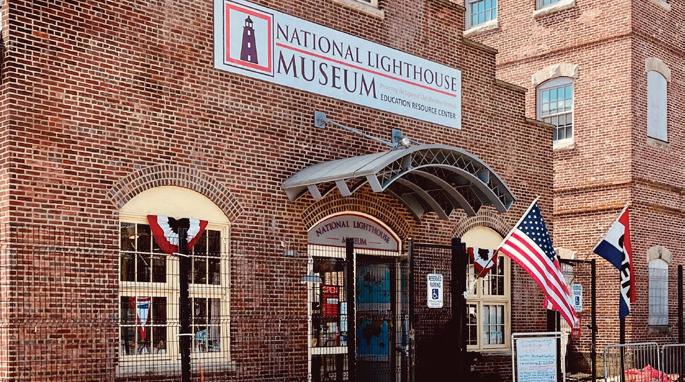


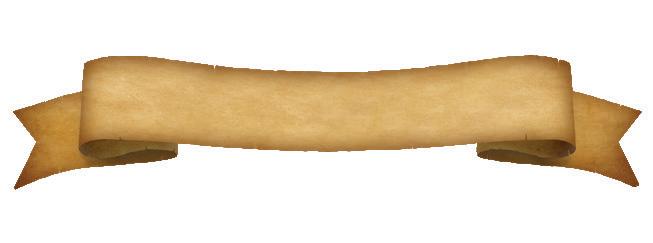
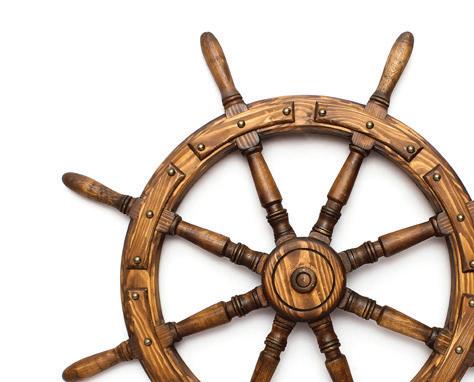



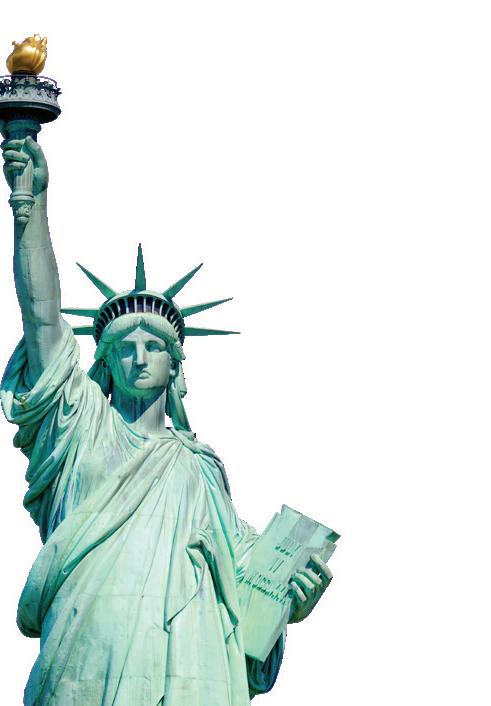
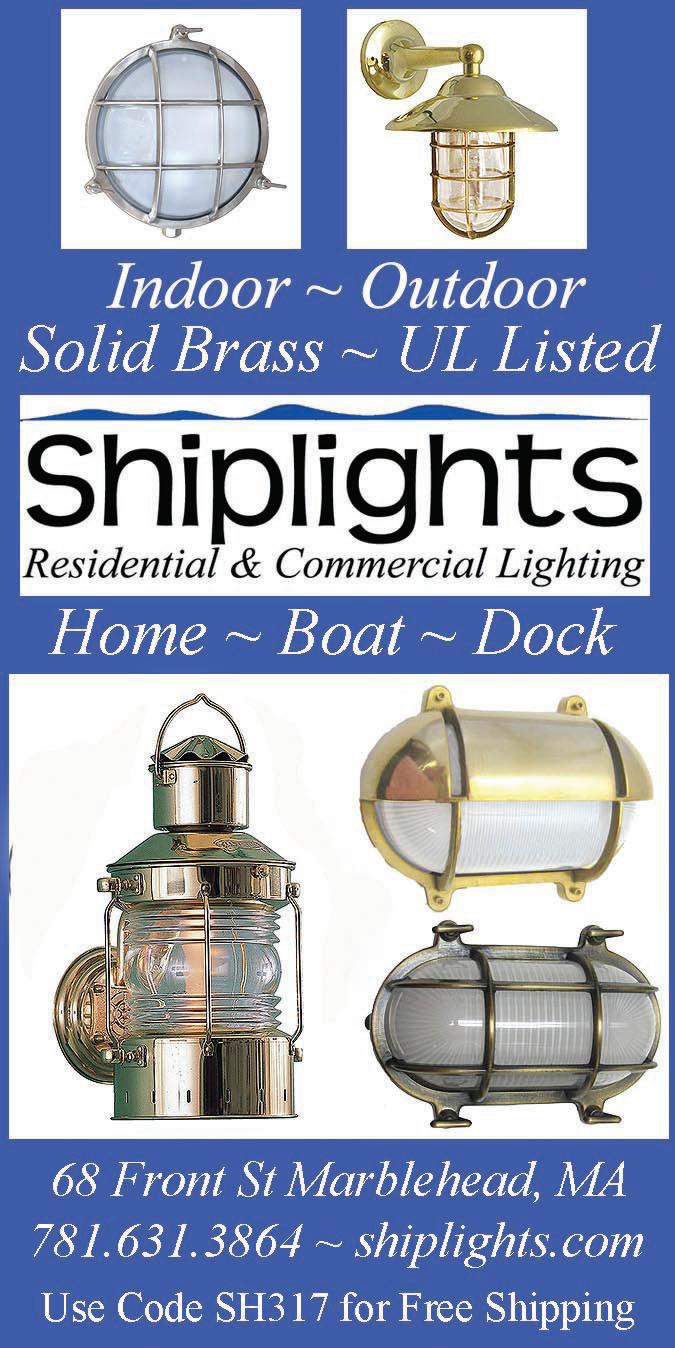

SEA HISTORY 181, WINTER 2022–23 21 e Promenade at Lighthouse Point, Staten Island, NY 10301 718-390-0040 • www.lighthousemuseum.org To preserve and educate on the maritime heritage of lighthouses, lightships and the stories of their keepers for generations to come... EVENTS INCLUDE: Lighthouse Boat Tours Museum Tours Presentations & Special Programs Lighthouse Recognition Weekend including the Annual Light Keeper’s Gala Lighthouse Point Fest featuring the Keeper’s Soup Contest K-12 Maritime Education Programs Home of the Great SI Lighthouse Hunt Contact the Museum to learn more about the
Campaign for Illuminating Future Generations.
C URATOR’S C ORNER : H ISTORIC P HOTOS FROM T H E A RCHIVES
During a tour of the Chesapeake Bay Maritime Museum last spring, Chief Curator Pete Lesher showed us some compelling photos in the museum’s collections storage area. While available to researchers upon request, these photos don’t often see the light of day, so we decided to create a series in Sea History in which curators pick a particularly interesting, revealing, or representative photo from their archives and tell us about it. In this issue we are invited into the archives of the Wisconsin Maritime Museum. Enjoy!
Frozen in Time — Dozens of skaters glide past wooden steamships locked in the ice on this winter day in 1890 at Manitowoc, Wisconsin. e scene captures a moment of suspended animation: one can almost hear the scraping of metal blades on ice, while shouts of laughter punctuate the soundscape of a bustling Lake Michigan port town. Docked in the background are three wooden vessels of the Goodrich Transit Company eet. Depicted from left to right are the steamers Indiana, City of Racine, De Pere, and Menominee, wintering over at the company’s terminal on the north bank of the Manitowoc River. e newest of these vessels is the Indiana, built locally by Burger & Burger in Manitowoc. At 220 feet in length, she was launched on Saturday, 5 April 1890, to much fanfare as the “prettiest launch ever witnessed in the city.”1 While each vessel in this image has its own colorful history to tell, it is the photographer who deserves the spotlight.

Captain Edward Carus shot this photograph, one of nearly 3,000 in the Carus Collection at the Wisconsin Maritime Museum. Born in 1860 in Manitowoc, Carus began his career on the Great Lakes sailing aboard schooners and spent many years
1Manitowoc Pilot 10 April 1890, p. 2.
2 Manitowoc Herald-Times Manitowoc, Wisconsin 10 May 1961, p. 21.
as a captain for the Goodrich Line, where he was regarded as “sincere, outspoken, frank, jovial and cordial.”2 During his career, he also researched and recorded the maritime heritage of the areas where he sailed, particularly the western shore of Lake Michigan. By the 1930s, Captain Carus found himself in nancial distress, which motivated him to sell his collection to Henry Barkhausen, who in time donated it to the museum. Captain Carus died in August 1947, following a stroke he su ered while sitting outside his home at 1209 Franklin Street in Manitowoc. e Carus house was torn down in the 1950s to make way for a Chevrolet dealership parking lot. Today, that site and the property where the captain’s former home occupied are part of the museum’s o -site collections storage facility. is facility and associated grounds will undergo major renovations in 2023. Photographs taken by Captain Carus will be incorporated into a maritime mural on the exterior of the building. e mural and interpretive signage at the site will pay tribute to the legacy of the captain as an invaluable maritime chronicler during an era when Great Lakes transportation was rapidly modernizing.
—Kevin Cullen, Deputy Director and Chief Curator Wisconsin Maritime Museum (www.wisconsinmaritime.org)

22 SEA HISTORY 181, WINTER 2022–23 wisconsin
maritime museum image id : p823700625b
THE FLEET IS IN.
Sit in the wardroom of a mighty battleship, touch a powerful torpedo on a submarine, or walk the deck of an aircraft carrier and stand where naval aviators have flown off into history. It’s all waiting for you when you visit one of the 175 ships of the Historic Naval Ships Association fleet.
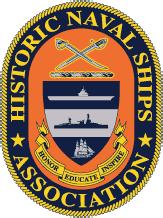
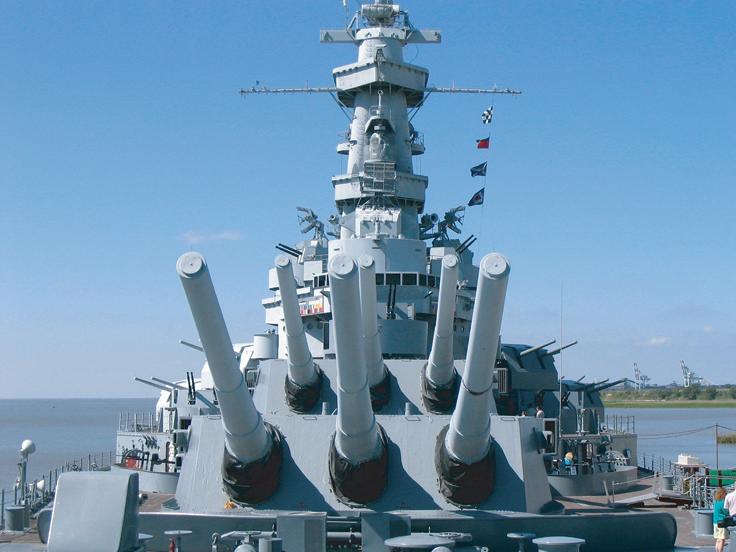
For information on all our ships and museums, see the HNSA website or visit us on Facebook.





SEA HISTORY 181, WINTER 2022–23 23 THE HISTORIC NAVAL SHIPS ASSOCIATION
www.HNSA.org
C M Y CM MY CY CMY K 2.25x4.5_HNSA_FleetCOL#1085.pdf 6/5/12 10:47:40 AM
Greenland Beckons: Explorer Louise Arner Boyd aboard the Veslekari
by Joanna Kafarowski
California native Louise Arner Boyd’s ambitious plan to sail to Greenland from northern Norway in 1928 was thwarted when she signed on to the international rescue mission to nd missing polar explorer Roald Amundsen, who had disappeared in June of that year.1 Tragically, Amundsen and his crew perished, but for Boyd the experience awakened a passion for exploring. Several years passed, and Boyd’s desire to launch
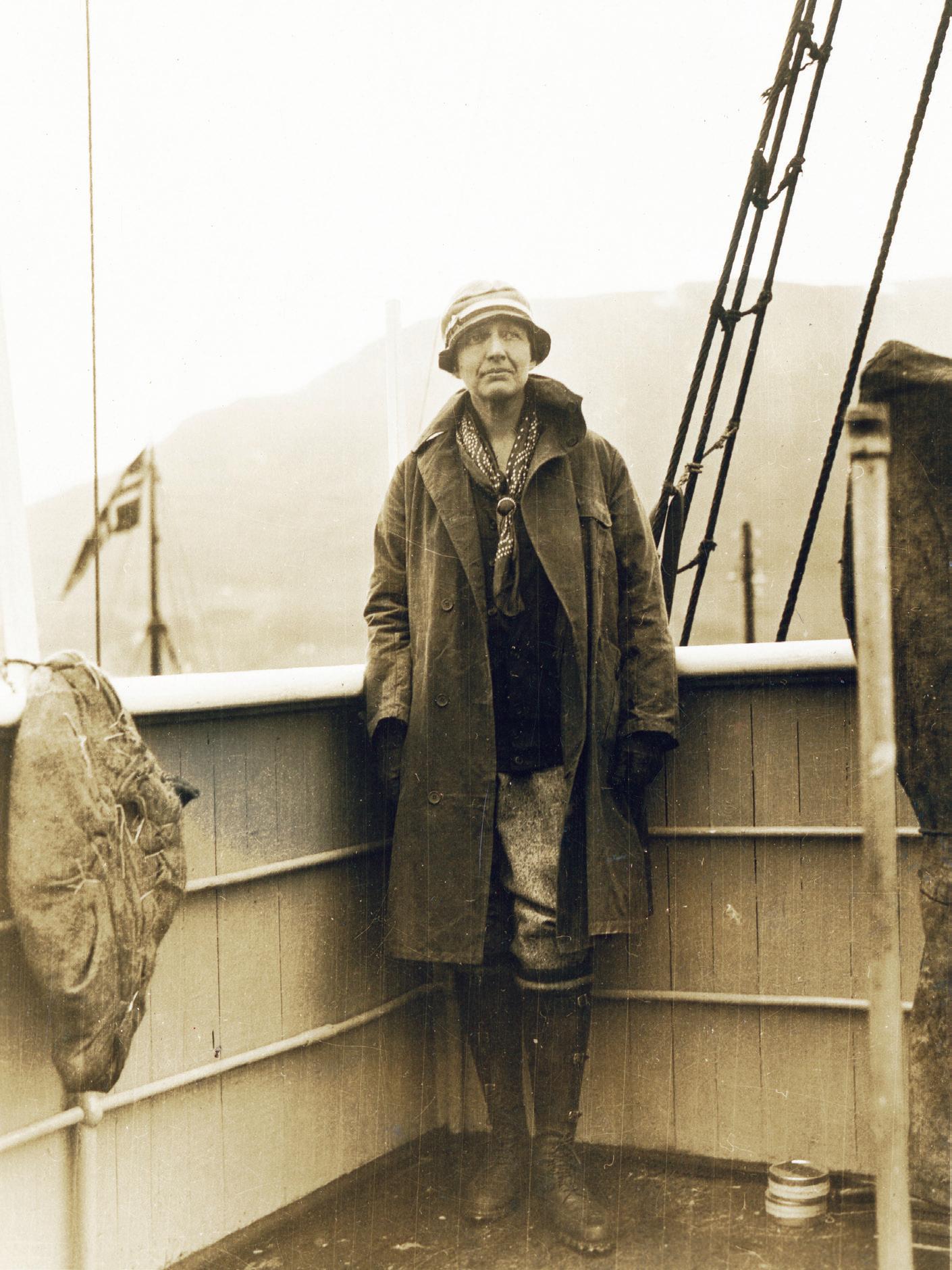
an expedition to East Greenland wasnally materializing. Her previous ship, the wooden steamship Hobby, was not available for hire. Instead, this would be the rst time she would sail in the sealer and expedition ship Veslekari, another respected Norwegian vessel. She and Veslekari (“little Kari” in Norwegian) would sail together on four successive voyages to East Greenland, Jan Mayen Land, and Svalbard, in 1931, 1933, 1937 and 1938.
roughout her long and illustrious career going to sea, Boyd developed a deep sense of connection with each of the three ships she sailed in, but Veslekari would be her favorite. ere were several available ships she could have chartered, but Veslekari’s connection to her hero Amundsen made it an easy decision. Veslekari was the sister ship of Maud —used by Amundsen during his 1918–25 transit through the Northeast Passage. ese vessels were constructed of oak, pine, and greenheart and built in Christian Jensen’s shipyard in Vollen in Asker near Kristiania (now Oslo). She had a gross tonnage of 285 and was approximately 134 feet in length and 27 feet on the beam. e vessel was ketchrigged with a maximum speed of 10 knots. Veslekari had also participated in the Amundsen rescue mission, so this new relationship boded well.
Exuberant crowds shouting “God Reise!” were on hand as Veslekari departed her home port of Ålesund, Norway, on 1 July 1931. While Captain Paul Lillenes and the rest of the local crew were familiar faces to the onlookers, few amongst the well-wishers were accustomed to seeing a woman expedition leader, and an American woman at that. Along with the sailing crew, Boyd had also invited Swedish geographer Carl-Julius Anrick and American botanist Robert Menzies. Both men brought their wives with them, although this proved to be one of the last times Boyd allowed other women aboard on her expeditions. Open con ict between Boyd and the geologist’s wife during the 1933 expedition con rmed her decision. From that point forward, Boyd was the only woman to participate in her expeditions.
Louise Boyd on the deck of her rst expedition ship, Hobby. “People openly told me the Arctic was a place only for men — that for me to go where I did was not to be taken seriously. Determination and persistence brought me to the position I achieved.”
—Louise A. Boyd
24 SEA HISTORY 181, WINTER 2022–23
marin history museum
1 Read about this chapter in Louise Boyd’s life in Sea History 177, “Searching for Amundsen: Louise Arner Boyd aboard the Hobby.
”
e ship set a northwesterly course through the turbulent Norwegian Sea to Jan Mayen Land, located halfway between Greenland and Norway. e sea state during this passage was less than favorable, and one by one the expedition scientists disappeared below deck, leaving Boyd alone on deck with the sailing crew. It was a point of pride with her that she never succumbed to seasickness. e ship lived up to her lively reputation, and a crewmember reported: “Veslekari! God help us all! First she rolls like an ordinary boat, then she rolls some more, and then you think that she will go all the way around.” Louise Arner Boyd was steady throughout and carried on with her work—checking the ship’s progress or con rming the course plotted with the captain.
After spending time on Jan Mayen Land, the ship carried on to East Greenland, where the team conducted research in the Kjerulf and Kong Franz Josef Fjords. It was a remote area in a challenging part of the world. Veslekari was the rst ship to reach the region that summer, and Boyd was thrilled with a New York Times headline trumpeting: “ ree Greenland Groups Held by Ice Barrier: Bartlett 2 Caught but Miss Boyd Gets rough.” Despite her inexperience, Boyd’s decision-making and Captain Lillenes’s years at sea proved to be a potent combination. Boyd was not only the expedition leader, but the chief photographer as well. She enthusiastically lmed and took hundreds of images documenting the geographic features of the coast. ese images and the scienti c data
Veslekari in Ålesund, Norway. Veslekari was launched in 1918 from the same shipyard near Kristiania, Norway, that built Roald Amundsen’s expedition ship Maud. Built for sealing, she was well-suited for polar exploration. Louise Boyd chartered the ship for four expeditions to Greenland and the Arctic in the 1930s. Veslekari saw war-time service in World War II under the name HMS Branseld . She returned to sealing after the war and was actively working until 1961, when she was wrecked o Newfoundland.

collected by the team were later used to create new maps of the region.
Two months later, the ship returned to Ålesund and Boyd ew back to the United States. Her rst expedition to Greenland had been an outstanding success, including extensive photographic
documentation of the coastal regions of East Greenland, the discovery of a glacier located next to the Jaette Glacier, as well as several botanical species previously unknown to science and new data about musk oxen herds in Greenland and on Jan Mayen Land.
2 Capt. Bob Bartlett was an internationally famous Arctic explorer,
pedition leaders for Robert Peary’s quest to reach the North Pole, as
schooner E e M. Morrissey (now Ernestina-Morrissey).
SEA HISTORY 181, WINTER 2022–23 25
photo by finn bronner , courtesy of the author
having served as both master of SS Roosevelt and one of the ex-
captain of the ill-fated Karluk expedition, and nally aboard his
e ship had performed admirably and was Boyd’s rst choice for her next voyage to East Greenland two years later. Her skills as an expedition leader and polar explorer were now nely honed. She formed a collegial relationship with president of the American Geographical Society (AGS) Isaiah Bowman, and this organization played a signi cant role in her professional life. Bowman acted as her mentor, as he had for many of her polar colleagues, and she bene tted from learning from senior AGS cartographers and surveyors. Boyd was skilled at identifying and forming partnerships with established scientists, who could help her become the best explorer she could be. By this time, Boyd was known and had earned the respect of her peers, including Vilhjalmur Stefansson, Hubert Wilkins, Robert Bartlett, Lauge Koch, and Adolf Hoel.

e 1933 Louise Arner Boyd Expedition to East Greenland was broader in scope
in that she invited a surveyor, geologist, physiographer, and botanist to come along. She generously provided a unique opportunity to early-career scientists, who bene tted professionally from their involvement with this voyage. She continued this practice for each of her successive expeditions. It was during this expedition that she worked with Captain Johan Olsen, a soft-spoken, respected Norwegian ice master, and his loyal crew. Although neither was uent in the other’s language, Olsen and Boyd got along famously, and she would sail with him on three successive expeditions. She never married or had children, so the relationships she developed with her captains and the crew were of vital importance to her. In between voyages, she kept in regular contact with many of those who had sailed with her on Veslekari and brought generous gifts for their families whenever she visited Norway.
Her nal trips to East Greenland aboard Veslekari took place in 1937 and 1938. ese expeditions were designed as a unit and focused on her previous investigations of glacial recession and hydrographic work. Another objective was to see how far north they could get along
Route of the 1938 expedition.
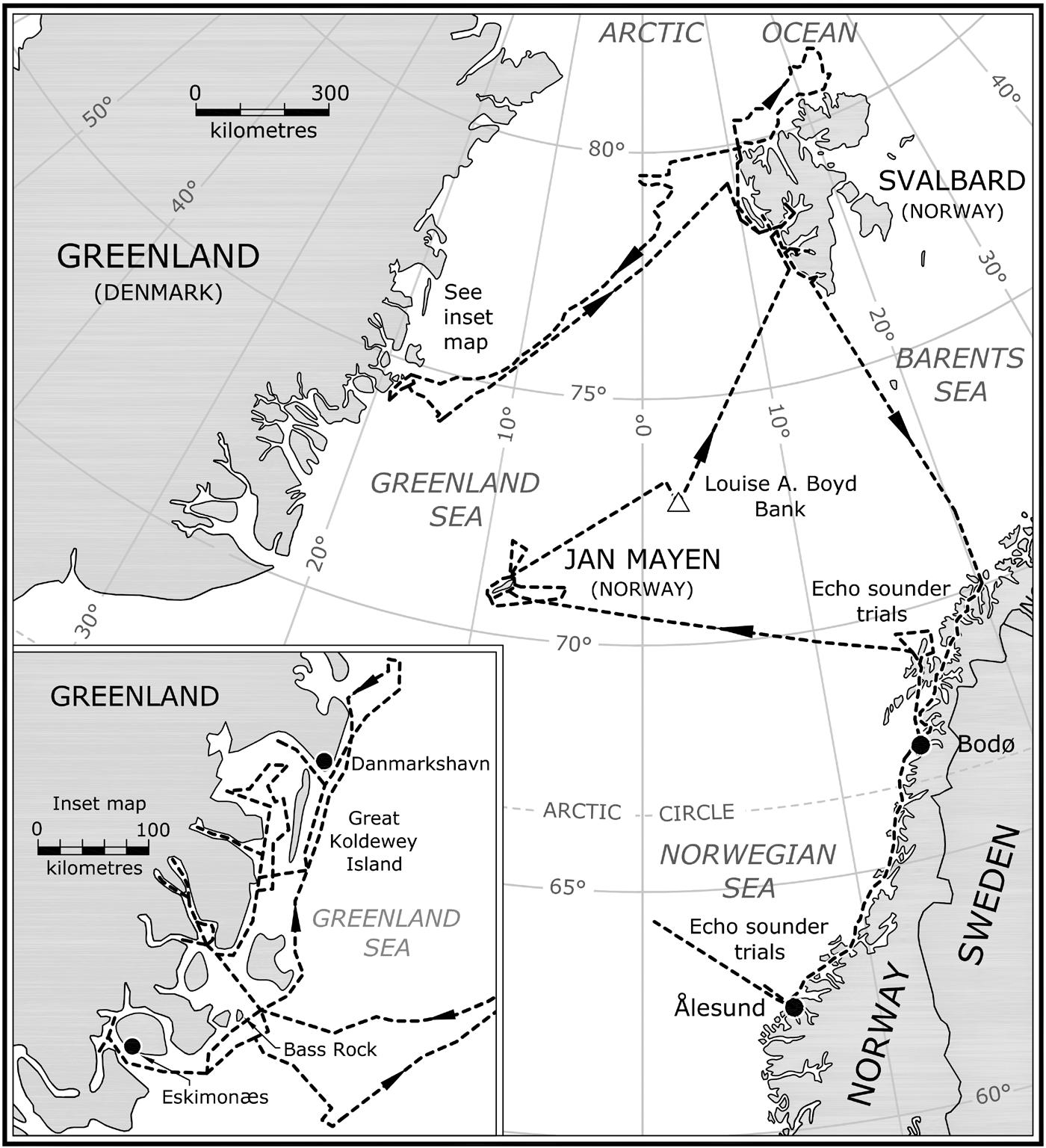
26 SEA HISTORY 181, WINTER 2022–23
Louise Boyd aboard the Veslekari with members of the expedition crew.
norsk polarinstitutt npo24778 , photo by oscar bang courtesy duncan payne
the coast, and these two expeditions con rmed her reputation as a formidable polar explorer. A 1937 New York Times article referred to her as “the only woman polar explorer… whose Arctic explorations in the last ten years have rivaled those conducted by men.”

One of the hallmarks of her four Veslekari expeditions was the use of cutting-edge technology. Hers were some of the earliest
Arctic expeditions out tted with a phototheodolite used in terrestrial photogrammetry. Boyd was fascinated with this branch of science, which collected data about the environment through the use of measuring and interpreting photographic images. She also took a variety of di erent cameras with her to ensure that the photographic record she obtained would be as comprehensive as possible.
On all my expeditions my photography of coastal features in panorama and in detail, as well as of ice conditions, was an almost continuous process from either ship or motor dory; and while on shore I took every opportunity to take my cameras up on to high ground from which I could get wide and distant views that often a orded an understanding of the topography in no other way so easily obtained. My work took me long days and many miles into the land away from our base on the ship or from camp sites inland, in order to make as complete a photographic coverage as I possibly could.
Other equipment included a recently developed self-recording echo-sounder, used to collect data on ocean depths, that was subsequently used in the Norwegian Sea, Greenland Sea, and in North East Greenland. Following re nements, it became known as the “Veslekari Model” and became an invaluable tool for the Norwegian shing eet in locating masses of sh. is was the rst Norwegian vessel to be out tted with such a device.
Veslekari underway, unknown date.

SEA HISTORY 181, WINTER 2022–23 27
norsk polarinstitutt npo39399 , photo by engnes
Louise Boyd signing the Fliers and Explorers Globe at the American Geographical Society o ce in 1938.
courtesy of the author
In the summer of 1938, Boyd travelled further north in Veslekari than she had ever been before, reaching Lat. 77 degrees 50 minutes North Long. 17 degrees 10 minutes West along the East Greenland coast. Travelling through large and small ords, Boyd and her team conducted eldwork around the clock. No one was more energetic or eager to work than Louise Arner Boyd herself, much to the annoyance of the scientists onboard, who expressed a desire for a less rigorous approach to eldwork. She believed in the scienti c work
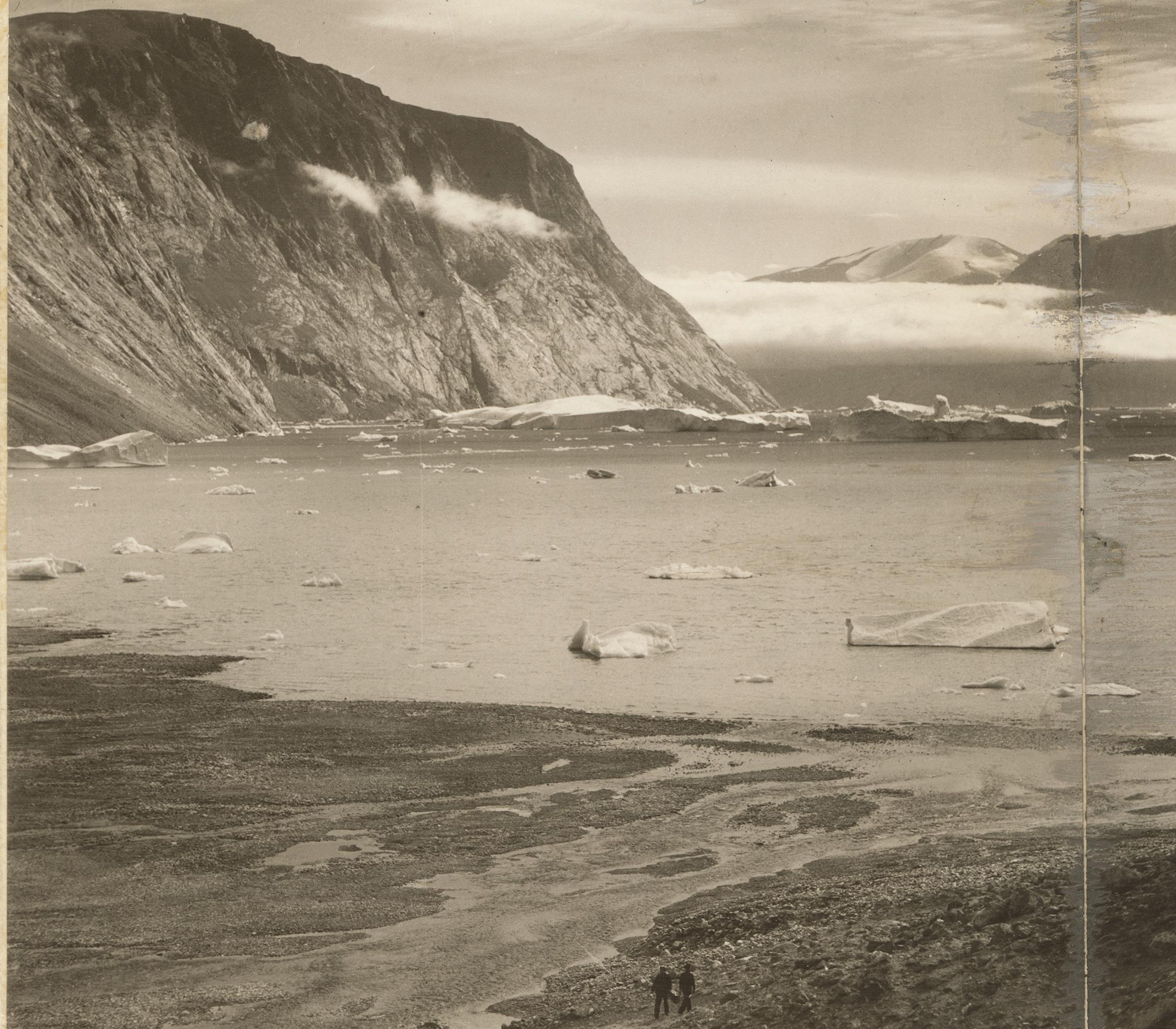
they were engaged in and felt a deep sense of connection to the land.
We found open water and made the eastern entrance of Franz Josef Fiord. I was now in familiar country, and it was with renewed pleasure that I looked forward to seeing once more the 120-odd miles of this ord’s winding waterways. is was my third visit, but repeated visits increase rather than diminish the
thrill that one experiences at the grandeur of the ord, the magni cence of its towering walls and snow-covered mountains borders with summits rising to from 7,000 to 11,000 feet.3
Following the conclusion of the 1938 expedition, Louise Boyd returned to the United States, where she met with universal acclaim. While many awards and honors were bestowed upon her over the course of her lifetime, receiving the Cullum
28 SEA HISTORY 181, WINTER 2022–23
3 e Coast of Northeast Greenland by Louise A. Boyd. American Geographical Society Special Publ. No. 30. New York, 1948. p.30.
Geographical Medal from the American Geographical Society in 1938 had special signi cance for her. First awarded in 1896, it was presented to “those who distinguish themselves by geographical discoveries, or in the advancement of geographical science.” She was only the second woman in history to receive this honor.
A few years later, Boyd hoped to hire Veslekari again and return to Greenland, but world events intervened. Veslekari remained in active use as an expedition ship, sealer, and shing vessel for several more

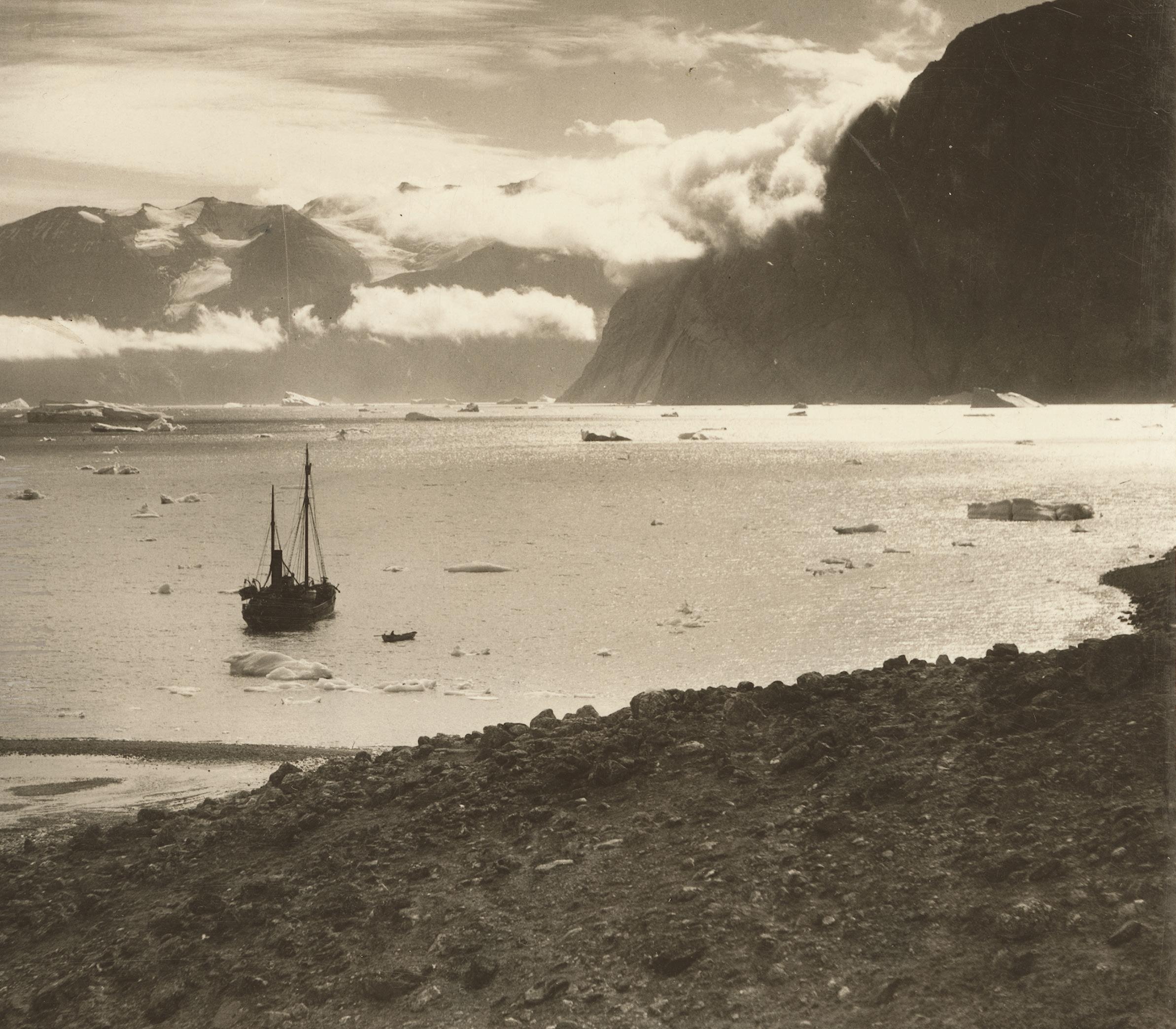
decades. Boyd maintained contact with her old captain, Johan Olsen, and several crew members until her death. She was distraught by the news that Veslekari was wrecked o the coast of Newfoundland, Canada, in April 1961; she could not bring herself to attend the christening of the new vessel of the same name, despite being invited to attend as a special guest. Her relationship with this ship had been too personal. Nevertheless, Louise Arner Boyd’s Arctic adventures were not over yet—her most daring expedition aiding
the American e ort during World War II was still on the horizon.
Joanna Kafarowski PhD is a Fellow of the Royal Geographical Society, a Fellow of the Explorers Club and a member of the Society of Woman Geographers. She is the author of e Polar Adventures of a Rich American Dame: A Life of Louise Arner Boyd (Dundurn, 2017), also available as an audiobook. Kafarowski’s latest book is Antarctic Pioneer: e Trailblazing Life of Jackie Ronne (Dundurn, 2022).
SEA HISTORY 181, WINTER
29
2022–23
courtesy university of
boyd
Veslekari at Ice Fjord, Northeast Greenland National Park. Photo by Louise Arner Boyd.
wisconsin milwaukee louise arner
collection
NAVIGATI NG R ISK
Early American Marine Insurance and the Growth of a Nation
by Hannah Farber
I set out to study early American merchants’ adventure stories, not their insurance policies. But once I started noticing insurance, I saw it everywhere: in merchant memoirs, in newspapers, in city directories, and in state legislative records. Maritime insurance, I eventually realized, was an essential underpinning for vast numbers of early American merchant ventures. But then the story took a turn that surprised me even more: America’s insurers were venturers in their own right. By backing the American merchant eet during the Age of Revolution and investing their pooled funds in their brandnew republic’s federal securities and in bank stocks, these insurers were taking nancial risks that were also highly political in nature. To summarize the argument I make in Underwriters of the United States: during the rst few decades of American independence, the old business of marine insurance became suddenly and deeply involved in the new business of American state making.
Much of this broader story has remained obscure because of insurance’s reputation as a dull business, de ned by tedious and intimidating calculations. Ironically, this very reputation became one of the sources of American insurers’ power. e composite annotated narrative below describes a merchant’s interactions with a new American insurance o ce. It is loosely based on an actual policy issued at the turn of the nineteenth century by the Boston Marine Insurance Company. e policy can be found in the collections of the Massachusetts Historical Society.
It is August of 1800. Now is certainly not the safest time for a Boston merchant to be sending a trading vessel down to the Caribbean, but then again, it’s been worse. You’ve been reading the newspapers and corresponding with your business partners overseas, so you know that the French Revolutionary Wars seem to be heading toward a lull in the region. Great Britain, with its armies ravaged by yellow fever and its spirits shaken by French slave emancipations, has given up on conquering Caribbean islands for the moment and is shifting its resources toward the war in Europe. e United States government has put twenty-three naval ships into operation to protect its merchant eet and is actively negotiating with France to rein in that country’s own predations on Americans. Your government has also given you legal permission to put a few guns on your vessel. On the other hand, there are still plenty of naval vessels and privateers of various nationalities out there, and they carry a lot of guns. ey have the power to detain you, rob you, or force you through lengthy

(above) A Boston Marine Insurance Company $10,000 policy for the ship Follansbee for a voyage from Newport to Manila and back, dated 5 September 1800. (top) Ships rough the Ages: Topsail Schooner Enterprise, Brig Sommers, Old Salem Bark by Frederic Leonard King (1879–1947). Public Works of Art Project commission for the Je ries Point Branch of the Boston Public Library.
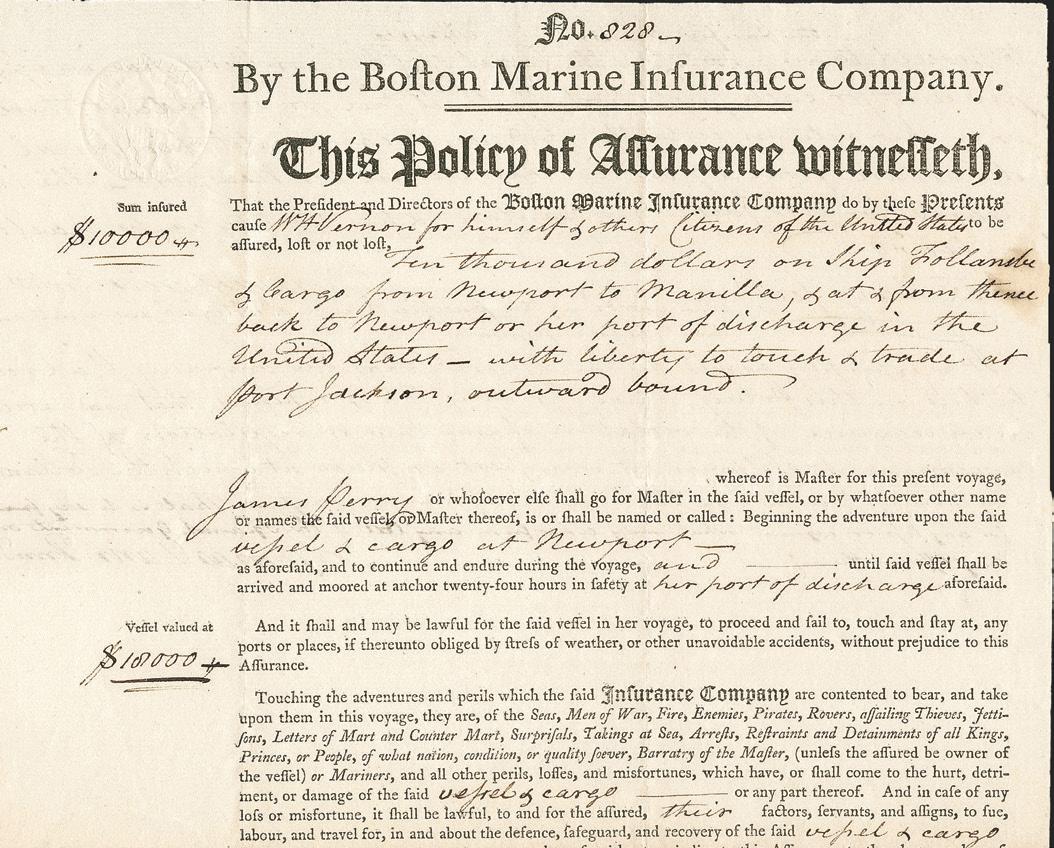
30 SEA HISTORY 181, WINTER 2022–23
courtesy siegel auction galleries , new york
boston public library, digitalcommonwealth org
court proceedings to prove that your trade isn’t bene ting their enemies or violating international law. erefore, you have decided, you had better acquire an insurance policy for your relatively cheap two-masted schooner, the Eagle, which departed for Antigua a few days earlier.

Demand for insurance always grew in times of political unrest, when merchants had more reason to fear loss—but sometimes more reason to hope for windfalls. is was certainly the case during the French Revolutionary Wars, when the warring powers demanded American foodstu s to feed their armies and American ships to slip goods past their enemies.
You usually buy insurance in London, but this time you decide to take your chances on one of Boston’s new insurance companies, which recently received a corporate charter from the state legislature. It will probably be more expensive, but there are advantages to doing business closer to home. You saw the names of the company’s twelve elected directors in a local newspaper. ey are not close friends of yours, but you know them to be deliberate, honorable, reasonable men. A few are members of the state legislature, which makes it unlikely, you gure, that the company will encounter political headwinds.
understand that its location has been chosen to signal its allegiance to the nest traditions of Boston commerce. e o ce is conveniently located at the center of Boston’s compact commercial district, where merchants have congregated for generations. It rents its rooms from the Union Bank, which itself only just purchased the attractive three-story building at the corner of State Street and Exchange Lane from one of its own directors. You go to the o ce at nine in the morning, right when it opens. e secretary rises gracefully from his chair and greets you with an easy, straightforward gentility, which makes you feel all the better about this new company—though institutionally upstart, its people know the rules of proper behavior.
Insurance companies were usually formed by the most prominent merchants in American port cities. eir founders’ reputations and political connections contributed to their stability. But insurers’ social positions and politics varied from place to place, and American marine insurance, in aggregate, never belonged to any single political party, social class, or port city clique.
Americans formed scores of insurance companies (at rst, principally marine insurance companies) between the mid-1790s and the outbreak of the War of 1812. Charters granted by state legislatures provided these companies with legal security and helped convince the public that they were secure and reliable institutions, despite the enormous risks they were taking on American ocean ventures. Once incorporated, insurance companies invested in the United States, purchasing, with their accumulated funds, large sums of federal securities. In this fashion, they contributed to the United States’ own security.
e new insurance company’s o ce is discreet in its appearance and makes little impression on passersby, but, as a local, you
WINTER 2022–23
You describe the vessel and the planned route to the company secretary. You tell him of the Eagle’ s departure date and say you have no knowledge that any harm has come to the Eagle thus far; under those conditions, he says the insurance company will consider your proposal for a policy. You say you don’t care to insure your outgoing cargo, as it didn’t cost you that much, but you would like insurance to cover your return cargo, the sugar, which you expect will be worth around $2,300. If the sugar ends up being worth less, you will get some of your premium back.8 You also ask for $1,000 on the Eagle itself, both ways. e clerk inscribes your proposal in a book. ree of the company directors and the president meet every day to consider policies, and if you return after four o’clock in the afternoon, when the o ce reopens for a few hours, they will let you know whether they will insure the Eagle and, if so, at what rate. As for the insurance contract itself, he says, it proceeds in the usual way. He gestures at his desk, where a well-known compilation of merchant customs, procedures, and best practices—Wyndham Beawes’s Lex Mercatoria Rediviva —lies open. You look down and note, approvingly, that he has a current edition. Marine insurance is a tricky business, and peculiar circumstances crop up all the time. But if this company takes its cues from the well-reputed Beawes, everything is likely to be, so to speak, smooth sailing.
American merchants, shipmasters, and insurers believed that marine insurance operated according to the dictates of the notoriously complex lex mercatoria, the “laws of merchants,” which supposedly worked the same way everywhere and never changed. is supposition was largely false, but the experienced merchants who ran the rst American marine insurance companies believed it was true, and they ran their corporations and formed American law in accordance with what they believed to be its dictates. In so doing, they gave genuine power to the “laws of merchants” and made themselves into the preeminent interpreters of those so-called laws.
SEA HISTORY 181,
31
(above) e Continental Schooner Hannah by John F. Leavitt, n.d. ough tted out for the use of the Continental Navy during the American Revolutionary War, this vessel would have resembled many schooners of the era used for commercial purposes.
nhhc , us navy
In the afternoon, you return to good news. e company’s directors have conferred. ey have glanced at the clerk’s notes on your vessel, your shipmaster, and the proposed destination, and combined this information with their own recent intelligence on the current political condition of the region and their longerterm experience with trips to the Caribbean during hurricane season. ( ey have also, you suspect, made a brief discussion of you.) ey have agreed to grant you an insurance policy for $3,300, as you requested, at an 8 percent premium, totaling $264. is premium assumes that, as you have discussed with them, your vessel may make a few extra stops at di erent islands if suitable sugar in Antigua is too scarce or expensive. Nevertheless, they will return 1 percent to you if your ship goes to Antigua only and returns home without loss.
Insurers wielded capital’s power over their merchant customers. ey had the power to impose conditions, such as a particular destination or a set of travel protocols, and to refuse to indemnify merchants who disregarded them. But the laws also placed signi cant obligations on the shoulders of underwriters, who were expected to be experienced merchants themselves. As one treatise explained, “It is unnecessary [for the merchant] to inform the underwriter . . . that which he ought to know.” ere was, in other words, a body of knowledge about commerce, which changed constantly and which could not really be written down or codi ed. Yet one of the central tenets of insurance—part of the broader corpus of the laws of merchants—was that the underwriter was obligated to know all of it.
At rst, you object that this rate sounds a bit high. (As a Bostonian, you don’t mind haggling a bit.) You have in your possession a city guidebook indicating that a new insurance company has just started up in Baltimore, and you mention that you might write to them to see whether they could do better. But the clerk assures you that the new Baltimore company will o er you a similar, if not identical, rate. He says he has recently exchanged letters with the secretary of that very company, and its opinions on the current dangers of the West Indies are the same as his own. You believe the secretary. His company’s reputation is at stake; if you were to discover later that it charged you an exorbitant rate, you would tell all of your neighbors.
Americans tended to believe that incorporating multiple companies to do the same kind of thing would prevent monopolistic behavior by forcing the companies to compete. In fact, however, American insurance companies often found it more advantageous to compare their policies and to share information.
You will have to pay your $264 premium to the company within ten days, but you will not pay with gold or silver or even banknotes. Instead, you will pay with your “note,” an o cial, interest-bearing IOU co-signed by an approved endorser—ideally, a Boston merchant possessing wealth as well as the traditionally celebrated characteristics of “probity . . . and honour.” Luckily you know just such an individual, who happens to be personally known to one of the company directors in the o ce
e Boston Marine Insurance Company issued policy no. 1462 (the inspiration for this narrative) to John Hawkins Jr. on 20 August 1801, for $1,000 on the schooner Eagle and $2,300 on its cargo.
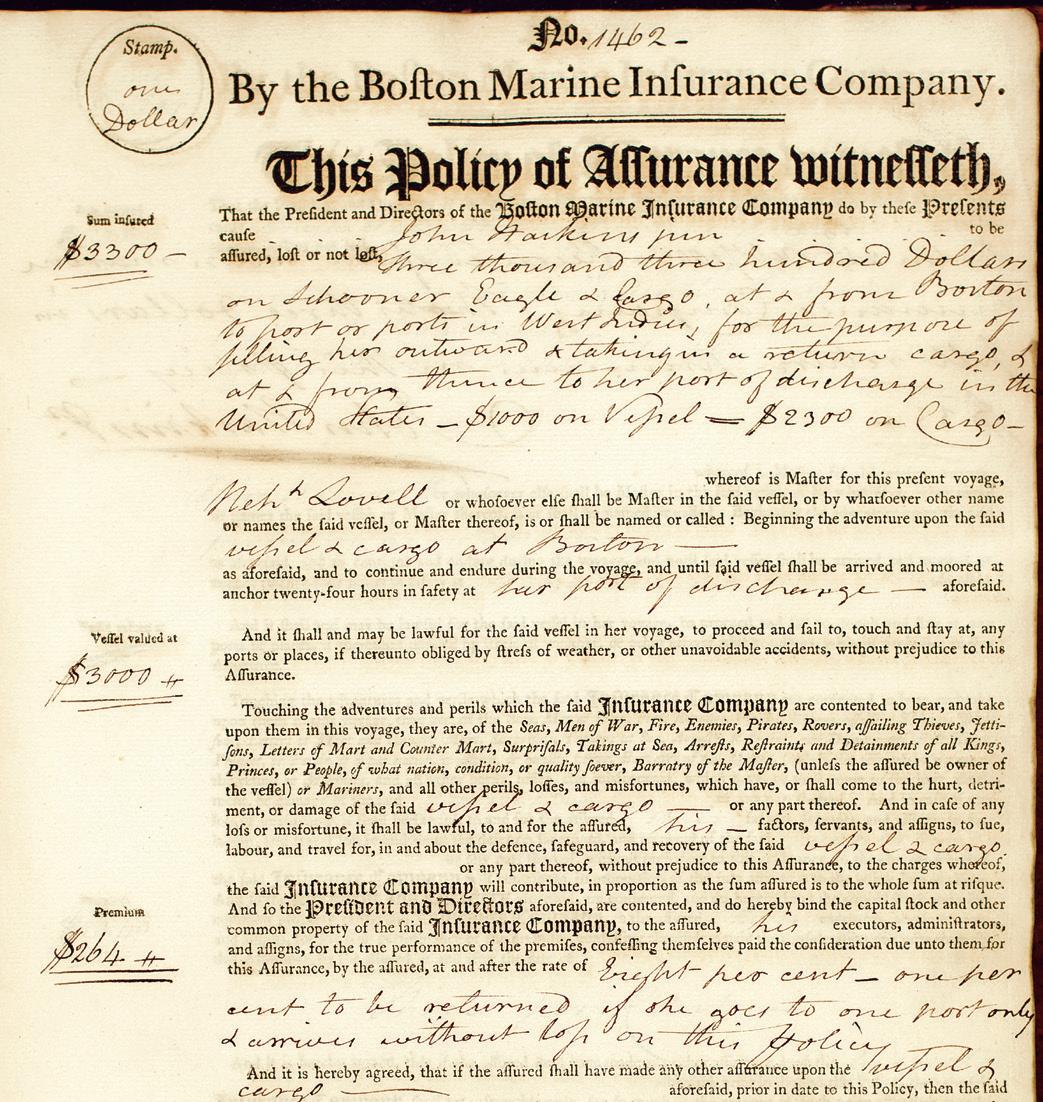
that day. e note will come due in ninety days, at which point you will have to pay the insurance company with gold, silver, or bills payable at a Boston bank. If you had been planning something extravagant, like a China voyage, you would have had a full twelve months to pay your premium. e idea is that your voyage will come in before your premium note comes due, which will allow you to pay the bill out of the proceeds of your sale of the arriving goods. Really, the insurance company is making you a loan, by means of which you pay it your premium. You ask whether the bills of out-of-state banks are acceptable—you have a lot of Rhode Island bank bills you would like to get rid of—alas, the clerk says no, only Boston bills will do. Perhaps, you think, this is owing to the company’s desire to deal only with the banks in which it has the greatest con dence; perhaps it is because most of the insurance company directors also have some hand in Boston’s banks. It takes only another moment’s consideration for you to realize that these two factors are inseparable: the insurance company directors trust the banks in which they hold shares, and they hope to see those banks pro t further.
e rst American insurance companies enjoyed close and reciprocal relationships with the rst American banks, which were often founded by overlapping groups of people.
You agree that you will pay in Boston bills. e company secretary lls out two copies of the policy—one loose-leaf for you to take home, and one that will stay bound into the company’s current policy book. You notice, reassured, that it looks like every other insurance policy you have ever seen. Your eyes run over the familiar list of mishaps that the policy claims to cover:
32 SEA HISTORY 181, WINTER 2022–23
massachusetts
historical society
e seas, men of war, re, enemies, pirates, rovers, assailing thieves, jettisons, letters of mart and counter-mart, surprisals, takings at sea, arrests, restraints, and detainments of all kings, princes, or people, of what nation, condition, or quality soever; barratry of the master (unless the assured be owner of the vessel) or mariners, and all other perils, losses, and misfortunes, which have, or shall come to the hurt, detriment, or damage of the said [vessel and cargo] or any part thereof.1
You know that many of these guarantees actually come with complicated quali cations, but you are nonetheless pleased to see that this company’s policy uses the ancient language and that it is in general quite similar to the text on policies you have previously acquired in London. e secretary signs your copy, as does the company president.
Weeks later, you receive bad news. On the voyage home, the Eagle passed through a signi cant storm, its hull sprung a leak, and it had to put into port in Nassau, in the Bahamas. e shipmaster there discovered that a signi cant portion of its cargo of sugar had been spoiled. is sort of storm is not considered to be your shipmaster’s fault—he did the best he could, under the circumstances—and you le a claim with the insurance company for the loss of the sugar and for the expenses of repairing the damaged Eagle. Luckily, your shipmaster has been conscientious, and all your papers are in order. e repairs don’t even take too long.
When your schooner nally arrives back in Boston, you send the company the shipmaster’s notarized “protest,” a standard piece of paperwork that attests to the circumstances of the loss. You also send the additional routine paperwork that proves the sugar had indeed been loaded on your ship and the price that you paid for it. e insurance company, after all, will not reimburse you for more than what you lost. e directors of the company, who are mostly experienced merchants, make a brief but serious examination of your paperwork and decide that everything looks in order. e sugar pricing seems right, and the shipmaster’s testimony is convincing. e Nassau notarial seal on his protest is one that some of the directors recognize from their own vessels’ journeys to the region. ey notify you by letter that they have agreed to honor your claim, and they will pay you, according to the terms of the policy, within sixty days of the adjustment.
You’re fully covered on the sugar. Had your destroyed sugar arrived safely in the US and been sold there, you would have made, after deducting your agent’s charges and customhouse costs, $2,100, so this is considered to be what you lost. e loss is covered by your policy. However, the cost of repairing the ship came to $600, and alas, only $300 of this is covered by your insurance policy. To be sure, you insured your schooner for $1,000, but that insurance amounted to only half the vessel’s declared value. According to the age-old insurance principle of “average,” this means you are responsible for half of its damage or loss yourself. You admit it sounds a bit strange to outsiders, but in the case of shared-
1 Willard Phillips, A Treatise on the Law of Insurance, Vol. 1, 1867, 26.
ownership vessels and cargoes jettisoned in storms, the principle of average actually makes a lot of sense. Shared losses are a core element of ocean commerce.

You decide not to keep an ongoing account with the insurance company, so they o er you a check for what they owe you (the lost sugar sales, plus half the repair costs, minus your premium note, minus 1 percent as a sort of deductible), all payable at either the Massachusetts Bank or the United States Bank. You choose the Massachusetts Bank, since you already keep an account with them. e insurance company records the transaction in its receipt book.
You have enjoyed doing business with the insurance company, and you believe that its growing reputation is warranted. e company must be making sound business decisions, for it has been paying impressive dividends in the last couple of years—the most recent, covering a period of only six months, amounted to a full 12 percent!
American insurance companies multiplied during an unusual time: the high-risk, high-reward commercial climate of the French Revolutionary and Napoleonic Wars, when, for the most part, American vessels and cargoes enjoyed high demand while facing uctuating, but often manageable, nancial risk. Insurers’ panoramic knowledge of commercial arcana, international law, the latest political news, and recent ship captures enabled them—and the merchants they insured—to pro t. eir profits were often extraordinarily high, by today’s standards, and very few went bankrupt.
To celebrate your successful transaction, you visit your local stockbroker and purchase ve company shares. ey are $100 each at face value, but you happily pay $112 apiece. e shares are duly transferred into your name in the company’s stock transfer book. ey will probably make you money, and they will certainly entitle you to cast ve votes for your preferred company directors in the company’s next annual election. Someday, you think, you might make a very good company director yourself.
American marine insurers were the new republic’s pre-eminent market interpreters in a world at war. Insurers were not just successful businessmen because they were brilliant market readers. ey were also market makers, who forged American commercial law and shaped the republic’s economic and political landscape to their own advantage. ough an immensely valuable and productive American economic enterprise, their interests occasionally diverged from those of the republic as a whole. But the public rarely noticed.
Hannah Farber is an assistant professor of history at Columbia University and a series editor for American Beginnings 1500–1900 at the University of Chicago Press. Her research focuses on early American commerce, visual and material culture, and law. Underwriters of the United States, her rst book, was published by the Omohundro Institute of Early American History and Culture and the University of North Carolina Press in 2021.
SEA HISTORY 181, WINTER 2022–23 33
A Grounded Flight: e Harrowing Rescue of an American Blockade Runner in the Dark Days of War
by CAPT Daniel A. Laliberte, USCG (Ret.)
Captain Matthew Kelly, master and part owner of the American schooner Flight, waited anxiously for the Cape Henry pilot to call the turn to starboard to a new course of NNW, which would send his vessel threading the narrow cut between the shoals of the Horseshoe to port and the Middle Ground to starboard. It was 11 April 1813, and he had just blown past HMS Victorious at Lynnhaven Bay, not far inside the entrance to Chesapeake Bay. e lumbering 74-gun British ship of the line and the four boats her captain kept manned and in the water, ready to intercept any vessel chancing a run through the British blockade, had been left in the foam of the Flight’ s wake, as Kelly and his crew entered the bay. Nothing in the British eet could come close to matching the Flight’ s speed. Kelly
was only moments away from being able to relax a bit after making that rst turn, when the schooner suddenly began to shudder and bounce with each passing wave. Newspaper accounts would later quote Kelly as blaming the pilot for failing to mark the turn and consequently running them up onto the hard-packed sand shoals of Tail of the Horseshoe, but for now he and his crew began a frenzied race to lighten their vessel before becoming hard aground—easy pickings for the four pursuing British boats.
Captain Kelly had only learned of Victorious’s presence shortly before 2:00 that morning, when he slowed to take on a pilot o Cape Henry, at the south side of the entrance to Chesapeake Bay. He must have immediately suspected that something was amiss: the lighthouse at the entrance
was extinguished, and the newly embarked pilot soon con rmed the worst. Ships of the British eet had arrived in February to blockade the bay—no one in, no one out. Even neutral vessels were being sent back into port if attempting to leave, or warned o if approaching from sea.
Although the War of 1812 had begun with an American declaration nearly 10 months earlier, the British had only recently gotten around to implementing a serious naval strategy. In the meantime, America’s small eet of only eight elite frigates had embarrassed the Royal Navy. Humiliating defeats at the hands of the American frigates’ superior hull strength, armament, and training had led the British Admiralty to forbid its captains from taking them on in single combat. Additionally, the Americans’ superior speed allowed
is chart, dating from the American Revolution, shows the shoals and inlets where the schooner Flight was navigating at night and what they had to clear, both enemy ships and hazards to navigation, to reach their destination. Horseshoe Shoal is towards the bottom, center.

34 SEA HISTORY 181, WINTER 2022–23
norman b . leventhal map & education center
them to escape encounters in which they would be outnumbered or outclassed. Similarly, America’s privateers—private armed vessels primed to attack and capture British merchant shipping—were proving disastrous to England’s commerce.
Unable to bring the American warships to battle under favorable terms and frustrated by having to ine ectually swat at the elusive swarm of commerce raiders, the British decided that con ning them to port was the next best alternative. e Chesapeake Bay became a prime target of the blockade. Not only would closing the Bay bottle up two of the Americans’ eight frigates—USS Constitution and USS Constellation —it would likewise con ne a signi cant number of their privateers—many based in Baltimore—to port, or block the return of captured British prizes. A blockade would also choke a signi cant part of American foreign commerce, while the threat of coastal raids would divert American forces from the Canadian border to a defensive role in the south. us, a blockade became a critical component of the British naval strategy.
When Captain Kelly and the Flight departed Baltimore back in October, the shipping lanes in and out of the Bay were open. Even that night, HMS Victorious was the only blockading ship stationed at Lynnhaven Bay, waiting to seize any American vessel foolish enough to try to pass.
Captain Kelly was no fool, and the Flight was not just any American vessel. e Flight’ s six light 6-pound guns were no match for the larger batteries of the awaiting behemoth, so Kelly had no intention of ghting. Instead, he planned to take advantage of the darkness and the building winds of a gale, now moving in from seaward, to sneak past the lumbering Victorious before her crew had time to react. is was by no means overcon dence on Kelly’s part. e Flight was a 103 ½-foot Baltimore-built schooner of 260 tons and among the fastest vessels a oat at the time. Her streamlined hull and enormous spread of canvas on sharply raked masts, typical features of this vessel type, were designed for speed, and these schooners became the vessel of choice for slavers, smugglers, and pirates, and the revenue cutters that tried to catch them. Indeed, the Flight had com-
HMS Victorious (depicted at left) was a 74-gun 3rd-rate ship of the line and, while a formidable force in ship-to-ship combat (shown here in previous action against the French in February 1812), she was too big and too deep to get underway quickly and chase the Flight into the shallows of the bays and inlets.

pleted the voyage from Bordeaux to the Virginia Capes in only 35 days—usually an 8–10 week passage for vessels of this period. Nothing in the British eet could catch her. By the end of 1813, the blockade’s commander, Admiral Sir John Borlase Warren, would lament that schooners like the Flight could “run thro’ the Blockade in the Chesapeake, in spite of every endeavour and of the most vigilant attention of our Ships to prevent their getting out, nor can anything stop these Vessels…in dark Nights and Strong Winds.”
Such was the night of 11 April, as the Flight had easily own past the Victorious and left her falling fast astern. Even Victorious ’s four “ready” boats—rigged and manned by 15 to 16 seamen and marines each—steadily dropped back as the Flight initially followed a westerly course into the Bay. Kelly’s rst course change to run up the Bay towards Baltimore would have come when Cape Henry lighthouse bore astern at SSE. At that point he would have needed to turn to starboard, coming to a new course of NNW, which would allow him to pass between the shallow waters of the Middle Ground to starboard and the Horseshoe to port.
With the Cape Henry light extinguished by order of the Secretary of Treasury the previous month to hamper British navigation, the turn bearing would have had to be approximated from a tangent to
land—a tricky proposition under the best conditions, but especially so under the low visibility of an increasingly cloudy night. e light at Old Point Comfort, which would have been visible ahead as Kelly proceeded along his course, had also been extinguished. Kelly would have to rely on his pilot’s local knowledge, hoping that years of operating in this area would enable the pilot to make the timely call. A late turn would run them up onto Horseshoe Shoal, which shallowed to just eight feet in some spots—exceeding the Flight’ s loaded draft of 11 feet 8 inches. Needless to say, they missed getting the bearing, and, with it, the turn, and the Flight crunched to a stop on the hard-packed sand bottom of the Horseshoe. Captain Kelly would vehemently denounce the pilot in later newspaper accounts, but for now he set his crew to jettisoning the ship’s guns, hoping to lighten his vessel enough to free her before the pursuing British boats caught up. ese e orts proved in vain. With each inch that the lightened vessel oated higher in the water, the rising winds simply pushed the Flight farther up onto the shoal.
When the four shallow-draft British boats came alongside, Kelly had few options. His schooner was a letter-of-marque merchant ship—essentially a private vessel that engaged primarily in trade but sported a few cannons and a slightly larger than normal crew that would allow him to pounce
SEA HISTORY 181, WINTER 2022–23 35
art by nicholas matthews condy ( 1816 –1851 ) courtesy rountree tryon galleries
on any weaker enemy trader he might encounter by chance. Had he been a true privateer—intended to serve solely as a commerce raider, with heavier guns and a crew 3 to 4 times larger than the 30 men that he commanded—he might have chosen to ght it out against the 60 or so British marines and armed sailors, who were backed by at least one small brass cannon at the bow of one of the boats that surrounded him. Bowing to reality, Kelly promptly surrendered.
He and his crew were quickly taken o and divided among three of the boats, which then pulled away to return to the Victorious e British lieutenant and his boat crew and marines stayed with the Flight, continuing the e ort to re oat her.

Fate can be ckle. e British boats could make no headway to the east against the strong winds that now howled into the Bay, and the Flight ’s bottom began to stave in as rising seas pounded her against the hard-packed sandy bottom. e three boats returned to the Flight, where the lieutenant
and his men reluctantly abandoned ship— leaving behind a fortune of French wine, brandy, cigars, and silk.
All four open boats then rowed together towards a lee, west of Old Point Comfort, to ride out the storm. ey endured a miserable several hours until sunrise. Bu eted by gale force winds, soaked by a cold, driven rain, and tossed about by tumultuous seas, both captives and captors were exhausted by sunrise.
Just as conditions began to ease, with the winds abating a bit and the sky beginning to brighten, a small American schooner passed close aboard, likely headed to nearby Hampton. Anticipating that the schooner would spread word of their presence and soon draw American attention, but still blocked by easterly winds strong enough to prevent them from returning to Lynnhaven Bay, the British decided to head up the James River to hide out until the conditions improved. ree of the boats managed to stick together past Hampton, but the fourth became separated and some-
how ended up alongside USS Constellation, anchored under the guns of Fort Norfolk. ere the midshipman in charge of the boat surrendered to the Americans. e liberated crewmen from the Flight would have informed Captain Charles Stewart, commanding o cer of the Constellation and senior naval o cer present, of the recent events. In turn, Captain Stewart likely directed the US Revenue Cutter
omas Je erson to get underway and investigate. e cutter was under US Navy control since the Secretary of Treasury had transferred most of its revenue cutters to the Navy for the duration of the war.
Je erson’ s captain, William Ham, was certainly the best o cer for the task. He was intimately familiar with the waters of Hampton Roads and the Chesapeake Bay. His rst assignment as a USRCS lieutenant was on a cutter out of Norfolk, 22 years earlier. He advanced to command of the small, lightly armed USRC Patriot when it was launched in December of 1800. By 1805, he was master of the larger, copper-
36 SEA HISTORY 181, WINTER 2022–23
uscg art collection
US Revenue Cutter omas Je erson chasing down three Royal Navy boats on 11 April 1813. Painting by Patrick O’Brien.
bottomed schooner, omas Je erson, and was authorized to supplement its swivel guns with up to four three-pound cannons.
In addition to having served during the Quasi War with France, Ham had made the rst maritime seizure of the current war—only three days after the formal declaration in June 1812. He had received intelligence of a British vessel o the Virginia Capes and upon investigation soon discovered the schooner, coincidentally named “Patriot.” e vessel was en route to Halifax from Guadeloupe with a cargo of sugar, but had tucked inside the Capes to wait out the passing of the approaching storm.
Captain Ham’s local knowledge served him well in this instance. e Je erson quickly sighted the eeing British boats as they were heading up the James River, past Hampton. Ham recognized that his lightly armed cutter, sporting only four 3-pound guns and manned by a crew of around 18 men, would be overmatched in a stand-up ght with the remaining three British boats. Accordingly, he pulled into Hampton to seek reinforcements. Here he found that Major Gawin Corbin, commanding a battalion of the 3rd Virginia Militia Regiment garrisoning Hampton, had already been alerted to the British presence by the earlier passing schooner that had sighted them around daylight.
Major Corbin readied his attached ri e company, under Captain Richard Servant, for deployment. With the Je erson’ s arrival, Servant’s 40 ri emen were divided between the cutter and the local mail boat, a pilot schooner commanded by Captain Teackle Savage. Corbin also detached his brother, Captain Richard Corbin, who commanded the light artillery battery stationed in Hampton, to embark on the
A bond issued by the US government to George Williams, Henry Holder, Matthew Kelly, and omas Kimp, owners of the schooner Flight, for the amount of $77,644. e purpose of issuing “Bonds for Not Trading with the Enemy” was to encourage merchants to trade with Great Britain’s enemies. ese bonds helped to support the American war e ort in addition to crippling Great Britain’s economy by limiting their access to American trade.

mail boat—suggesting that one of the battery’s small guns was used to arm the boat, although this is not expressly mentioned in the dispatch summarizing the incident for the governor of Virginia.
e two schooners got underway and soon overtook the eeing boats near Newport News. e British force—exhausted, cold, and wet—had no heart for a ght. Faced with an enemy who could spray them with grapeshot from their cannons and pick
them o with ri e re while staying out of musket range, the British raised an improvised white ag without a shot being red. Captain Ham ordered the three boats to the beach, then landed Servant’s 40 ri emen to take custody of the roughly 45 British sailors and marines.
Kelly and the remainder of his crew were freed, sparing them possible long-term imprisonment as enemy combatants. e Flight and most of her cargo were a total
SEA HISTORY 181, WINTER 2022–23 37
nara philadelphia
loss for the owners. eir “Bond for not Trading with the Enemy,” in the amount of $77,694, was returned. is sum represented the value of the Flight and its cargo upon departure from Baltimore and was not “free money” as many think of it, but rather funds that Kelly and his co-owners had been required to post as surety that they would not trade with the British. e bond would have been forfeited to the US government had they violated that agreement. e US government saw these bonds as necessary to discourage some unscrupu-

lous American traders from accepting British licenses to supply British forces ghting Napoleon in Spain.
Some of Flight’ s cargo was recovered from the wreck by American boats and auctioned in Hampton the following week, but most was salvaged by boats from HMS Spartan, another vessel of the blockading force. at cargo eventually made its way to Halifax, Nova Scotia, where the ViceAdmiralty court condemned it and directed the proceeds to be distributed among the o cers and crews of the ships assigned
to vessels participating in the blockade. While the blockading force under Admiral Warren was enforcing the closure of the Bay and strangling its commerce, another squadron under Rear Admiral George Cockburn was raiding at the northern end of the Bay and enjoying an unbroken string of successes, as it picked o both armed and unarmed American vessels, seized supplies, and damaged property and industry ashore.
News of the joint Army/Navy/Revenue Cutter victory spread quickly. is small, bloodless victory provided a much-needed boost to American morale and was a prelude to the larger American victory at the Battle of Craney Island—in which an attempted British assault on Norfolk was repulsed with heavy losses—later that summer. Kelly managed to escape blame for the loss of his vessel and cargo. He went on to command two other letter-of-marque merchants—the Patapsco and the Diamond, both similar vessels to the Flight —during the remainder of the con ict. On his nal voyage before the war ended, he more than made up for his initial loss, capturing two prizes, a brig and a schooner, in addition to successfully completing his trade mission.
CAPT Daniel A. Laliberte, USCG (Ret.) served for more than thirty years in the US Coast Guard, during which time he participated in or provided intelligence support to the interdiction and repatriation of hundreds of undocumented Haitian migrants, and the seizure of numerous drug smuggling vessels and the arrest of their crews. He writes on historical topics involving the Revenue Marine Service and Coast Guard.
(left) A notice in e Enquirer, Richmond, Virginia, Friday, 23 April 1813 advertising the sale of cargo salvaged from the wrecked schooner Flight. “FOR SALE, On Monday the 26th April will be sold at public auction a variety of DRY GOODS Consisting of Silks of all kinds, Gloves, Shawls, Stockings, Ribbons and various other dry goods, together with Brandy, Wine, Oil, Almonds, &c. part of those are in good order, part damaged more or less, for cash. e above goods were saved from the wreck of the Schooner Flight from Bordeaux bound to Baltimore. Hampton, April 20.”
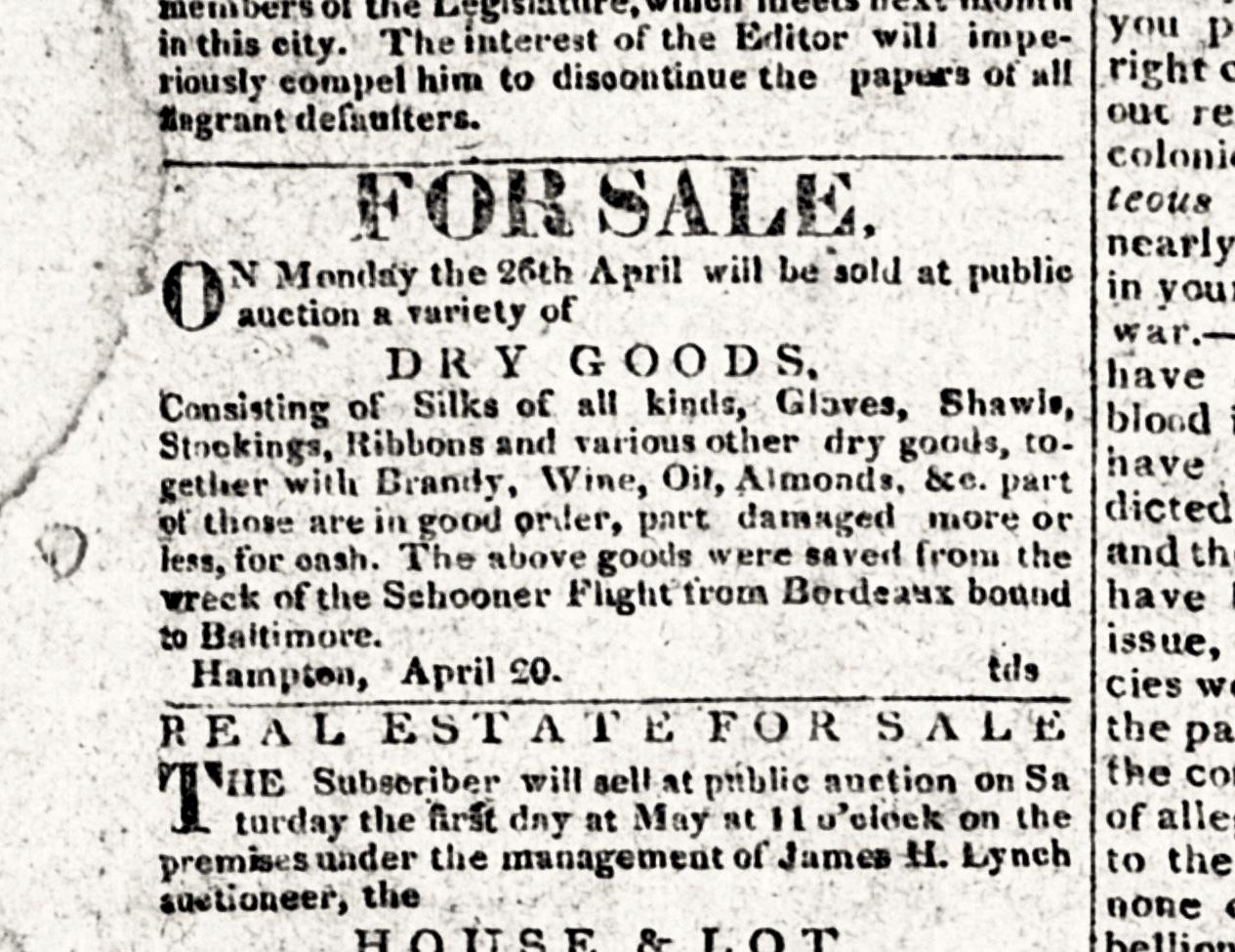
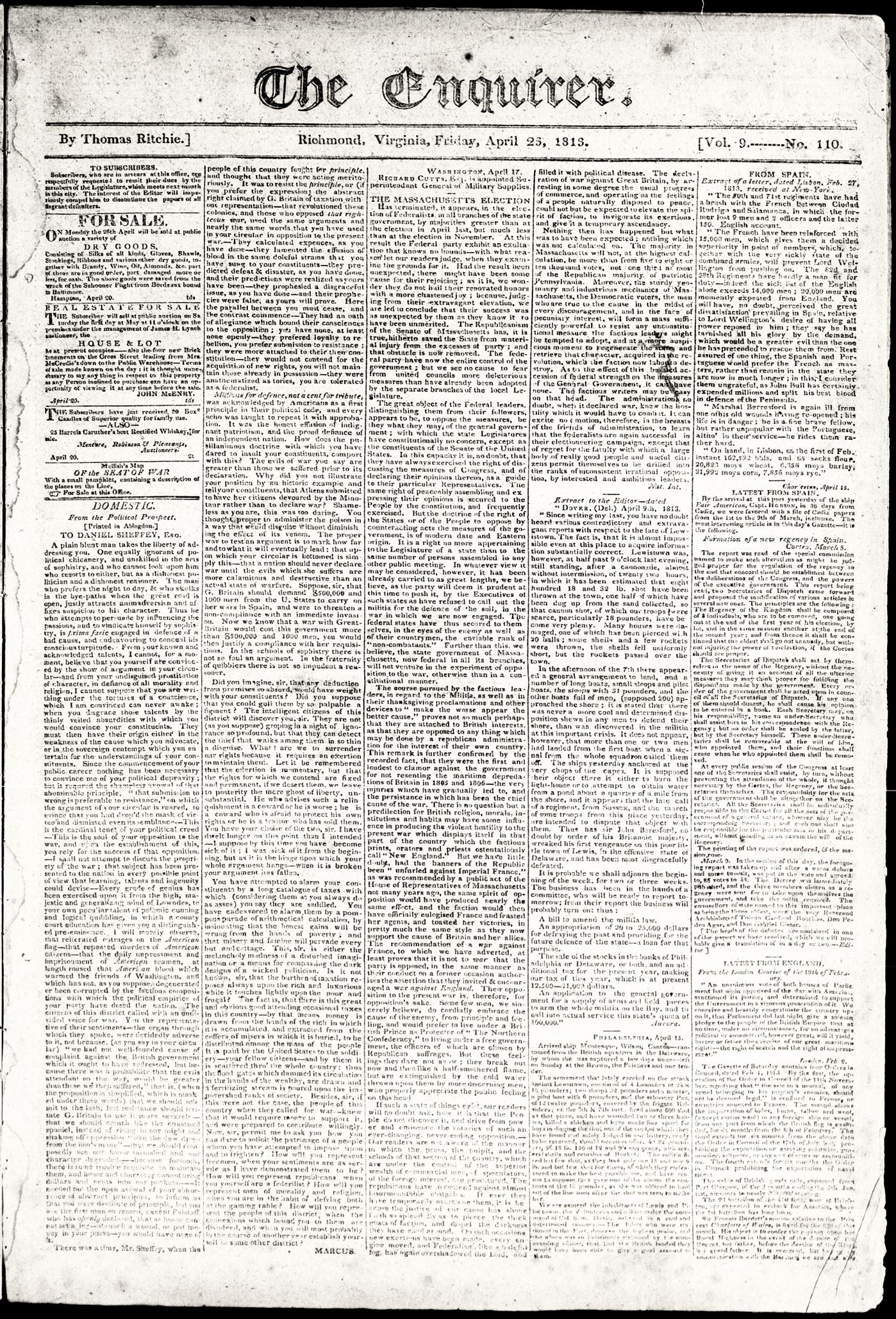
38 SEA HISTORY 181, WINTER 2022–23
library of congress
presented by the NATIONAL MARITIME HISTORICAL SOCIETY a limited-edition print by marine artist PATRICK O’BRIEN
USS Constitution vs HMS Guerriere”
T he USS Constitution won several important victories over the British during the War of 1812, demonstrating that the new American Navy could stand up to the greatest sea power in the world.

Patrick O’Brien is an award-winning artist whose work has appeared on several Sea History covers, including this issue!
The print is a giclée, printed on high-quality art paper with archival inks, signed and numbered by the artist. The paper size is 18 x 24 inches and the image size is 14 x 20 inches.
$335
shipping in the USA included
To order, call 1-800-221-NMHS (6647), ext. 0 or go to www.seahistory.org
NYS residents add applicable sales tax For international orders contact Wendy Paggiotta at advertising@seahistory.org
A portion of each sale supports the National Maritime Historical Society.
SEA HISTORY 181, WINTER 2022–23 39
The USS Constitution vs HMS Guerriere by Patrick O’Brien
An American Victory During the War of 1812
“The
Marine Art News

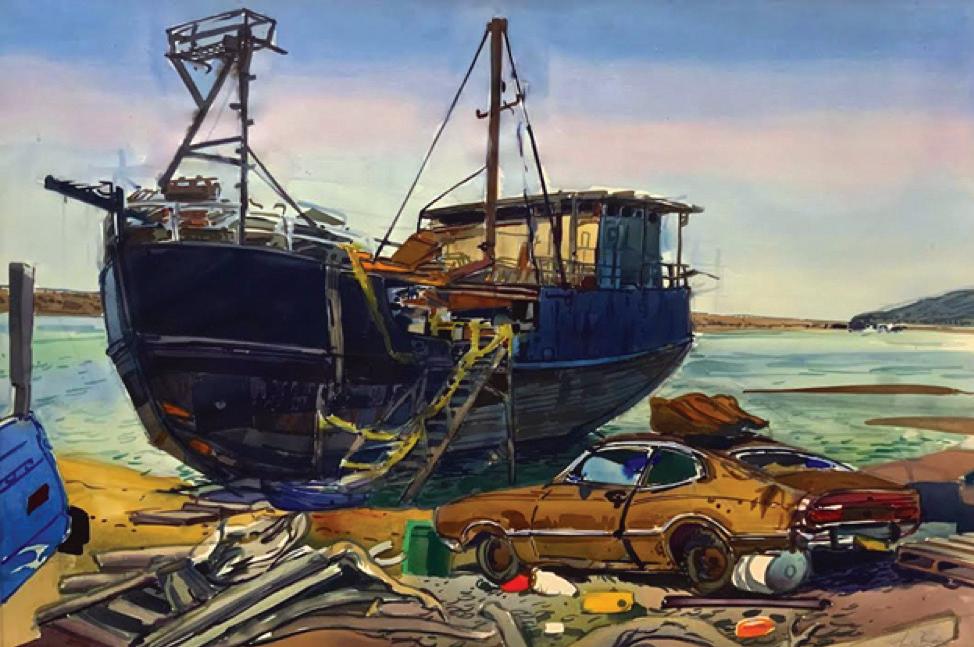
The Ship Show is a new maritime-themed art exhibition that recently opened at Clatsop Community College’s Royal Nebeker Art Gallery in Astoria, Oregon. Curated by Ben Killen Rosenberg, the show focuses on the maritime environment and bustle of a seafaring community, in all its glory and complications. e Ship Show features works by the following artists: Lindsey Aarts, Mark Andres, the late James Weldon Brown, Sally Cleveland, Roger Dorband, Annie Eskelin, Kevin Farrell, Anna Fidler, Drea Frost, Friderike Heuer, Nick Knapton, Randy McClelland, the late Royal Nebeker, Henk Pander, Paul Polson, Ben Killen Rosenberg, John Taylor, Kristin Shauck, Lucien Swerdlo , and Noel omas. e CCC Royal Nebeker Gallery is dedicated to enriching the cultural life of the campus, the local community, and the North Coast region. e gallery is free and open to the public, Monday–Friday. Check the website for hours of operation. (1799 Lexington Avenue in Astoria, Oregon; www. clatsopcc.edu/community-resources/royal-nebeker-art-gallery/)
watercolor by Henk Pander
Power and Perspective: Early Photography in China

e Peabody Essex Museum recently opened Power and Perspective: Early Photography in China, an exhibition that explores how the camera transformed the way we imagine China. Photography’s development as a new form of art and technology in the 19th century coincided with profound changes in the way China engaged with the world. e medium evolved in response to war, trade, travel, and a desire for knowledge about an unfamiliar place. e exhibition features 130 photographs in dialogue with paintings, decorative arts, and prints drawn largely from PEM’s collections, with select loans from public and private collections. By calling attention to the power dynamics at play, the exhibition sheds light on photography as an inherently social medium that continues to shape our perspectives today. Power and Perspective is on view through 2 April 2023. (161 Essex St., Salem, MA; www.pem.org)
Minnesota Marine Art Museum Early Winter Art Installations
e Minnesota Marine Art Museum in Winona has three new exhibitions underway for a limited time, each ending during January 2023. First up is Nick Wroblewski: e Draw of the Lake, open through 8 January. Wroblewski is an award-winning woodcut printmaker based out of Duluth. His printmaking is traditional, technical, and precise, but he leaves room for creativity and spontaneity during the process. e prints in this exhibition celebrate nature and the rugged beauty of Lake Superior’s North Shore. On view through 15 January is Laughing Waters by Karen Savage-Blue, an Anishinaabe artist and member of the Fond du Lac Band of Ojibwe, from the Fond du Lac Reservation near Cloquet, MN. Her paintings explore themes of internal re ection, identifying with nature, and exposing transitions from human to natural forms. Her work can be dreamlike and surreal, and she depicts nature in its raw form, creating a platform where thoughts and emotions overcome the tendency to decipher meaning. Finally, Water Stories: New Work by Anne Labovitz is on display through 22 January
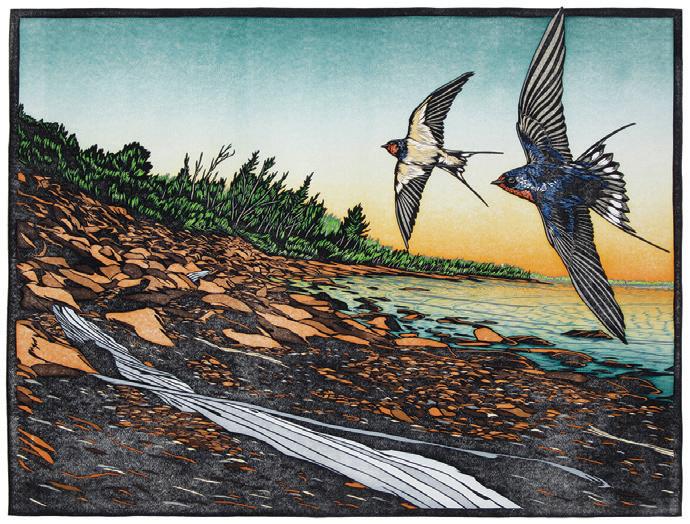
e Draw of the Lake by Nick Wroblewski 2018, diptych, woodblock print on paper
e St. Paul artist creates colorful and powerful largescale works that invite the audience to consider their lives in connection to water. is new work examines water in di erent visual manifestations, highlighting its powerful and mesmerizing presence. rough painting, sculpture, and a large exhibit hall installation, audiences are o ered an immersive and participatory experience. (800 Riverview Dr., Winona, MN; www.mmam.org)
Noticeably Still by Karen Savage-Blue, 2019, acrylic on canvas

40 SEA HISTORY 181, WINTER 2022–23
Sunset Water Memories by Anne Labovitz 2022
courtesy of the artist
courtesy of the artist
courtesy royal nebeker art gallery, ccc
courtesy peabody essex museum
photo by steven cohen , courtesy mmam
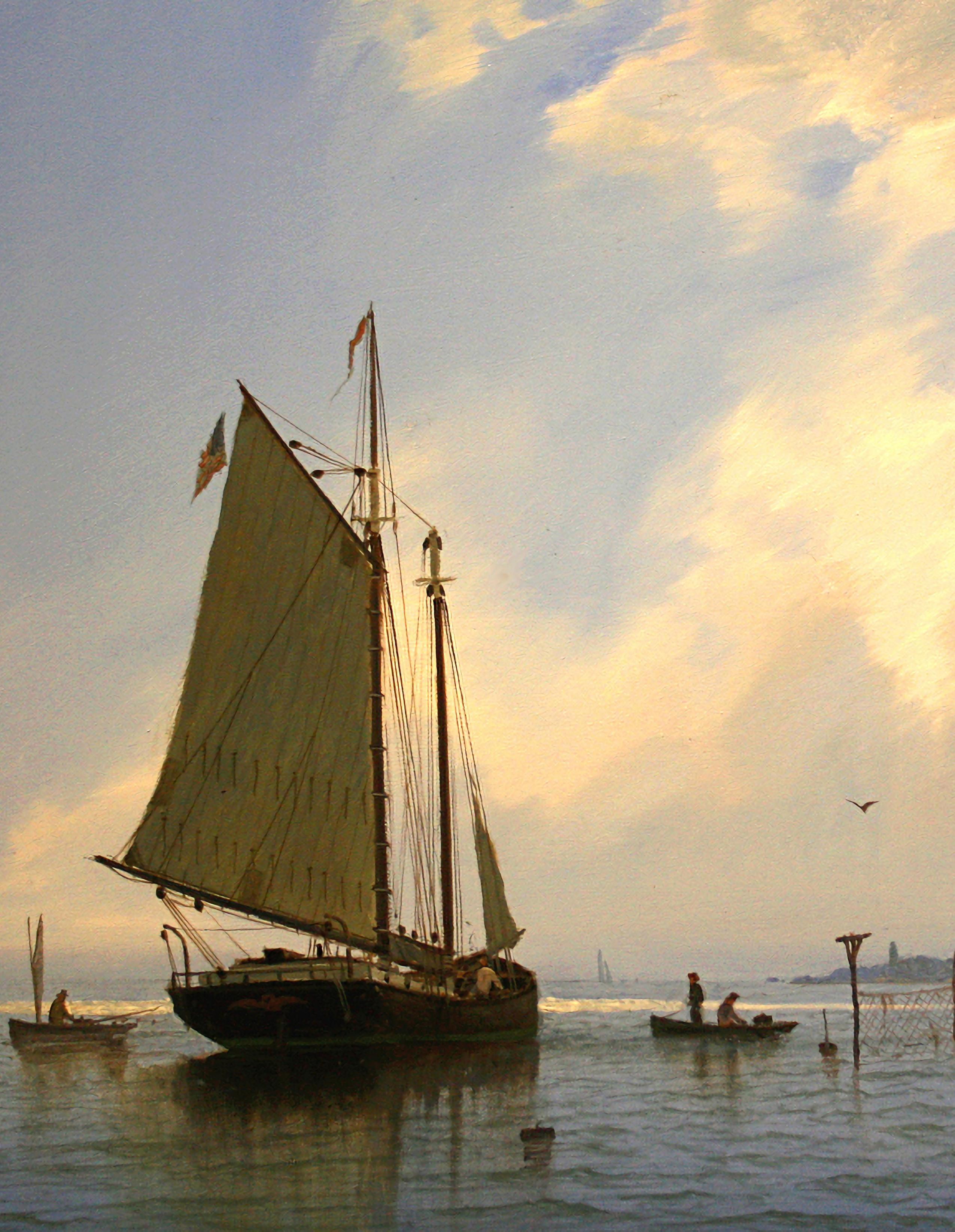
THE AMERICAN SOCIETYOF MARINEARTISTS Celebratingover40years ofAmerica'sfnest contemporarymarineart. Jointodayandyou'llget ourfullcolor,quarterly magazine,theSociety's News&Journalfora wholeyear(4quarterly issues) Painting:WilliamR.Davis, TendingtheWeiroffWestDennis,oil,8x10(detail) AmericanSocietyofMarineArtists.com
SEA HISTORY for kids
For I Knew a Ship from Stem to Stern1

Abolitionist, orator, and statesman, Frederick Douglass had been born into slavery. By the time he was a young man in 1838, he was working as a ship’s caulker in a Baltimore shipyard, pounding oakum into the seams between the planks of wooden vessels to make them water-tight. It was a di cult but skilled job, but considerably better than his previous work on a plantation. In the 18th century, slave owners in port cities often sent their slaves out as maritime laborers and then pocketed their wages each week. Enslavement and relinquishing his hard-earned money was di cult for Frederick Douglass to bear, and it cemented his resolve to escape to the North. His experience around ships and sailors would help him succeed in getting away, as free African-American mariners were not uncommon and they carried documentation on them at all times to verify that they were not escaped slaves.
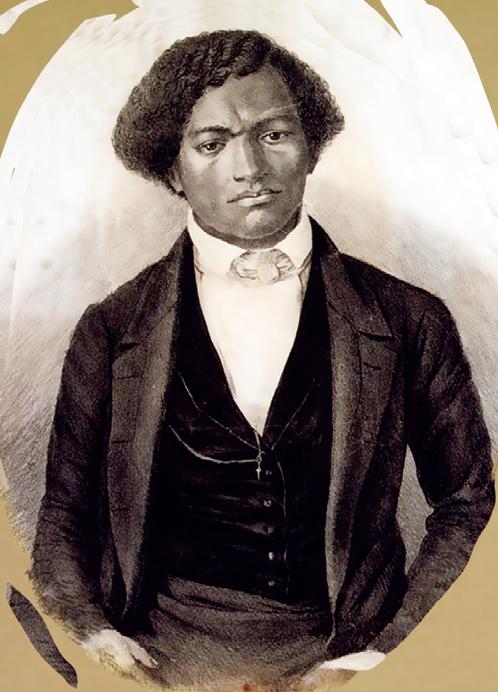
Unlike many others who escaped their bondage via ships and boats, Douglass instead boarded a train heading to New York, posing as a sailor. He wore typical mariners’ clothing and carried documents borrowed from a free African American sailor that would allow him freedom to travel. “My knowledge of ships and sailor’s talk came much to my assistance, for I knew a ship from stem to stern, and from keelson to cross-trees, and could talk sailor like an old salt,” he wrote in his memoirs in 1882. Some strategy, luck, and “kind feelings…towards those who go down to the sea in ships” helped him reach New York—and freedom—a day later. He would make his way to New Bedford, Massachusetts, then a busy whaling port. It was also home to a group of anti-slavery activists, who helped him get started in his new life and who encouraged him to join them in their e orts to eradicate slavery in the United States. Douglass, who had been taught how to read by a previous master’s wife, became a life-long activist, author, orator, and diplomat, and had a signi cant role in the abolitionist movement.
While Frederick Douglass’s skills as an author and speaker were extraordinary, his experience in the maritime labor force was not uncommon. Slaves and freeborn African-Americans built and manned ships, worked in the sheries, and provided a steady labor force in maritime support industries, such as caulking—Frederick Douglass’s occupation during his enslavement. Douglass was in a place that had him working side by side with free sailors, so when he saw his chance to pose as a free black seaman and get north to freedom, he took it. Maritime trades provided steady employment for African Americans, both enslaved and free, and those who escaped could rely on their skills to nd work in port towns and cities in the north.
Caulking the Seams , photo by Albert Cook Church (1880–1965). Shipbuilders fastened planks edge to edge to create the shell of the wooden hull. Before a ship could be launched, someone had to fill the spaces between the planks to keep them watertight. This task fell to the caulker, who used a mallet and caulking irons to drive hempen fibers, called oakum, into the tight spaces between planks. It was a tedious and uncomfortable job, but nevertheless a skilled trade that was in demand in most port towns.
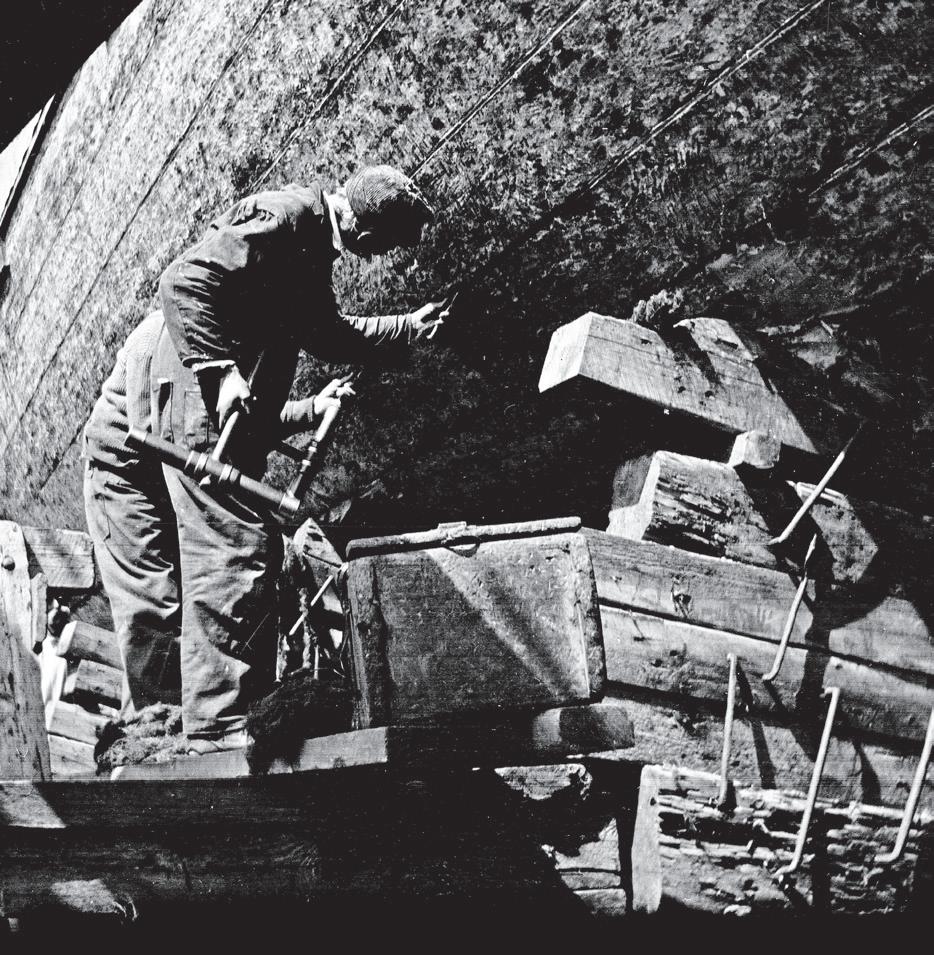
1 Adapted from a 2017 article by Elizabeth Moore, NOAA NMS, published online at https:// sanctuaries.noaa.gov/news/feb17/for-i-knew-a-ship-from-stem-to-stern.html.
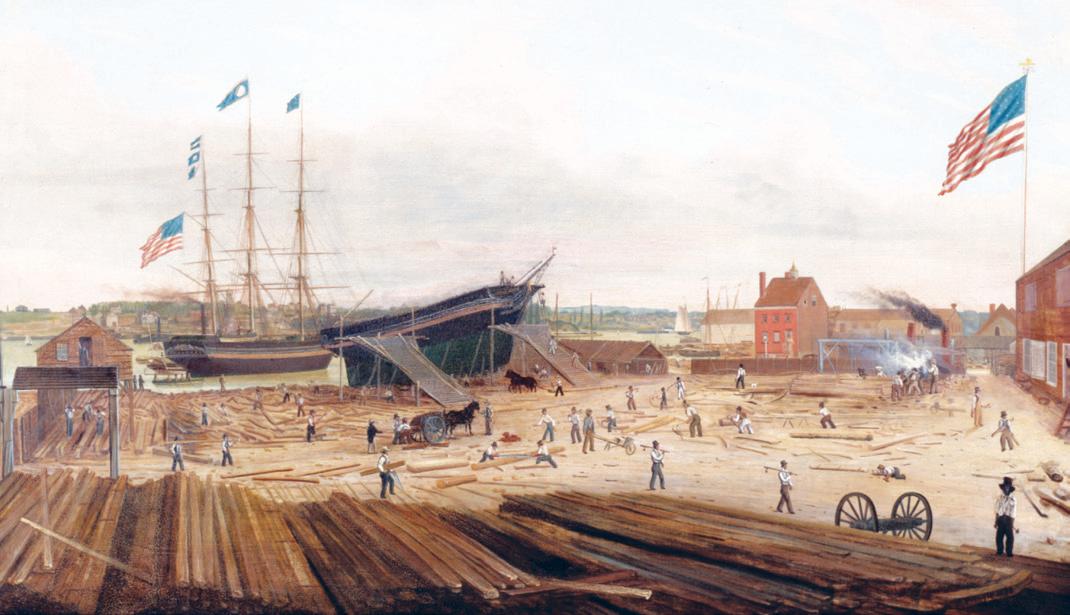
42
nps
Frederick Douglass’s job in a shipyard gave him the opportunity for escape by posing as a free seaman. This image depicts a typical American shipyard in 1833.
fenimore museum
. gov
courtesy new bedford whaling museum
AHOY Students! Follow The Voyage—Share the Experience
Since 2008, we’ve been printing profiles of maritime professionals in Sea History to show you all the kinds of careers out there that are related to ships and the sea. For students wondering if a career at sea is right for you, here is your chance to follow Massachusetts Maritime Academy (MMA) cadets in real time as they embark on their 2023 Sea Term, 3 January to 19 February.

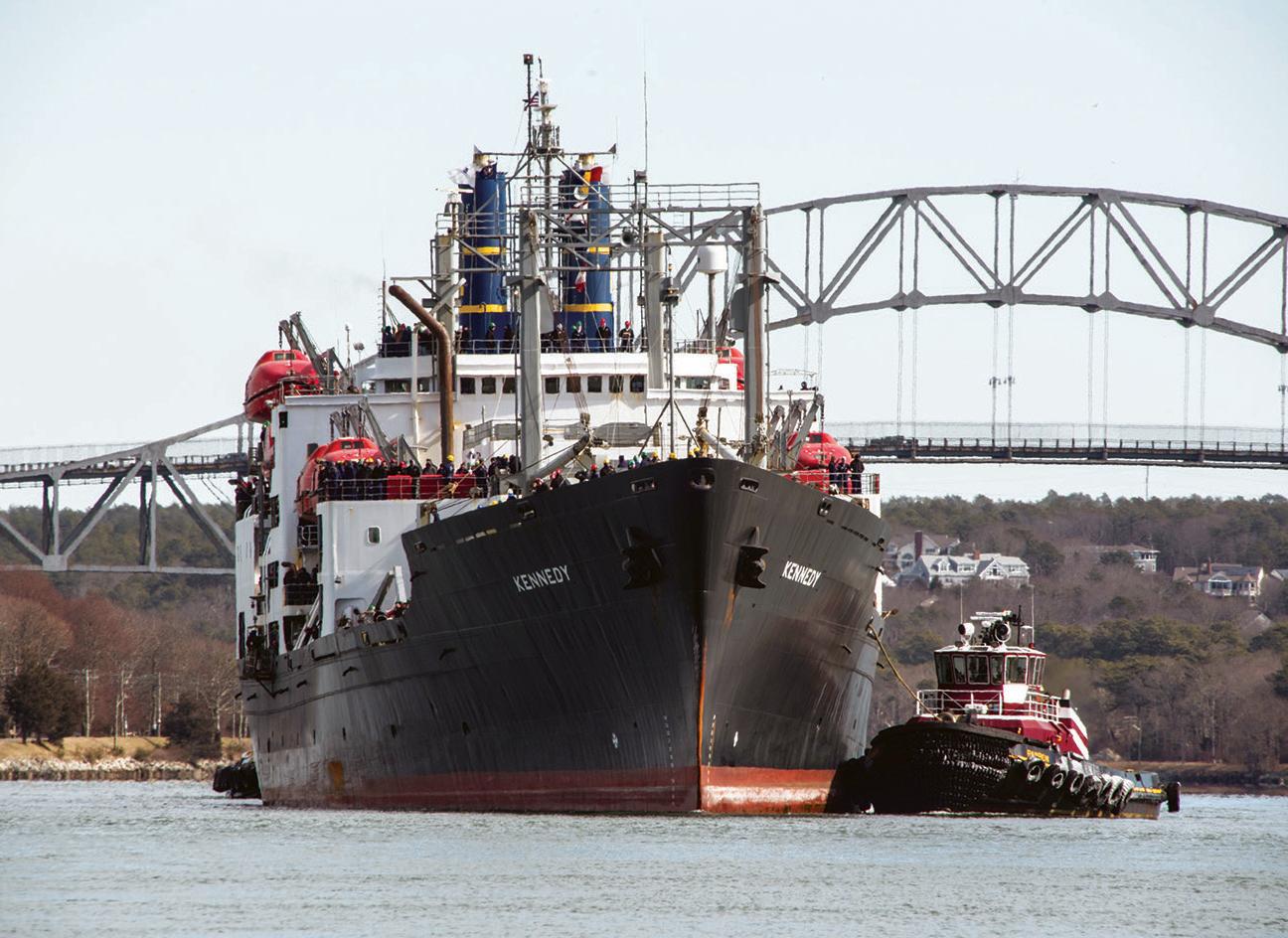

Students are invited to go to sea (virtually) with the MMA students during their sixweek voyage aboard the academy’s training ship, TS Kennedy. Through cadet blogs, the captain’s log, photos, videos, special features, and a specially designed curriculum for schools, K–12 students will follow along as cadets tackle everyday shipboard tasks and challenges they encounter at sea. Weather forecasting, navigation and maneuvering, calculating and dealing with ocean currents, and practical experience operating a merchant ship at sea, plus maintenance tasks, including rust removal, engine and generator maintenance, treating sewage, firefighting, and seawater desalination, are just some of the activities you can witness as they happen.
Cadets are required to complete at least one sea term, and those majoring in marine engineering or marine transportation will do at least four sea terms aboard the academy’s training ship and in working commercial ships. There are six state and one federal maritime academies in the United States, and all have sea terms. A sea term is not a pleasure cruise. The voyage lasts about 6–8 weeks, and during that time a cadet will rotate through class and laboratory training at
sea, vessel operations including deck and engine watches, maintenance work, and emergency drills. You can follow along on your own, or your school can register for the program and take advantage of resources and other educational materials provided. Learn about the maritime academy experience from the cadets themselves and see what a seagoing career is like. Share this article with a teacher at your school, and ask them to reach out to the program coordinator, Nancy Franks, at ftv@maritime.edu by 21 December 2022. (www. maritime.edu/follow-the-voyage)
Cadets share their unvarnished experience during the Sea Term. A maritime academy for college is not for everyone, but it is just right for some. This cadet is maintaining a sense of humor in the cramped and shared berthing areas.
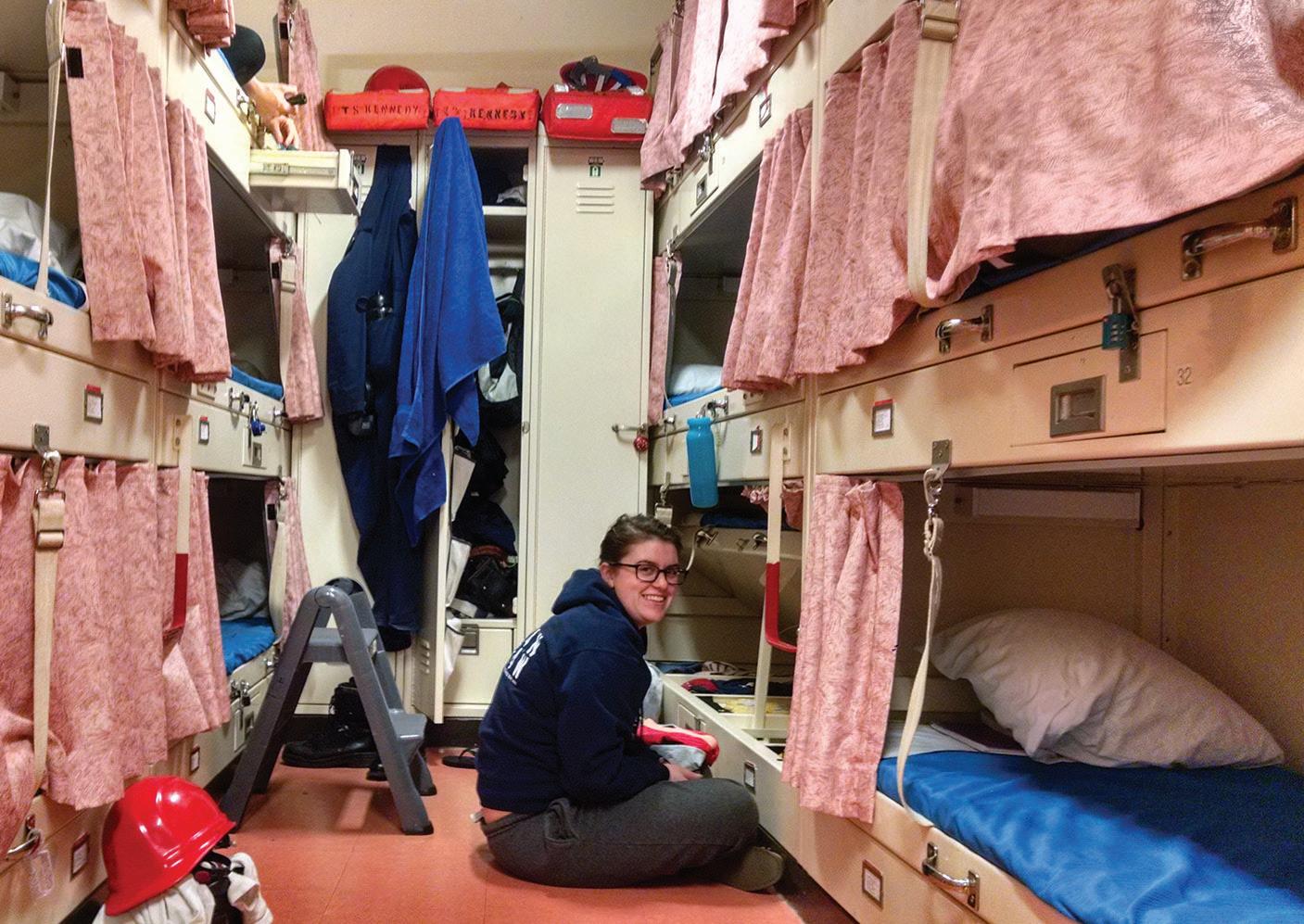
43
The MMA training ship TS Kennedy was launched in 1967 as the Velma Lykes . This will be the final Sea Term for this ship, as the academy prepares to welcome its new training ship, Patriot State II, in 2024.
Cadets navigate on the ship’s bridge under the supervision of instructors and the professional crew.
all
maritime academy
photos courtesy massachusetts
Animals in Sea History
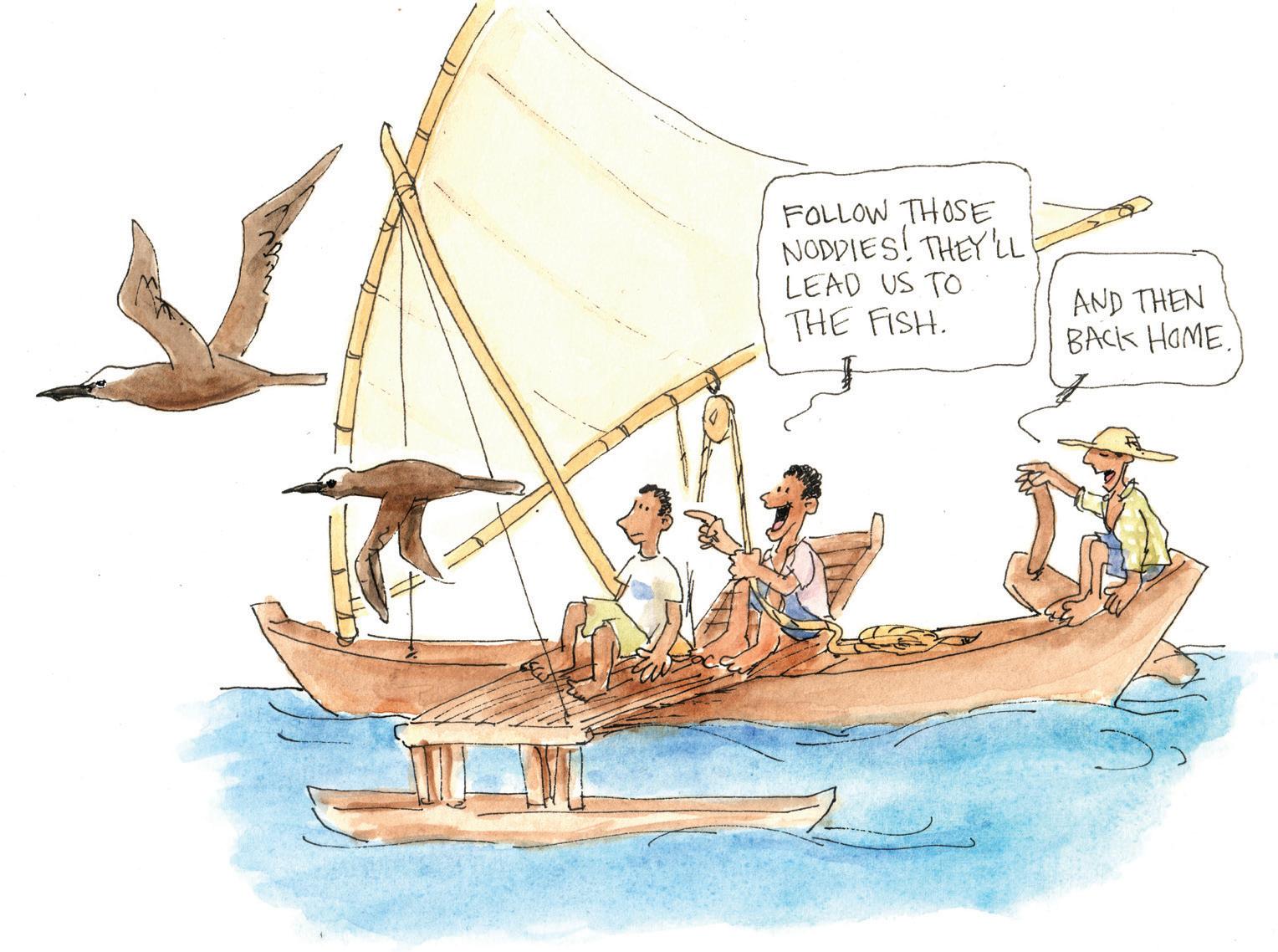

hen on his outbound passage aboard HMS Beagle, 22-year-old Charles Darwin failed to see the beauty, intelligence, and the usefulness to humans of the seabirds he observed in the tropics . In February of 1832, Beagle’s captain anchored the ship off St. Peter and St. Paul Rocks, a little archipelago of low-lying islands in the equatorial Atlantic.
We only observed two kinds of birds, the booby and the noddy . . . Both are of a tame and stupid disposition, and are so unaccustomed to visitors, that I could have killed any number of them with my geological hammer. The booby lays her eggs on the bare rock; but the [noddy] makes a very simple nest with seaweed. By the side of many of these nests a small flying-fish was placed; which, I suppose, had been brought by the male bird for its partner.
Charles Darwin, HMS Beagle, 1832
The brown noddies transit across all oceans, preferring tropical and subtropical seas and islands for roosting and nesting. Their only breeding island in the United States is on one spot in the most distant of the Florida Keys, but their worldwide populations seem reasonably stable today, with nesting populations on islands around the world including St. Peter and St. Paul, Hawai‘i, the Phoenix Islands, and the Galápagos, as well as islands off both western and eastern Australia and in the Red Sea.
Young Darwin was hardly the first to demean the intelligence of noddies and other seabirds. James F. Stephens had a few years earlier published a similar judgment of noddies: “They are said to be a very stupid race of birds, and to allow themselves to be knocked on the head without attempting to remove from
 by Richard J. King
by Richard J. King
Brown noddies at the nest at Michaelmas Cay, within the Great Barrier Reef, Australia.
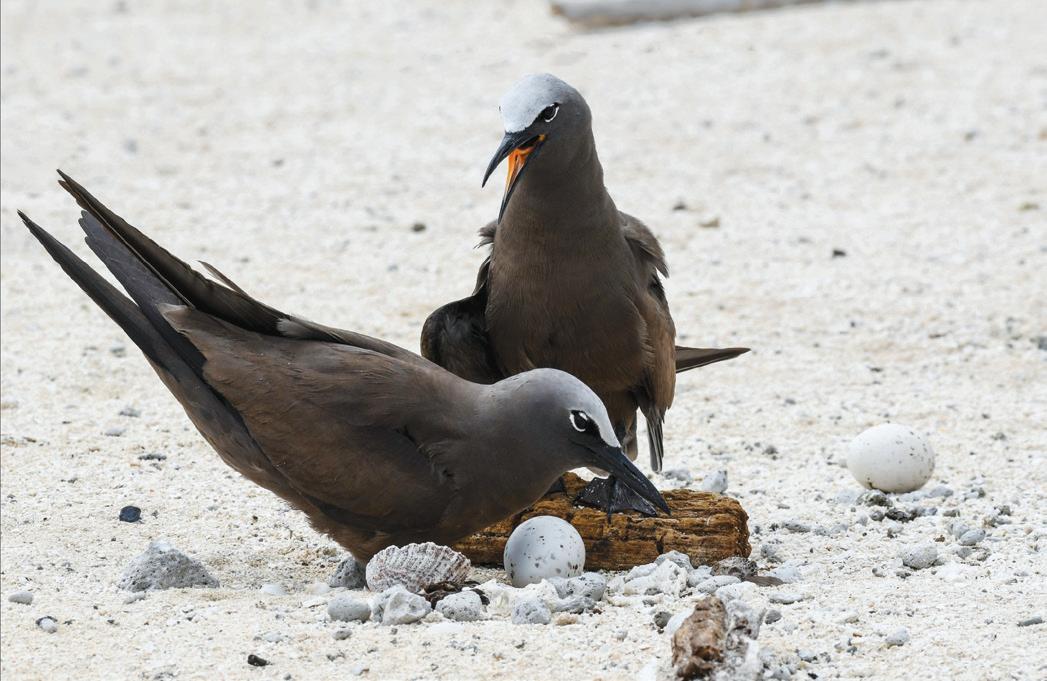
the place; they are usually of very dark and somber colours.” The scientific genus name for noddies, Anous, means silly or clueless in Greek, and the brown noddy’s species name, stolida, means slow or dull in Latin. Stephens wrote that the common name, “noddy,” comes from “their apparent stupidity flying into ships,” as well as allowing themselves to be caught—although, he reported, they put up a scratching fight once captured.

44
macaulay library, cornell lab of ornithology ( ml 51740691)
Brown noddy flying low over the Great Barrier Reef, Australia
courtesy www jjharrison com au
Around this same time, John James Audubon was sailing aboard a ship in 1826, bound for London from New Orleans through the Straits of Florida. In his journal he sketched a detailed and life-sized illustration of a brown noddy that one of the crew had captured when the bird landed on one of the ship’s booms. “I know nothing of this Bird more than what Our Sailors say,” Audubon wrote, “that it is a Nody and frequently alights about Vessels in this Latitude.”


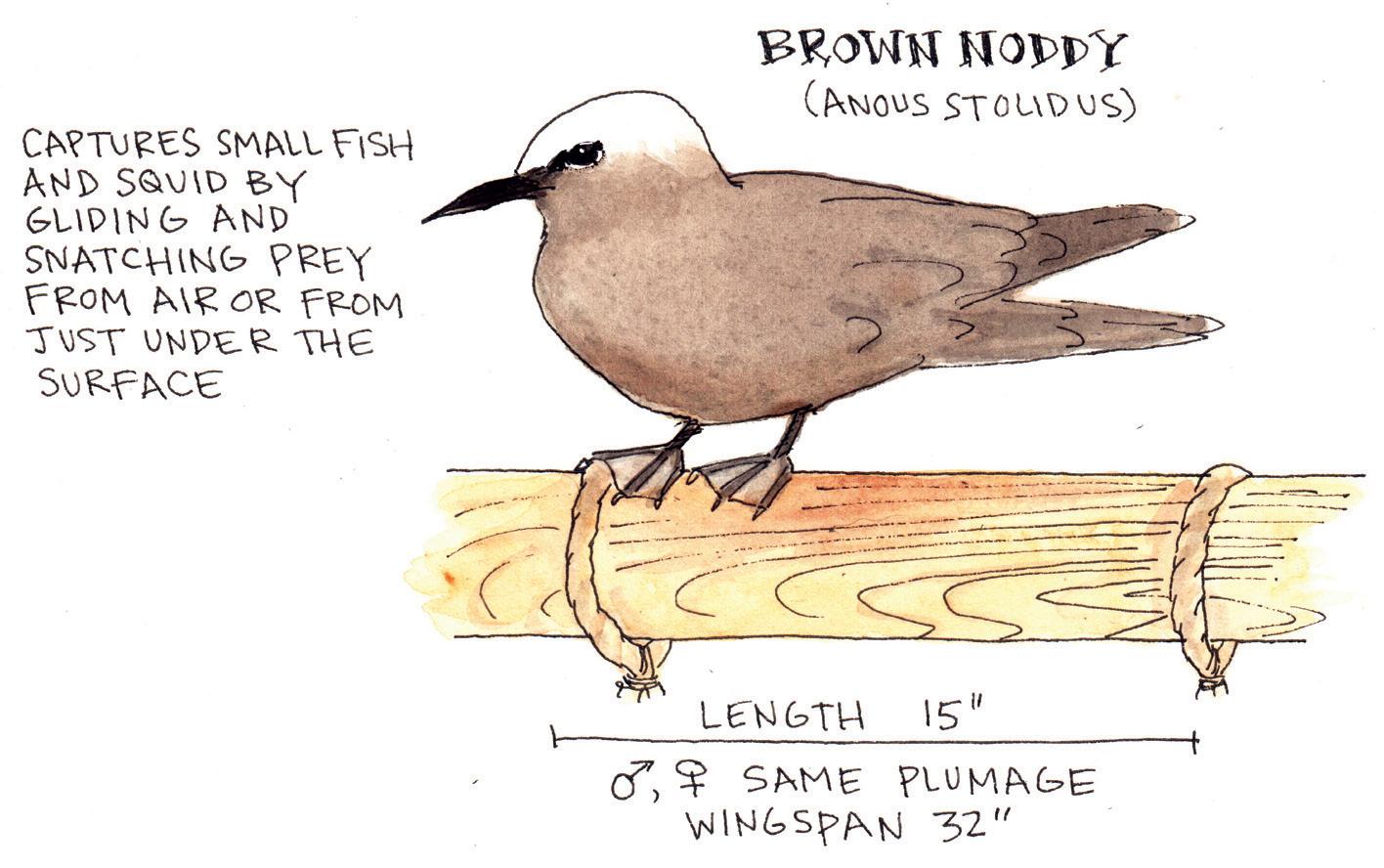
During this era, in England noddy was a slang word for “sleepy,” but also an adjective for simple and foolish—even idiotic, which was used as far back as the 1500s. A more recent derivation of the name noddy, while perhaps more charitable but likely not correct, is that the name refers to the ways that noddies bow as part of their mating ritual. Both males and females move their beaks up and down very close to each other, as if they’re continually agreeing with one another—very much nodding.
What Darwin and many of the other lubberly 19thcentury naturalists and explorers missed about noddies and other groups of seabirds is that not only had these animals not yet learned to be afraid of people, but that ocean-reliant Indigenous communities for millennia have relied on select seabirds, including noddies, to help them find fish on the surface, as well as to help them navigate when out of sight of land.
In the Indian Ocean, for example, noddies regularly join feeding frenzies over schooling fish, capturing the smaller fish, squids, or crustaceans scared up by tuna
and dolphinfish. Noddies don’t carry their fish home in their beaks, but swallow their food and then regurgitate it back to their young ashore. This is likely what Darwin saw—regurgitated flying fish beside the nest. For centuries before modern fish-finding technology developed, fishermen off the Maldives used noddies specifically to locate schools of skipjack tuna.
In the Pacific, noddies are some of the most useful birds for traditional navigators, especially those sailing among low island atolls. Not only do flocks of noddies go home to roost each night, they tend to range farther from shore than other daytime foragers. In the late 1960s Teeta Tatua of Kuria, a master navigator from the Gilbert Islands, explained to sailor-anthropologist David Lewis: “Birds are very useful up to twice the sight range of an island from a canoe. The sight range of land is about ten miles, and that of the birds twenty. The birds which are most significant are terns and noddies.” At sunrise or near dusk, a flock of noddies flying inbound or outbound draws a clear path in the sky toward land. Modern studies have confirmed the range reported by Teeta Tatua, although brown noddies in the eastern Indian Ocean have been observed flying some 125 miles from their avian colonies to fish.
Take that, Darwin, you noddy!
For more Animals in Sea History see www.seahistory.org or educators.mysticseaport.org.
“Sea H
Foundation 45
istory
for Kids” is sponsored by the Henry L. & Grace Doherty C
haritable
John James Audubon drew a “Size of Life” noddy in his journal from a bird that landed on his ship in the Straits of Florida in 1826.
courtesy of the field museum , chicago
Explore the decks of the last Destroyer Escort afloat in America. 518-431-1943 ussslater.org

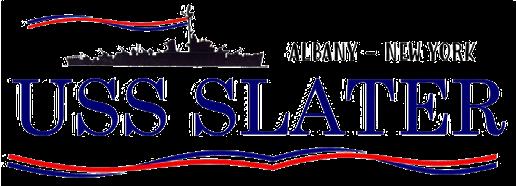
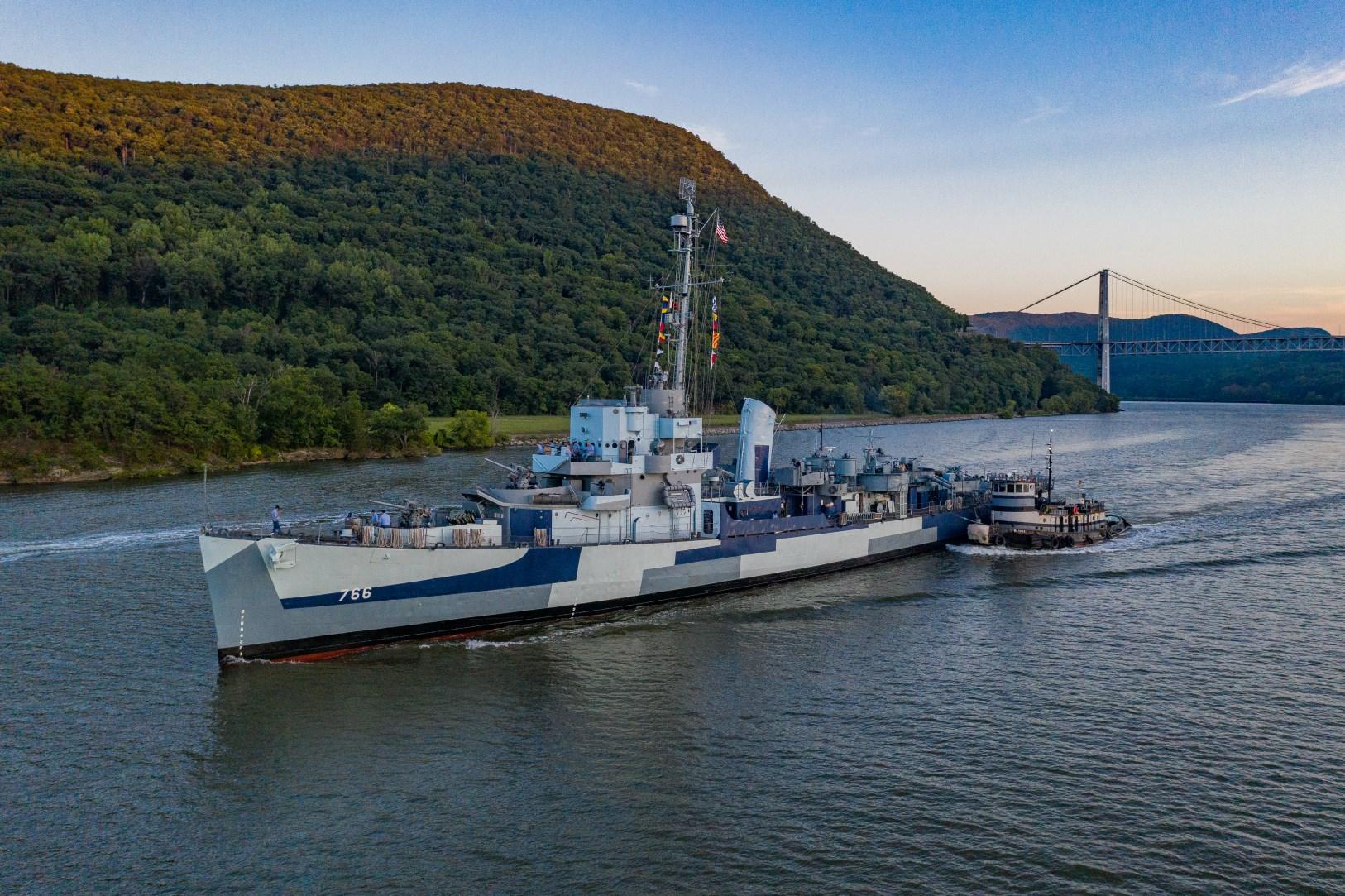

World Ocean School has acquired the replica Great Lakes cargo schooner Denis Sullivan from the Discovery World Science and Technology Center in Milwaukee, Wisconsin. e Sullivan had been engaged in educational sails, public day sail and private charters for Discovery World, as well as serving as Wisconsin’s agship. In the last couple of years, she was idled by the pandemic, and Discovery World had let go of their captain and remaining crew. e museum determined the best course of action was to nd her a new steward. Meanwhile, the acquisition allows the Boston-based World Ocean School to continue its sail training and educational programming in New England and St. Croix aboard the Sullivan, while its historic schooner, Roseway, will undergo what is described as “a 100-year restoration,” at Mystic Seaport Museum’s Henry B. duPont Preservation Shipyard. e schooner’s “surgical deconstruction” and comprehensive hull replacement is expected to take about three years, with a price tag of over $8 million. As of press time, Denis Sullivan was secure at the dock in St. Petersburg, Florida, after motoring 1,296 miles from Lake Michigan down the Mississippi River (with her masts removed to t under bridges), and then across the Gulf of Mexico. Her masts, shipped separately via atbed truck, are being stepped in St. Petersburg, from whence she will depart for scheduled programming in the US Virgin Islands. e schooner represents a typical Great Lakes cargo schooner of the 19th century. Denis Sullivan was designed by Timothy Graul Marine Services, who turned for inspiration to the schooners designed and built by William Bates in Manitowoc, Wisconsin, in the 1800s. She was constructed over a veyear period by the non-pro t Wisconsin Lake Schooner Education Association (WLSEA) on the downtown Milwaukee waterfront. She was launched in 2000, after some serious logistics calculation; port engineers determined that the weight of two cranes couldn’t safely be supported by the ground and pilings where the ship had been built, so lowering her into the water via that method was ruled out. Eventually a steel cradle had to be built under the hull, and the whole structure was rolled onto a barge and transported to Milwaukee’s heavy
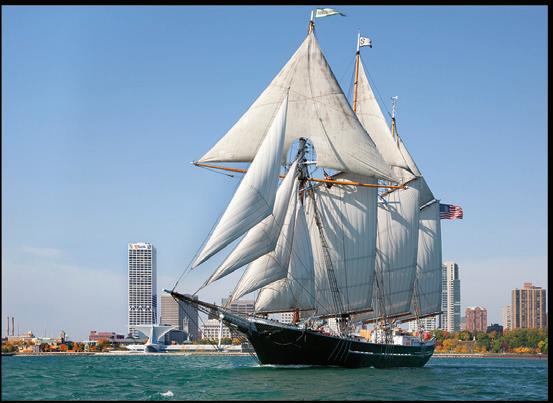
46 SEA HISTORY 181, WINTER 2022–23
Denis Sullivan, with her spars on deck, passing underneath a bridge on the Calumet River, as her crew heads for the Mississippi River from Lake Michigan.
(
) discovery world
courtesy world ocean school and
inset
lift dock for the transfer into the water. To honor the schooner’s historic ties with that city, World Ocean School intends to invite students from Milwaukee on sails aboard the Sullivan. e 96-year-old schooner Roseway was designed by John James, and she was launched from the shipyard owned by his father, Everett James, in Essex, Massachusetts, on 21 November of 1925. She is described in her nomination to the National Register of Historic Places as “the only known surviving example of a type originally developed to compete in yearly international races of shing vessels.” Her original owner was Massachusetts lawyer Harold F. Hathaway, who sailed her as a

shing yacht out of Newport, Rhode Island, until he sold her in 1941 to the Boston Pilots. By May of 1942 she had been commissioned Coast Guard Reserve Craft CGR-812 and assigned to the First Naval District (New England). Painted gray and given a 50-caliber machine gun on deck, Roseway helped guide ships to safety through waters that were littered with mines and anti-submarine netting, earning formal USCG recognition for her wartime service. Returned to the Boston Pilots in November 1945, she served as a harbor pilot until her sale in 1972. At that time, Roseway was the last sailing pilot boat in the United States. Over the following decades she changed hands several times, engaged in sword shing and then passenger sails, but by the late 1990s she had lost her USCG certi cation to carry passengers due to deterioration, and she was eventually repossessed by the bank. In 2002 she was purchased by Dwight Deckelmann and Abby Kidder to found World Ocean School. After a major restoration e ort, Roseway entered service for the organization in 2003 as a oating classroom, sailing in
CANNONS
CANNONS
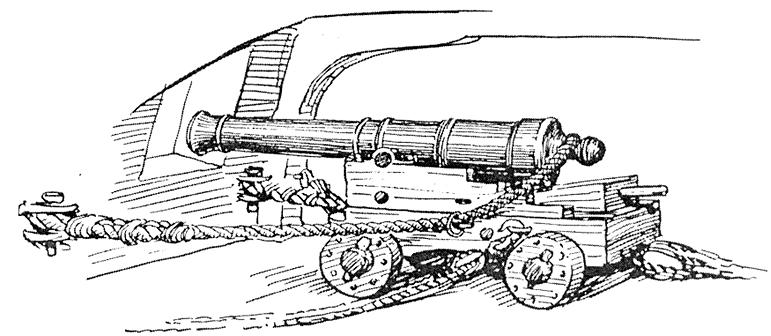

Finely Crafted Marine Grade Working Replicas
Finely Crafted Marine Grade Working Replicas


Morehead City, NC USA 252-726-5470 www.bircherinc.com
Morehead City, NC USA 252-726-5470 www.bircherinc.com
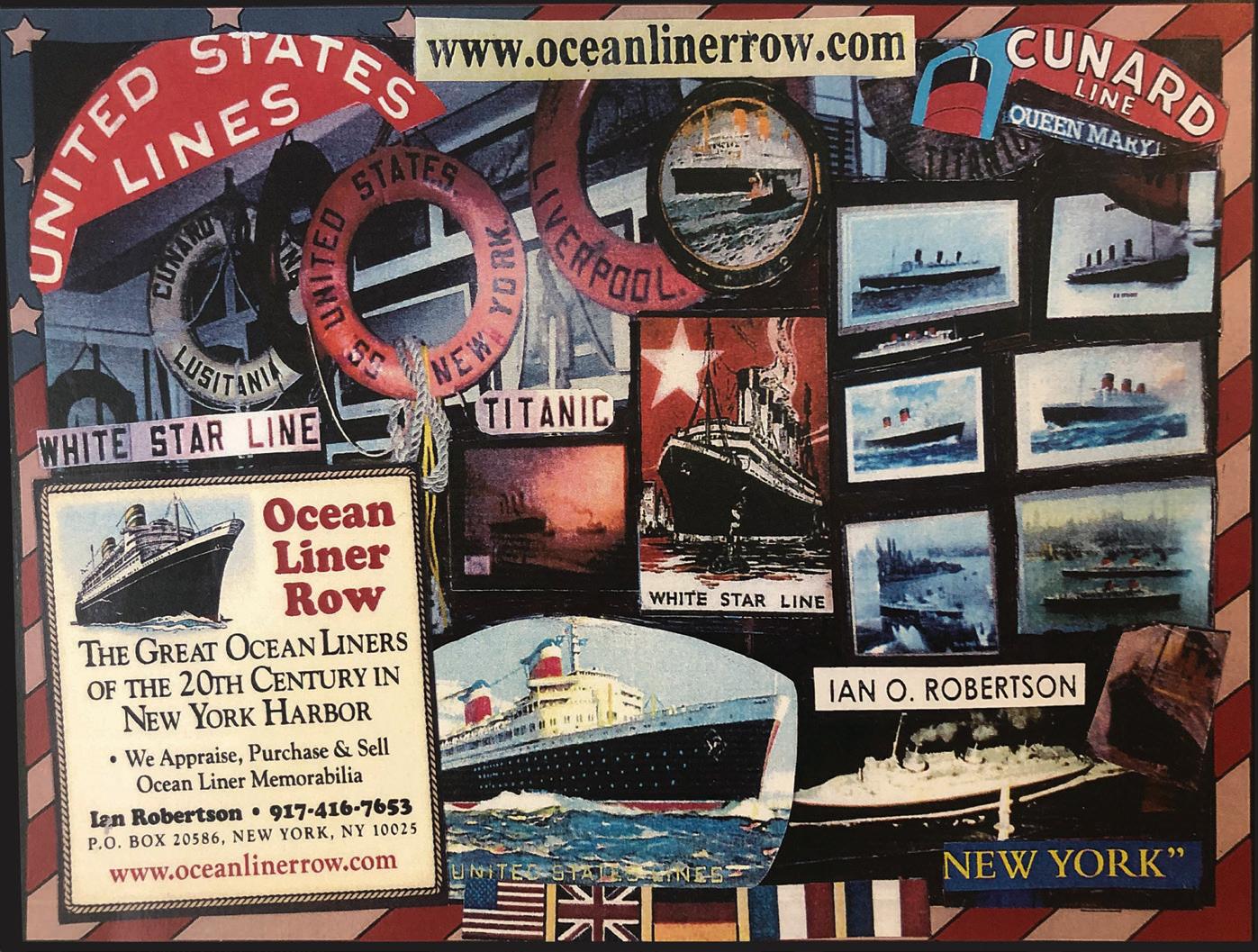
SEA HISTORY 181, WINTER 2022–23 47 MAINE WINDJAMMER CRUISES ® SELECT YOUR A DVENTURE ! Choose from 4 TradiTional sailing Vessels SWIFT Luxury Windjammer Sailing M ay – October Weekend 7-Day Cruises $755 and up Free 16-page Brochure 1-800-736-7981 NEW!
Open daily on the Mississippi River in Downtown Baton Rouge www.usskidd.com • 225 342 1942 • info@usskidd.com
USS KIDD
Beaufort Naval Armorers
Beaufort Naval Armorers
Schooner Roseway
world ocean school
the summer out of Boston and then in St. Croix, US Virgin Islands, in the winter season. (World Ocean School, PO Box 51091, Boston, MA; www.worldoceanschool.org) … e last surviving battleship to serve in both world wars has been moved to dry dock for an extensive $35 million restoration. USS Texas (BB-35), “the last of the dreadnoughts,” was towed from her former berth at the San Jacinto Battleground State Historic Site on 31 August and transported to Gulf Copper & Manufacturing Corporations’ Galveston Shipyard, where she was hauled out and settled into the dry dock purchased speci cally for this project from Grand Bahama shipyard. As of press time, the crew was removing the torpedo blisters and carefully removing the temporary foam underneath, which would present a re hazard for any work, such as welding, that could produce ames or sparks. It is hoped that the work will be completed by June of next year. e museum ship has been closed to the public since 2019. e Battleship Texas Foundation (BTF) operates the veteran warship under a 99-year memorandum of understanding from the Texas Parks and Wildlife Department (TPWD), which owns the battleship. In 2019, the Texas legislature passed SB1511 directing TPWD to enter a 99-year lease with a quali ed
non-pro t to operate the ship. In the same session, the legislature appropriated $35 million to fund the shipyard work. (BTF, One Riverway, Suite 2200, Houston, Texas; 832 841-3500; www.battleshiptexas.
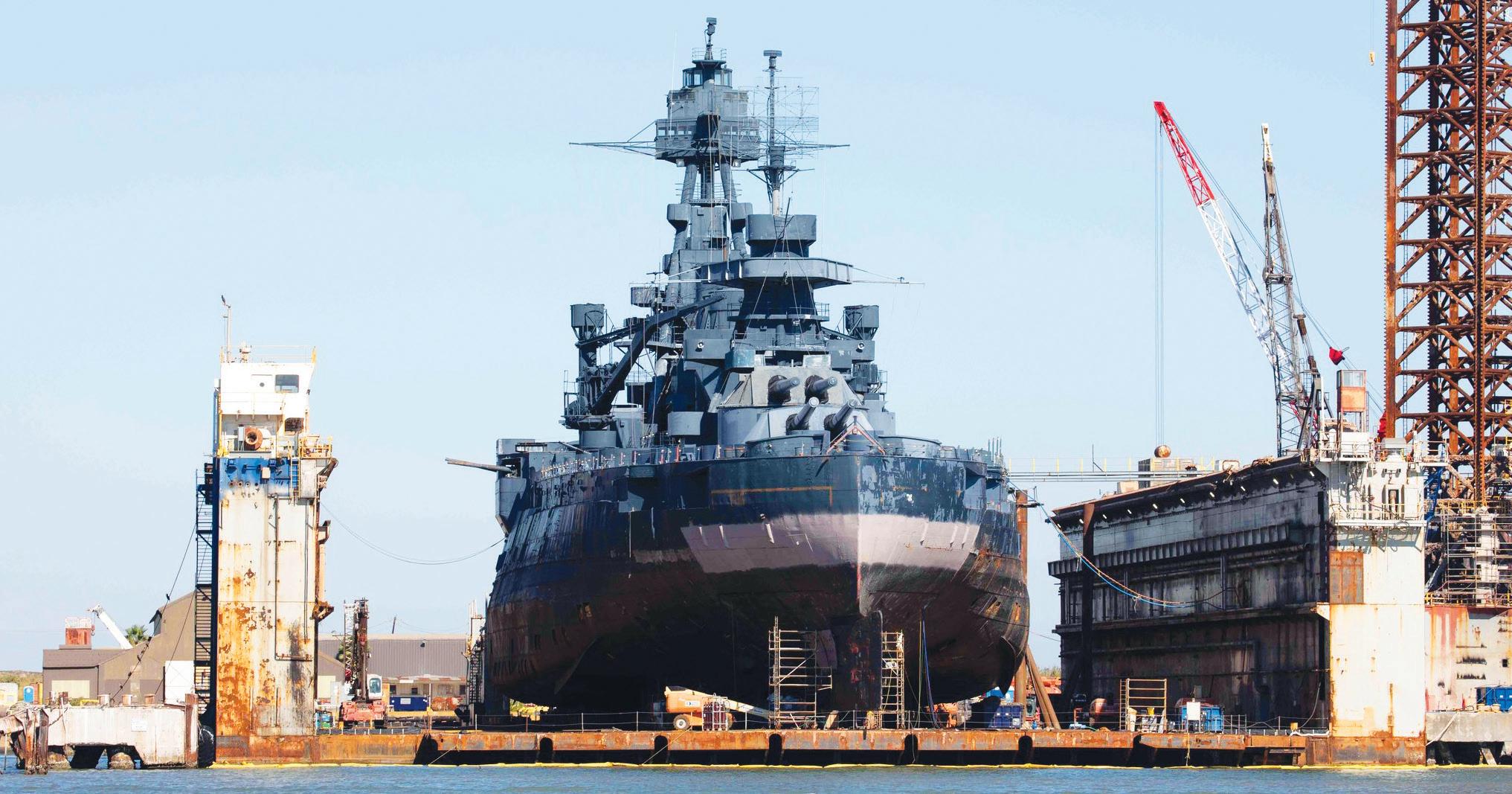
org ) … In late September the Tall Ship Providence Foundation announced its partnership with the country’s largest shipbuilding company, HII. e shipbuilder has committed $1 million for the foundation’s 4th Grade Education Program, with the goal of educating all fourth graders in Virginia about the history and continuing importance of shipbuilding to the nation. Students will learn about shipboard life in the 18th century, the history of the Revolutionary War sloop Providence, and her role—and that of other ships like her— in the American Revolution. Inspired by the rst warship authorized by the Continental Congress for the Continental Navy, the replica sloop Providence was built in Newport, Rhode Island, and completed in 1976. She was commissioned by John Fitzhugh Millar and designed by naval architect Charles Wittholz, following the general examples of Rhode Island sloops of the period. Unlike many replicas of historic wooden sailing ships, berglass was chosen for the hull material to extend the vessel’s longevity. She was originally intended to be part of a eet of vessels
associated with the Newport waterfront, but in the mid-1990s she was given to the city of Providence as a sailing ambassador. She was later managed by the Providence Maritime Heritage Foundation, which developed a sail training program for the vessel; she appeared in the second and third installments of the Pirates of the Caribbean lm franchise. Facing nancial difculties, the foundation sold her to charterboat captain orpe Leeson in 2011. While the sloop was in dry dock in Newport Shipyard in 2015, a winter storm caused one of the supporting jackstands to collapse and the sloop fell on her side, shattering her mast and spars and puncturing the berglass hull. In 2017, orpe sold Providence to the Tall Ship Providence Foundation to serve as an educational vessel based in Alexandria, Virginia. e TSPF is still in the process of nalizing the timeline for construction of the planned Senator John

48 SEA HISTORY 181, WINTER 2022–23
tall ship providence fdn
holt
Sloop Providence photo by
rudi
USS Texas in dry dock.
Warner Maritime Heritage Center, but it is hoped the structure will be welcoming visitors in the 2023 season. Said Will Downing, the foundation’s manager of operations: “Our plan is to focus heavily on the ‘living history’ aspect of our mission…We’re in the process of putting together a whole new visitor experience and are excited to make it a reality. Our tours will retain some elements of what we have o ered in years past, but with a heavier emphasis on immersion and interactivity, so it will be an entirely new experience for folks who have already visited us as well as people who haven’t yet had the chance.” HII is an all-domain defense and technologies partner headquartered in Virginia with a 135-year history of partnerships in advancing US national security. Providence is docked at G-H Pier in Founders Park at Old Town Alexandria. She will remain there until she shifts to her permanent berth at the Senator John Warner Maritime Heritage Center in early 2023. Senator Warner (1927–2021) was recognized in 2010 with the NMHS Distinguished Service award for his service in the
US Navy, as under-secretary and later Secretary of the Navy, US senator, and chair of the Senate Armed Services Committee. (PMHF Ticket O ce, 1 Cameron St., Alexandria, VA; www.tallshipprovidence.org. HII, www.hii.com) … In September, USS Orleck (DD-886) was opened to the public at her new homeport in Jacksonville, Florida . e ship was towed to Jacksonville from the Gulf Coast in March 2022 to serve as the centerpiece for the new Jacksonville Naval Museum, home base for the Jacksonville Historic Naval Ship Association. e JHNSA was initially established to create the USS Charles F. Adams Naval Ship Museum, but when the US Navy decided to scrap the Adams, JHNSA was contacted by the USS Orleck Naval Museum to see if the organization might consider acquiring the museum warship. Late in 2021, Orleck was moved from its Louisiana berth to the Gulf Copper and Manufacturing Corporation shipyard in Port Arthur, Texas, for a survey and repairs before being acquired by the JHNSA. e Gearing-class destroyer was launched on 12 May 1945 at Consolidated Steel Corp.
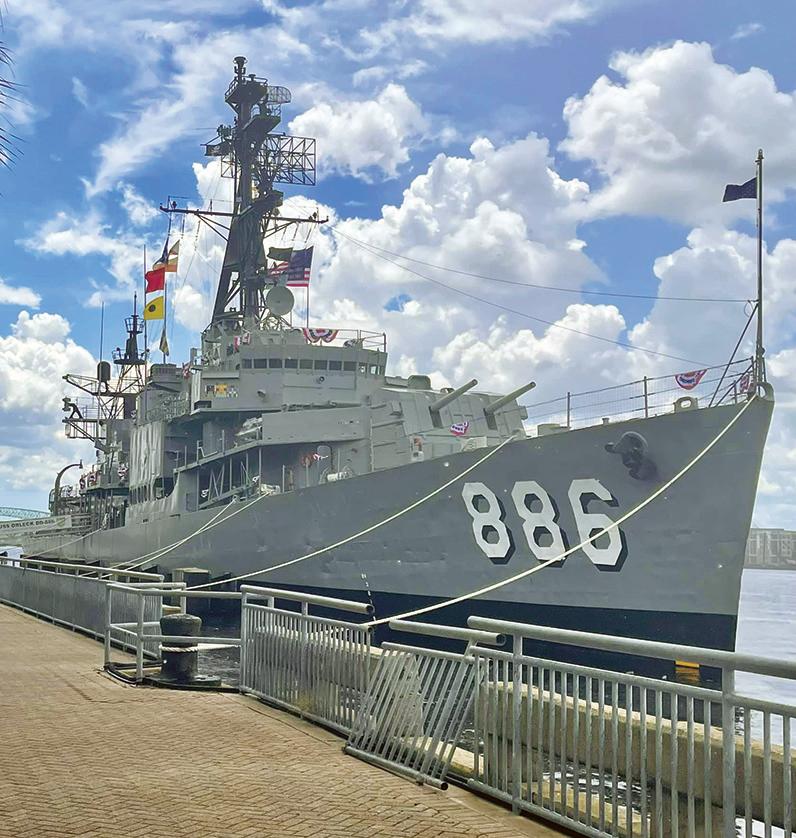

of Texas in Orange, Texas. She was named for Lt. Joseph Orleck, USN. Lt. Orleck died when his ship, USS Nauset, was struck by bombs during the amphibious invasion of Italy on 9 September 1943. He directed re ghting e orts and transfer of survivors to other ships and went down with the ship, when it subsequently struck a mine and sank. He was awarded the Navy Cross, the American Defense Service Medal, the European-African-Middle Eastern Area Campaign Medal, and the Purple Heart.
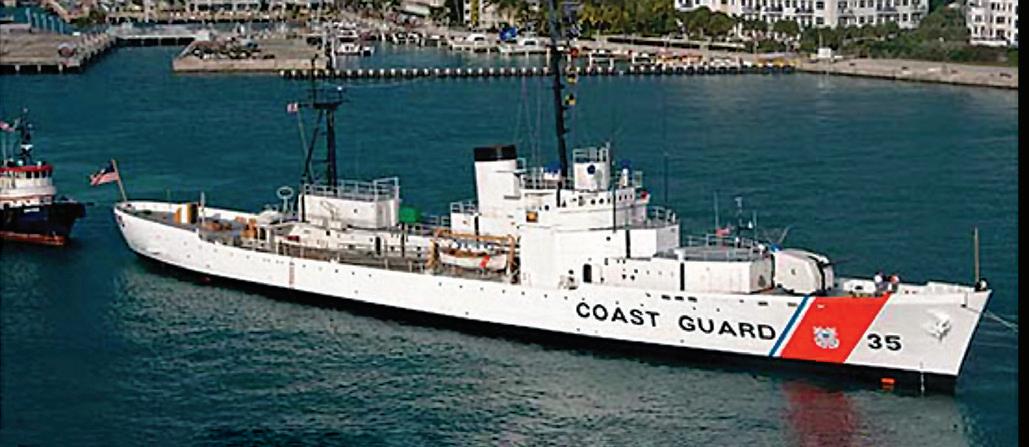
SEA HISTORY 181, WINTER 2022–23 49 ... • • •
USS Orleck
jacksonville naval museum
CLASSIFIED ADS
LIEUTENANT JACOB STARKE SERIES. Apalachicola Publishing. Captain Michael T. Ribble’s historical novels leading up to and through America’s war with Spain. A realistic and accurate portrayal of this dynamic era’s technological, social, and political change as the Navy tries to avert war by preventing libustering expeditions to Cuba. Set in Washington, Norfolk, Key West, and Cuba, these novels strive for accuracy and believability. Available through Amazon, Barnes & Noble, Powell’s, and others.
CUSTOM SHIP MODELS , HALF HULLS. Free Catalog. Spencer White, 4223 Chestnut Dr., Center Valley, PA 18034.
FINE ART PRINTS OF SEA ROVERS & BUCCANEERS by award-winning ASMA Signature artist Don Maitz. Visit: www.paravia.com/DonMaitz.
BOMBSHELL by T. F. McGraw. e little-known Civil War tale of a humble New York canal boat, rushed to conversion at New Berne in 1863, into a multipurpose steam gunboat. Operating on the coastal rivers of North Carolina, Bombshell delivered Army raiders and provided them artillery cover, evacuated Freedmen, and performed many other missions. Succumbing to battle damage in late 1864, Bombshell was stricken from the rolls under her original name, the Oscar F. Burns, e ectively condemning the plucky little ship to obscurity—until now. Paperback, 204 pages, illustrated. $20.00, including shipping and applicable taxes, directly from Indian Creek, PO Box 14663, New Bern, NC 28561.
THE LOST HERO OF CAPE COD by Vincent Miles. e story of an elite mariner, Captain Asa Eldridge, and the nineteenth-century battle for commercial supremacy on the Atlantic. Reviews, availability, at www.vjmiles.com/lost-hero and Amazon.com.
KEEPING THE TRADITION ALIVE by Capt. Ray Williamson. e remarkable story of Maine Windjammer Cruises,TM founder of the windjammer industry. 172 page, 11 x 14 hardcover book with over 100 full-page images from the days of cargo to the present. Price–$48. Call 800 736-7981; email sail@mainewindjammer cruises.com.
PRESIDENTS PLAYING CARDS. All 46 US presidents are represented on these playing cards with interesting facts and quotes. www.presidentsplayingcards.com.
PIRATE PLAYING CARDS by Signature ASMA Artist, Don Maitz, National Geographic contributor and originator of the Captain Morgan Spiced Rum character. Full-color playing cards have di erent watercolor images on each face. Prints present sea-rover adventurers. Order from: www.paravia.com/DonMaitz.
THE AUTHORITY TO SAIL by Commodore Robert Stanley Bates. e fully illustrated authoritative history of US Merchant Marine licenses and documents issued since 1852. Co ee-table size book, 12” x 14.” Order direct: e Parcel Centre, Ph. 860 739-2492; www.theauthority tosail.com.
OUT-OF-PRINT NAUTICAL BOOKS
SEA FEVER BOOKS. ousands of titles. E-mail: seafeverbooks@aol.com; Ph. 860-663-1888 (EST); www.seafeverbook store.com.
NATIONAL PARKS PLAYING CARDS.
Many of America’s National Parks are represented on these cards with interesting facts and images. www.ArcturusLLC.net.
MARITIME GIFTS: Online at the NMHS Ship’s Store: www.seahistory.org/store. Books, gift memberships, artwork, nautical merchandise, and more. NEW: the 2023 Special Edition NMHS 60th Anniversary Wall Calendar.
Sea History magazine classi eds ads: $1.60 per word.
Contact Wendy Paggiotta at advertising@seahistory.org.
e last destroyer commissioned at the end of WWII, USS Orleck served in the Korean War—destroying two enemy supply trains and becoming the charter member of the “Train Busters Club”—and in the Vietnam War, earning a total of 18 battle stars in the two con icts. She was decommissioned in October 1982, and transferred to the Turkish navy, given the name Yücetepe, serving 16 years. She continued to serve in this capacity until being transferred back to the United States in August of 2000 to become a museum ship in Louisiana. Visitors can tour the ship at its temporary location at 114 East Coastline Drive in Jacksonville. Eventually, the ship will shift to a berth down the street at the Old Jacksonville Shipyard, once the museum building is completed. (JNM, www.jaxnavalmuseum.org)… A re the night of 18 October, on the waterfront of Stockton, California, destroyed a historic building belonging to Colberg Boat Works. is is a particular blow to the Stockton Maritime Museum, which had planned to relocate the building to serve as a shoreside facility alongside the WWII Aggressive-class minesweeper USS Lucid (MSO-458). Founded in late 1890s, Colberg Boat Works was one of ten Stockton shipyards active during WWII; together, they employed 10,000 workers and produced about 500 naval vessels, including air-sea rescue boats, mine sweepers, patrol boats, salvage ships, seaplane tenders, and submarine chasers. Lucid , an exact copy of three vessels built for the US Navy in Colberg’s yard, was launched on 14 November 1953 as AM-458 at Higgins Shipyard in New Orleans; she was redesignated MSO-458 on 7 February 1955. e minesweeper was decommissioned in 1976 and subsequently served as a houseboat, and later as a warehouse. Her machinery and equipment were removed prior to her acquisition by a group intending to save her as a museum ship. e Stockton museum has worked to restore her to a condition resembling that of her active career and is seeking donations of equipment and related memorabilia. (Stockton Historical Maritime Museum, 4290 Cherokee Rd., Stockton, CA; www.stocktonhistoricalmaritimemuseum.org ) …
50 SEA HISTORY 181, WINTER 2022–23
(continued on page 52)
In September the National Park Service, in partnership with the National Endowment for the Arts, the National Endowment for the Humanities, and the Institute for Museum and Library Services, announced the 2022 Save America’s Treasures grants totaling $24.25 million. Maritime projects included among the recipients were:
• e Paci c Fleet Submarine Memorial Association, Inc., awarded $500,000 for the dry docking of the WWII eet submarine USS Bow n.

• e Old Dartmouth Historical Society (New Bedford Whaling Museum), awarded $45,000 to conserve a panel from Charles Sydney Raleigh’s Panorama of a Whaling Voyage Around the World.
• e Fireboat Fire Fighter Museum, awarded $450,750 for the preservation of the reboat Fire Fighter.
•Independence Seaport Museum, awarded $54,204 for USS Olympia co erdam hull repairs.

• e Naval War College Foundation, awarded $137,833 for the conservation and digitization of the Naval War College and Naval War College Fdn. collections.
• e Wisconsin Maritime Museum, awarded $500,000 for the dry docking of the submarine USS Cobia for hull maintenance and repairs.
e Save America’s Treasures grants are funded by the Historic Preservation Fund, established in 1977 and the source of more than $2 billion in historic preservation matching grants to states, tribes, local governments, and non-pro t organizations, supporting a variety of historic preservation projects to help preserve the nation’s cultural resources and history.
2023 Calendar — Special 60th Anniversary Edition
The NMHS 2023 calendar commemorates the Society’s 60th anniversary and features stunning artwork and photographs from some of our most popular Sea History covers, including masterpieces by world-renowned marine painters Oswald Brett, Donald Demers, Russ Kramer, John Mecray, William G. Muller, Mark Myers, Patrick O’Brien, Robert Semler, John Stobart, and Len Tantillo, and photographs by Bill Higgins, John Spinnato, and Tamara Thomsen.

Full color 12-month calendar is wall hanging, saddle-stitched, and printed on quality heavyweight paper. 18” H x 12” W (open)
Special Price $13.60 plus $5.50 media mail s/h within the USA. NYS residents add additional sales tax. Please call for shipping charge for multiple or international orders.
TO ORDER, CALL 914-737-7878 ext. 0, or online at www.seahistory.org/calendar2023.
SEA HISTORY 181, WINTER 2022–23 51
USS Cobia, Wisconsin Maritime Museum
Save America’s Treasures
photo by kevin cullen , wmm
e Michigan Maritime Museum in South Haven held the grand opening for its new Maritime Heritage Center on 30 September, barely a year after its original museum building was demolished. e museum held a ribbon-cutting for the center in July, and visitors have been able to tour the new building and renovated spaces, as well as explore the new exhibit, Full Steam Ahead: e Golden Age of Great Lakes Passenger Steamships, but some of the furnishings still weren’t in place at that time due to shipping and supply issues. e $3.6 million, 17,000-square-foot Heritage Center features an exhibition hall, a two-story atrium, space for classes and workshops, a reception area, o ces, conference rooms, an event space, and a catering kitchen for events. It is a major component in the museum’s $8 million “Launching a Legacy” expansion project, which included expanding the museum campus to encompass local historic shery buildings and increase access to the waterfront. “We are truly debuting a brand new campus that will allow us to tell complete and complex stories about our state’s maritime heritage in exciting and interactive ways,” said executive director Patti Montgomery Reinert. Full Steam Ahead is the museum’s centerpiece exhibit; it explores the history and stories of the luxury passenger steamers that traveled the Great Lakes in the early 20th century. (MMM, 260 Dyckman Avenue, South Haven, MI; www.michiganmaritimemuseum.org ) … e Great Lakes Shipwreck Historical Society (GLSHS) reported in October that it has located the wreck site of the whaleback vessel Barge 129, which sank in 1902 in Lake Superior. Using side scan sonar, the GLSHS initially located the barge—along

with eight other wrecks—in 2021, in partnership with Marine Sonic Technology. e vessel is heavily damaged; GLSHS Director of Marine Operations Darryl Ertel Jr. reported that “It’s nowhere near intact. It’s at least four to ve big pieces and thousands of little pieces. It’s just disintegrated.” e whaleback boat was a Great Lakes innovation of Capt. Alexander McDougall, who manufactured 43 vessels between 1888 and 1898. McDougall’s steel-hulled boats had a at bottom and curved sides; the elements of their design were intended to present a low pro le, reduce resistance, and o er few surfaces that would retain water. ey earned the name “whaleback” due to their curved deck, but thanks to the upturned snout-like bow they were also called “pig boats.” eir unique

design limited their size, however, and as shippers sought out larger cargo vessels, the whaleback fell out of favor. e last surviving intact whaleback is the museum vessel Meteor, located on Barker’s Island, Wisconsin. Launched on 13 May 1893 in West Superior, Wisconsin, Barge 129 served McDougall’s American Steel Barge Company (ASBC) until she was sold to the Bessemer Steamship Company, which was absorbed by Pittsburgh Steamship Co. the following year. On 13 October 1902, Barge 129 was being towed by the steamer Maunaloa on Lake Superior during a storm. About 30 miles northwest of Vermilion Point, the towline parted, and in the course of the crews’ attempts to re-rig another, Maunaloa’s anchor punctured several of the barge’s hull plates. She took on water and sank quickly. Her crew was able to board Maunaloa safely. (Great Lakes Shipwreck Museum – White sh Point, 18335 N. White sh Point Road, Paradise, MI; Ph. 888 492-3747; www.shipwreckmuseum.com; www.superiorpublicmuseums. org/ss-meteor) … Mystic Seaport Museum has been awarded a grant of $236,788 to recover and improve negatives in its Rosenfeld Collection of Maritime Photography a ected by vinegar syndrome, a deterioration of cellulose diacetate that produces a vinegary odor. e three-year Institute of Museum and Library Services Collections Stewardship grant will fund two team members to evaluate, select, recover/treat, digitize, rehouse, and catalogue 5,000 images; the funding will dovetail with another active federal grant and ongoing private support to address this issue. e project’s goal is a sustainable model for ongoing in-house treatment of similarly a ected negatives,

52 SEA HISTORY 181, WINTER 2022–23
(continued from page 50)
(above) Barge 129 loading coal, c. 1895. Barge 129’s sonar image, Lake Superior.
Michigan Maritime Museum
michigan maritime museum great lakes shipwreck historical society
c patrick labadie collection , alpena
and to share ndings with the broader museum and archive community. e museum acquired the Rosenfeld Collection in 1984; it is one of the largest archives of maritime photographs in the US, comprising nearly one million pieces spanning the period from 1881 to 1992. Its foundation is the work of the Morris Rosenfeld & Sons photography business, extended by collections of plate images of the America’s Cup races around the turn of the 20th century produced by other photographers. rough its 100-plus-year span, the collection represents the progression of both photographic technology and the maritime world. Mystic Seaport hopes that the stories told in the photographs of crewmembers, voyages, and shipyards will illuminate perspectives beyond the traditional view of yachting as an elite interest. e museum reports that around 150,000 of the negatives in the

OSWEGO — “oldest US freshwater port” Open daily 1–5 pm
Offering dockside tours of vessels May thru October

West 1st Street Pier, Oswego, NY www.hlwmm.org 315-342-0480
For Sale — Six original Station Bills from SS United States
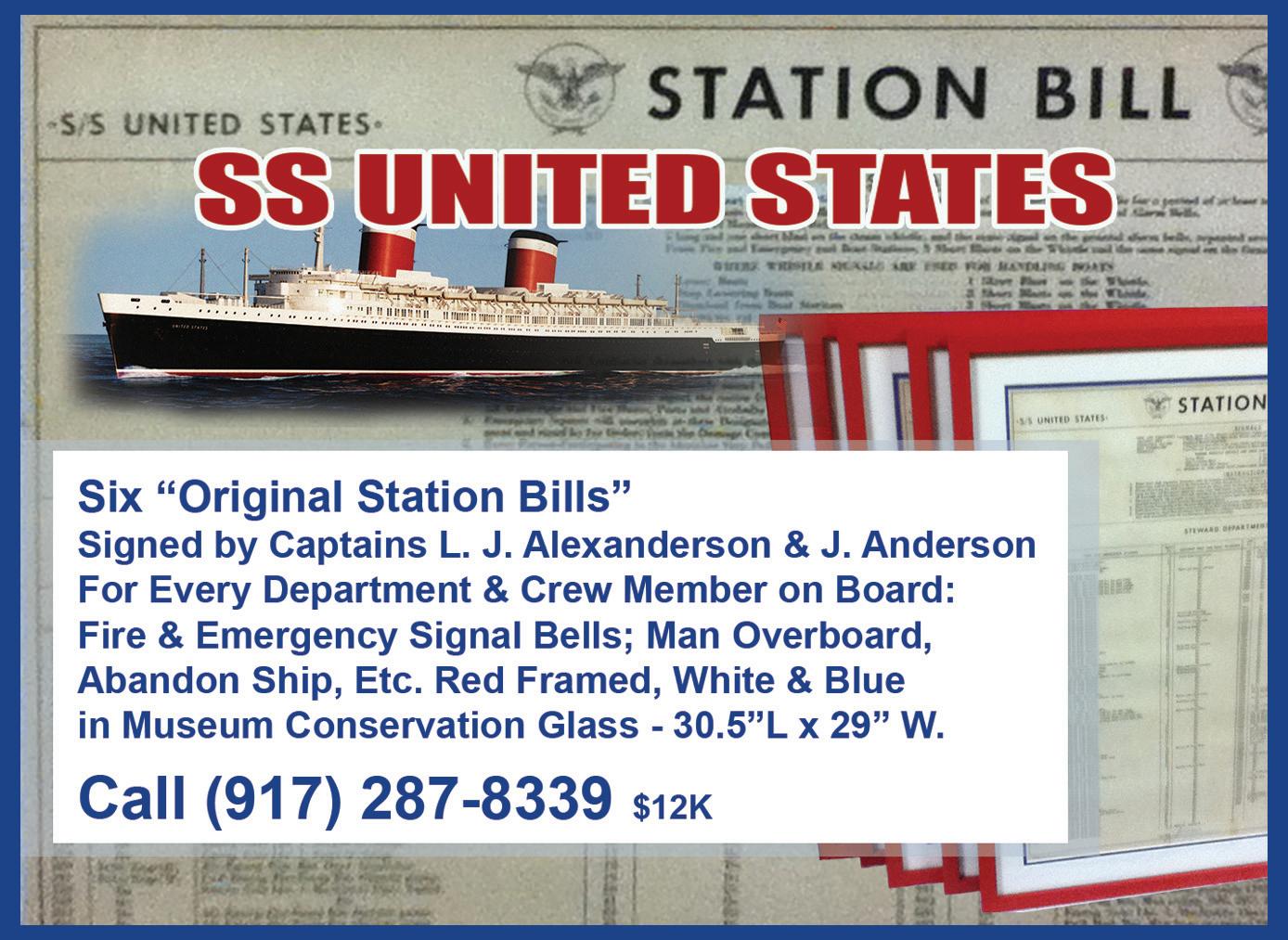
Signed by Captains L. J. Alexanderson & J. Anderson.
Station Bills for every department and crewmember: Fire & Emergency Signal Bells, Man Overboard, Abandon Ship, etc. Each document framed in red, matted in white with blue trim, protected by museum conservation glass.
Framed size: 30.5 X 29 inches • $12,000 for the collection. Call (917) 287-8339
Tired of nautical reproductions?

Martifacts has only authentic marine collectibles rescued from scrapped ships: navigation lamps, sextants, clocks, bells, barometers, charts, flags, binnacles, telegraphs, portholes, US Navy dinnerware and flatware, and more.

MARTIFACTS, INC.
P O BOX 350190
JACKSONVILLE, FL 32235-0190
PHONE/ FAX: (904) 645-0150 www martifacts com email: martifacts@aol com
SEA HISTORY 181, WINTER 2022–23 53
1/8 page AD
MARITIME MUSEUM AT OSWEGO H. LEE WHITE
mystic seaport museum , rosenfeld collection , 1984 187 144381f
Morris Rosenfeld & Sons: (l–r) David, Morris, Stanley, and William.
Rosenfeld’s Flying Spinnakers was featured on the cover of Life magazine in 1938.
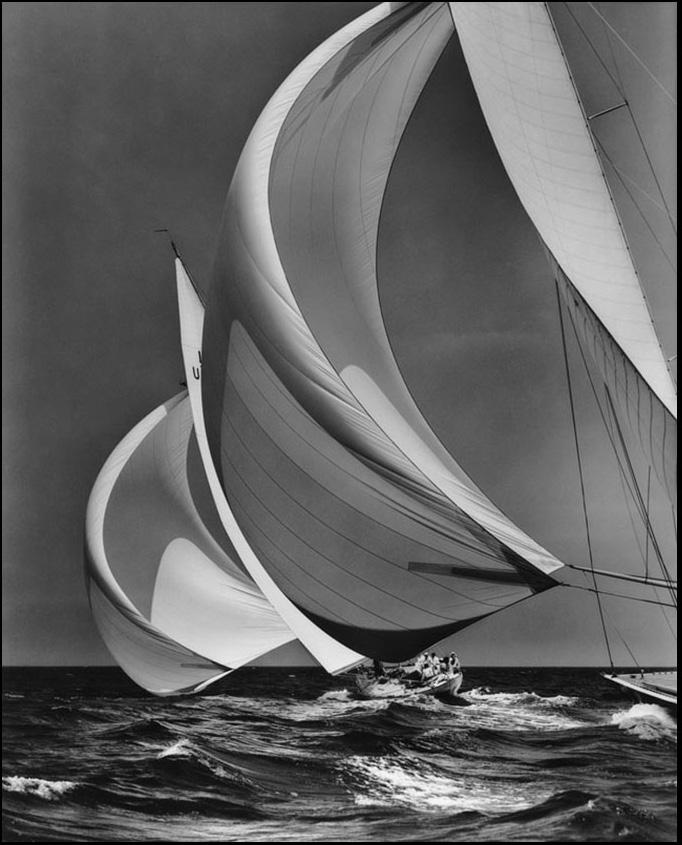
collection, produced from 1927 to the 1950s, are cellulose diacetate, or safety lm. (MSM, 75 Greenmanville Ave., Mystic, CT; www.mysticseaport.org ) … Less than one year after the recovery of a 1,200year-old canoe on the shore of Wisconsin’s Lake Mendota, another dugout canoe has been removed from the site— and it’s approximately 3,000 years old. Wisconsin Historical Society maritime archaeologist Tamara omsen discovered both artifacts. e more recently discovered canoe, whose origin was identi ed by radiocarbon dating at around 1000 BC, is the oldest canoe ever discovered in the Great Lakes region by around 1,000 years. It is carved from a single piece of white oak,
and is about 14 and a half feet long. e Wisconsin Historical Society coordinated with Wisconsin’s native nations to plan its removal; there were members representing the Ho-Chunk Nation and Bad River Tribe on hand for the recovery, conducted by archaeologists and skilled volunteers. After a careful cleaning, the canoe will be placed alongside the previously discovered canoe for a two-year preservation process and then freeze-dried to remove any remaining water. “I was amazed when a 1,200-year-old canoe was uncovered last year, but this discovery of a canoe dating back to 1000 BC is just extraordinary,” said Wisconsin Governor Tony Evers. “ is incredible nd-

ing provides an opportunity for us to work in concert with Tribal Nations to not only study but celebrate the history of the Indigenous people who’ve called this land home since long before Wisconsin became a state, and I look forward to learning more about this artifact’s origins.” (WHS, 816 State Street, Madison, WI; www.wisconsinhistory.org ) … e Royal Navy has o cially transferred ownership of more than 8,000 artifacts recovered from the wreck of HMS Invincible to the National Museum of the Royal Navy so that the objects may be better preserved, curated, and displayed. e 74-gun man o’war sank in 1758 o of Portsmouth (UK); it was rediscovered when sherman Arthur Mack caught his nets on the wreck in 1979. Most of the recovery of items from the site has been carried out by Maritime Archaeology Sea Trust (MAST), the National Museum of the Royal Navy, and Bournemouth University, funded by more than $2.2 million (USD) from a 2016 grant from the LIBOR Fund, a banking ne fund allocated to non-pro t causes. Built for the French Navy in 1744, Invincible was constructed of wood with 200 iron knees. After her capture by the British at the Battle of Cape Finisterre on 3 May 1747, she was tted with modern upgrades, including an iron hearth replacing the brick galley and intlock ring mechanisms for her guns. Due to the rate at which the wreck was becoming uncovered, Historic England placed the site on the Heritage at Risk Register in 2012. Items that have been recovered from the wreck site include portions of the ship, tobacco pipes, hair curlers, shoes, plates, and tankards. All of these items have remained, up until now, in the o cial possession of the Crown. Transferring ownership will put the museum in a better position to manage the artifacts. (www.nmrn.org.uk) … e submarine Nautilus (SSN-571) welcomed visitors with a grand reopening ceremony on 9 September at the Submarine Force Museum in Groton, Connecticut
A National Historic Landmark and Connecticut’s state ship, Nautilus underwent a year-long preservation process with an estimated cost of $36 million, conducted at Naval Submarine Base New London (SUBASE). In November 2021, Nautilus was dry docked and encased in a temperature-

54 SEA HISTORY 181, WINTER 2022–23
mystic seaport museum , rosenfeld collection , 1984 187 88393
wisconsin
photo
In September, a team from the Wisconsin Historical Society recovered a 3,000-year-old dugout canoe from the bottom of Lake Mendota. It was the second ancient dugout discovered by WHS maritime archaeologist Tamara omsen in less than a year.
wisconsin historical society photo
historical society
moderated tent, where crews removed the submarine’s topside wooden deck in preparation for replacement, completed a fullhull abrasive blasting and painting, and made repairs to the submarine’s superstructure. Twenty tanks in the submarine were entered, inspected, cleaned, and preserved. e sub then remained at a pier on the SUBASE waterfront to undergo more maintenance and preservation work, which included upgrades to interior lighting, updates to electrical distribution systems, and improved accessibility for sta . Mystic Seaport Museum personnel began re-installing all new wood decking topside. Nautilus returned to the museum on 4 August, and her crew spent those weeks on the nal phase of the preservation project and preparations to re-open the submarine to the public. President Harry S. Truman presided over her keel-laying in June of 1952, and Mamie Eisenhower sponsored the sub at her launch in 1954. e rst submarine to use a nuclear propulsion system, Nautilus would go on to set many records; on her maiden voyage she remained submerged for 1,381 miles and a duration of 89.9 hours, the longest submerged cruise for a submarine to date. She would become the rst ship to reach the geographic North Pole in 1958, and she actively served for more than 25 years, completing 2,500 dives and logging more than 510,000 miles on nuclear power. Today she is the only nuclear-powered US Navy vessel available to the public for general visitation, welcoming more than 100,000 guests annually. (Submarine Force Library and Museum Association, www.ussnautilus.org ) … On 6 October the US Department of Transportation’s Maritime Administration
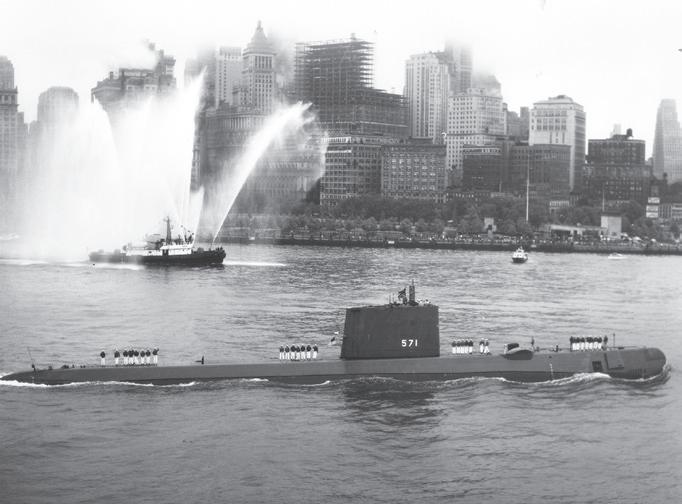
(MARAD) awarded almost $39 million in grants to twelve marine highway projects as part of the America’s Marine Highway Program (AMHP). “Today’s announcement will help improve our marine highway system across the country, alleviating congestion, modernizing port operations, and ultimately lowering the cost of goods for American families,” said US Transportation Secretary Pete Buttigieg. Much of the funding will go towards equipment purchases and infrastructure upgrades; an award of $1,128,889 will be

applied to preliminary design and environmental investigation activities to develop the Port Raritan Terminal Facility for active maritime use. Nearly all of the funding will go to projects in historically disadvantaged communities or federally designated community development zones; preference was also given to projects demonstrating a movement towards lower carbon emissions, those that reduce air emissions and vehicle miles traveled, and projects that strengthen the country’s supply chains. (MARAD, www.maritime.dot.gov)

SEA HISTORY 181, WINTER 2022–23 55
USS Nautilus entering New York harbor on 25 August 1958, after her voyage under the North Pole.
nhhc , us navy photo
ALAN G.











“Sharing the incredible saga of lost ships on the ocean floor and how they reflect humanity’s past is a daunting task. Jamieson’s sweeping narrative offers a detailed and fascinating view of this vast undersea museum.” —James P. Delgado, author of War at Sea

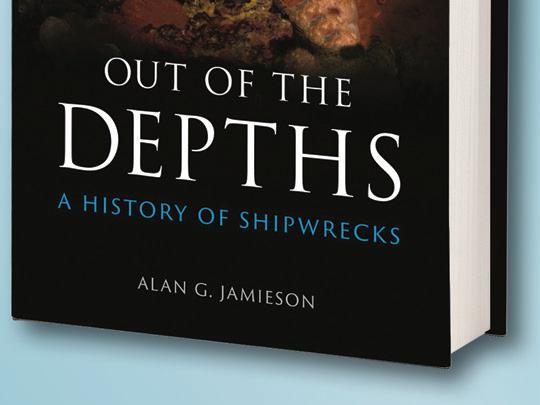
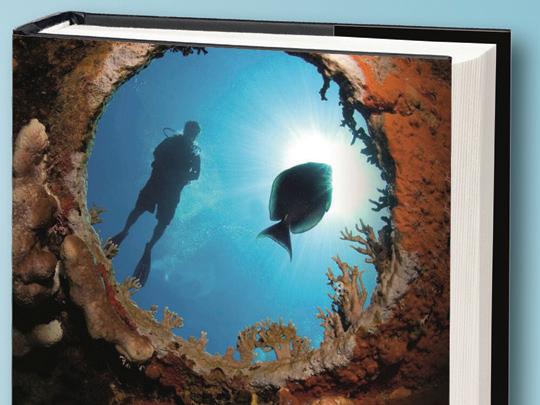





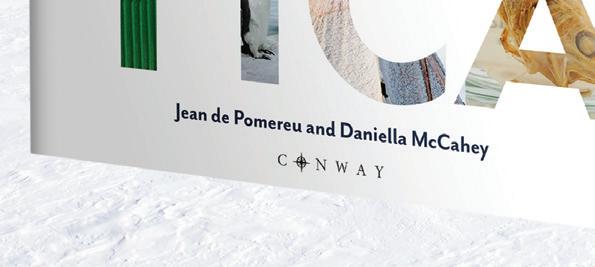
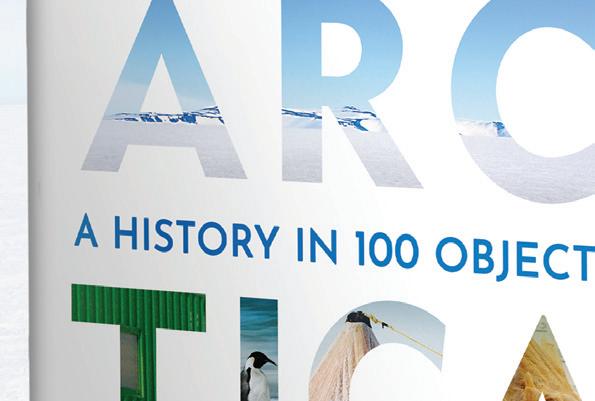

56 SEA HISTORY 181, WINTER 2022–23
discover
NEW FROM CONWAY Order your copy today on bloomsbury.com and wherever books are sold $30 • Hardcover • 978-1-8448-6621-2 Color and rare archive photography throughout
Orderfrom Xlibris: 1-877-444-6879 Withtwoheroicfathers,DavidGlasgowFarragut wasearlypreparedforthedangersheconfrontedin theCivilWar –AuthorRobertL.Caleo From Reaktion Books OUT
THE DEPTHS
of Shipwrecks
From the Terra Incognita and the Resolution to the frontiers of climate change,
the powerful history of Antarctica through 100 fascinating objects drawn from collections around the world.
"A profound and moving narrative that speaks to both the power of the sea and the strength of the human heart." James P Delgado author of War at Sea: A
Shipwrecked History, and The Lost Submarines of Pearl Harbor
OF
A History
JAMIESON
Distributed by the University of Chicago Press www.press.uchicago.edu Cloth $35.00
Reviews
A Great and Rising Nation: Naval Exploration and Global Empire in the Early US Republic by Michael A. Verney (University of Chicago Press, Chicago, 2022, 300pp, illus, maps, notes, index, isbn 978- 0 -22681-922-1; $35pb)
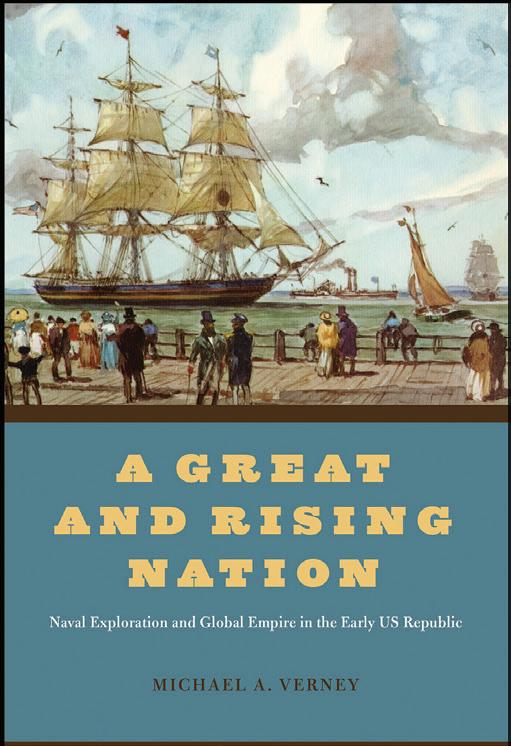
Michael Verney’s A Great and Rising Nation ts perfectly among the ranks of interesting re-examinations of the Navy’s pre-Civil War role in extending American empire far and wide—economically, militarily, diplomatically, and scienti cally; one of its earliest proponents, the remarkable and indefatigable author and lecturer Jeremiah Reynolds, preached the selling of “an empire of knowledge” after the War of 1812. Indeed, Reynolds found friends of convenience in high places, like John Quincy Adams, as an expansionist secretary of state and one-term president with colossal dreams, and belatedly Adams’s antagonist and successor Andrew Jackson, who was determined to cement the nation’s territory across all of North America and extend its in uence as a commercial power with military muscle to Asian shores. In Verney’s words, “Reynolds’s coalition was a motley one. …To greater or lesser degree working-class seafarers, wealthy gentlemen, naval o cers, leading scientists, and merchant captains all operated within its orbit.”
What clearer way could the republic demonstrate to Europe—especially the British—that the United States understood great nations were creating a new “Era of Exploration.” ey ignored the fallout of extending empire at the expense of the people already living on the land. Reynolds “compared the South Seas to Indian country;” an analogy that went a long way in explaining the violence that often occurred in these encounters—far away from the Paci c.
is is a point Verney makes e ectively throughout A Great and Rising Nation. He doesn’t examine each of the fteen exploring expeditions the Navy undertook from 1837 to 1861, but rather concentrates on a select few to illustrate his point of how the United States was “amassing imperial power” to include the spread of slavery in the Americas. Verney’s description of the travails in launching the 1837 Exploring Expedition (a.k.a. “Ex-Ex”), commanded eventually by the short-tempered Lieuten-
ant Charles Wilkes, is dead on target politically. In short, it came down to these questions: To what end were we incurring the cost of sending so many ships and so many men for so long a time to the far reaches of the world? Why was it taking
In a time of war, this time with Mexico but with orders for Mediterranean duty, Lynch proposed to Navy Secretary John Young Mason that he undertake a survey of the Dead Sea. e lieutenant convinced the activist secretary it “would be easy, cheap, and a coup for the Navy, for the United States, and for biblical and scienti c knowledge.” Verney sums up that biblical-scienti c impact on an American evangelical audience: “With the publication of Lynch’s [book] … evangelicals saw that naval exploration could be a potent tool for deepening the empire of faith at home and abroad.” e American audience writ large—beyond the deeply religious—was fertile ground for these specialized “travel books” by Navy o cers.
The Glencannon Press
4 col. inches (2.25 x 4.5 inches)
Prefer right hand page, bottom right.
years to produce a report to the legislators who bore all this expense? Why was the cost of printing the reports skyrocketing, and what was the nation to do with all these plants and remains of sh, amphibians, and mammals?

“Congress, frequently exasperated by the costs of the Ex-Ex volumes, could not conceive of spending any more money on public monuments to naval exploration.” Yet it did. But the US Navy, especially Matthew Fontaine Maury at the National [later Naval] Observatory, took a lesson from John Barrow, the long-serving force in the British Admiralty who insisted his commanders write popular reports explaining the Royal Navy’s mission to explore the world. In addition to their books, Barrow himself wrote his own “leaders” for magazines and newspapers underlining how the Royal Navy was making Britain great. Maury recognized Barrow’s skills in shaping popular and political opinion in Parliament to the Royal Navy’s ambitions and followed suit, not with Wilkes, a rival, but with William Francis Lynch. Lynch lived near Maury in Central Virginia, and they were on their way to developing a lifelong friendship. ey also shared a deep religious belief that permeated the narrative of Lynch’s report on his activities in the holiest of holy sites for Christians in the Islamic Ottoman Empire.
What makes A Great and Rising Nation such an interesting book to read are the sharp, pointed mini-biographies of the persons who set the tone for each chapter. An excellent example of this comes in presenting Elisha Kent Kane, the surgeon who led the second Grinnell expedition to the Arctic. Although Kane battled rheumatic heart problems throughout his short life,
GTHE GLENCANNON PRESS MaritimePBooks NEW! Black Knight
The Life and Times of Capt. Hugh Mulzac
The complete life story of the frst black man to have and sail on an American master’s license and the frst to command a Liberty Ship throughout World War II. More than 300 pages, 14 in full color.
FREE Catalog Tel. 1-510-455-9027
SEA HISTORY 181, WINTER 2022–23 57
by Kurt D. Voss
All proceeds from this pictorial history benefit the ELISSA preservation fund.
Neith, 1996, Cover photograph Wood, Wind and Water
A Story of the Opera House Cup Race of Nantucket
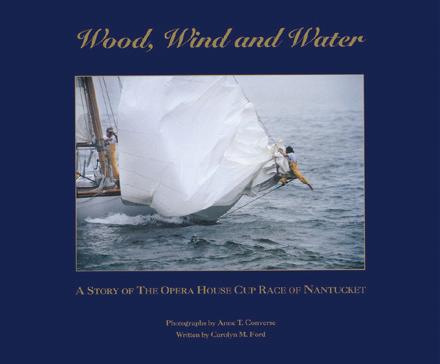
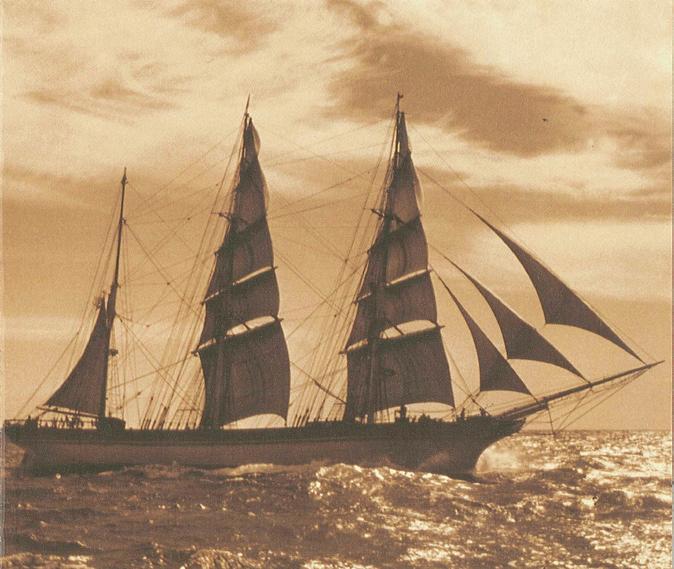
Photographs by Anne T. Converse Text by Carolyn M. Ford
Live vicariously through the pictures and tales of classic wooden yacht owners who lovingly restore and race these gems of the sea.
“An outstanding presentation deserves ongoing recommendation for both art and nautical collections.”
he was in turn a war hero, with service in Africa and China before the High North explorations.
A Great and Rising Nation belongs on the same shelf as Benjamin Armstrong’s Small Boats and Daring Men, Claude Berube’s On Wide Seas: e US Navy in the Jacksonian Era, Dane Morrison’s Eastward of Good Hope, and Jason Smith’s To Master the Boundless Sea
 John Grady Fairfax, Virginia
John Grady Fairfax, Virginia
On Wide Seas: e US Navy in the Jacksonian Era by Claude Berube (University of Alabama Press, Tuscaloosa, 2021, 234pp, illus, notes, biblio, index, isbn 978-0-81732107-9; $54.95hc)
Published by Arcadia Publishing and Galveston Historical Foundation $21.99. 128 pages, 200 photographs
Autographed copies available at (409) 763-1877, or online at:
10”x12” Hardbound book; 132 pages, 85 full page color photographs; Price $45.00
For more information contact: Anne T. Converse Phone: 508-728-6210 anne@annetconverse.com www.annetconverse.com
Writing about the US Navy during the time of President Andrew Jackson is no easy task. While many eras of Navy history have deep historiography, the period between the end of the War of 1812 and the Civil War is close to a naval desert. Additionally, the contested legacy of President Jackson adds to the challenge.
information for many of the vessels already listed. This list is primarily compiled from the “List of Merchant Vessels of the United States.” Other annuals (American Lloyds, Lloyds, Record and others), Custom House records and newspapers used for additional information. Not only American vessels, but foreign ones too, whether commercial, pleasure, sail, power, warships, unrigged and some undocumented.
Now Shipwreck Index and Chronological list.
On Wide Seas: e US Navy in the Jacksonian Era takes on this subject, and its author, Claude Berube, is well suited for the task. A reserve naval o cer, he is currently the director of the US Naval Academy Museum in Annapolis. A previous sta er for multiple members of Congress, he has an insider’s perspective on the relationship between military and government. A successful author of both ction and non- ction, a podcaster, and a professor, Berube seeks to ll in the details of the Navy’s role in the 1830s under President Jackson.
is triple-expansion epic is set in 1913 Shanghai, where four cultures are about to collide: China, Korea, Japan, and the US. e point of collision is three tons of Japanese gold ingots meant to undermine an already collapsing China.
“ e Abalone Ukulele is a masterclass in historical ction. With painstaking research and a gift for story spinning, Crossland brings to brilliant life a sprawling epic of greed, gold, and redemption.” INDIVIDUAL
e United States emerged from the War of 1812 with a mixed legacy. e early frigate battles gave way to equally embarrassing losses (Essex, Chesapeake, and President). Even before the ink was a xed to the Treaty of Ghent, Stephen Decatur (not a favorite for Dr. Berube) set sail for the Mediterranean to chastise the Algerians for their insolence. at success led to a period of intellectual awakening for the US Navy. e Naval Lyceum was built on an intellectual movement that was sweeping the nation during this period. Captains Charles Stewart and Matthew Perry, along with author James Fenimore Cooper, all

58 SEA HISTORY 181, WINTER 2022–23
ww w .t sm - e li ssa . o r g
Anne T. Converse Photography
Database with nearly 150,000 vessels Online @ internationalmaritimelibrary.org
ORDERS : www.dreadnaughts-bluejackets.com FOR BULK ORDERS: orders@newacademiapublishing.com —Joseph A. Williams, author of Seventeen Fathoms Deep and e Sunken Gold
contributed to this movement within the US Navy, eventually culminating in the creation of the United States Naval Academy in Annapolis and the professionalization of the o cer corps.

To tackle this subject, Berube started his research with the fourth auditor of the Treasury Department under President Jackson, Amos Kendall, and then dived into the vast amount of court-martial records from this era. In the post-War of 1812 period, the Navy found itself in search of a mission. Prior to the 1830s, Navy ship construction was limited to times of conict, such as the Quasi-War, the battles against Barbary Pirates, and the War of 1812.
Armed with lessons learned from the war with the British, the Naval Act of 1816 called for the construction of a eet of ships-of-the-line and frigates that could go toe-to-toe with the Royal Navy. ese ships proved extremely expensive to build and man.







Instead, the Navy shifted its attention on smaller warships—schooners, brigs, and sloops—stationed in squadrons around the world to guard and safeguard American interests and ships of the American merchant marine. is maritime destiny gave the burgeoning US Navy a global strategy and the practical experience to exercise naval operations. Naval o cers were sometimes the only representatives of the United States government in far- ung parts of the globe. e great distances involved meant that captains and the ships and men under their command were months away from instructions or assistance, and had to weigh any action accordingly.
e creation of a naval culture in peacetime developed over the one forced into existence by war. Issues such as discipline, education, medicine, religion, race, and alcohol consumption all came to the surface. As Berube notes, there was an awakening for the US Navy in a period when Tocqueville noted that America was “born to rule the seas.”
On Wide Seas: e US Navy in the Jacksonian Era is a must-read for those interested in the early Republic of the United States and the development of the US Navy in the decades before the Civil War. Berube’s use of primary sources and an extremely well-laid-out format provides the reader with a wealth of information, supplemented by charts and photographs. Many of the issues facing the Navy in the early 19th century still resonate in the Navy of the early 21st century.
 Salvatore M ercogliano, P h D Fuquay-Varina, North Carolina
Salvatore M ercogliano, P h D Fuquay-Varina, North Carolina
e Longbow, the Schooner, and the Violin: Wood and Human Achievement by Marq de Villiers (Sunderland House, Toronto, 2022, 318pp, notes, biblio, isbn 978-1-989555-59-0; $29.95hc)
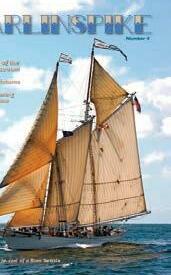


Marq de Villiers is a journalist and author who has published more than a dozen books on history, travel, and the environment. His career has intersected numerous times with the maritime realm, rst with Down the Volga in a Time of Troubles: A Journey through Post-Perestroika Russia
(1991), then in Water: e Fate of Our Most Precious Resource (1999), A Dune Adrift: e Strange Origins and Curious History of Sable Island (2004), and Witch in the Wind: e True Story of the Legendary Bluenose (2007). is last book, winner of two Nova Scotian book-prizes for non- ction, explored the history of the famous Lunenburg-built shing schooner that sailed from 1921 until it wrecked in 1946.
Now, de Villiers has turned his attention to forests, trees, and wood in e Longbow, the Schooner, and the Violin: Wood and Human Achievement. In this book of essays aimed at a popular audience, the author explores forests and trees from a variety of angles—“What is a tree?” “Life in the forest,” “Forests in danger,” “People of the forest”—intermixed with explorations of the ways humankind has exploited forest products for cultural ends—“Wood and its uses,” “Best woods for ne furniture,” and “Engineered wood.” As the author puts it in his introduction, the book’s goal is “to see the forest, to see the trees, to explore the long and entangled history of homo sapiens and wood, and to speculate a little. It is also
NAUTICAL RESEARCH
SEA HISTORY 181, WINTER 2022–23 59
RESEARCH" Annual membership includes our world-renowned quarterly magazine, Nautical Research Journal, which features photographs and articles on ship model building, naval architecture, merchant and naval ship construction, maritime trade, nautical and maritime history, nautical archaeology and maritime art. Other benefits include discounts on annual conferences, ship modeling seminars, NRG products and juried model competitions which are offered exclusively to Guild members. We hope you will consider joining our ongoing celebration of model ships and maritime history. For more informaton contact us at: www.thenrg.org or call 585 968 8111 The quarterly magazine devoted to traditional sailing vessels, sailors, and sail training! One year $29 * Two years $48 To subscribe, visit our website, call (978) 594-6510, or send a check to MARLINSPIKE 98 Washington Square #1, Salem MA 01970
THE
GUILD "ADVANCING SHIP MODELING THROUGH
about the many uses we have found for wood. About the trees that yield that wood. And the fate of those trees. Now, and then.”
De Villiers’s many short forest and tree essays range widely and make easy and entertaining reading. ey are punctuated by three focus chapters exploring the objects from the book’s title: the longbow, the schooner, and the violin. ese are what he calls his “three iconic wooden artifacts” which “were chosen with care. All are caught at the absolute pinnacle of their craft,” he writes. Such an approach is nec-
essarily reductionist. It also does not entirely work, perhaps because the three icons are so conspicuously Western as expressions of woodcraft. Out of a whole world of bows and arrows, wooden boats, and musical instruments, de Villiers presents us the English longbow, the Anglo-American shing schooner, and the Italian violin as pinnacles. Swapping one of these for, say, Japanese joinery, as expressed in furniture design or architecture, would perhaps better ful ll the book’s goal of epitomizing human achievement with wood. In fairness,
the author does include many non-Western examples in his forest chapters, including a few pages on the Sakyamuni Pagoda in Shanxi province, China, as an example of large structures built of wood.
•
Nautical Charts
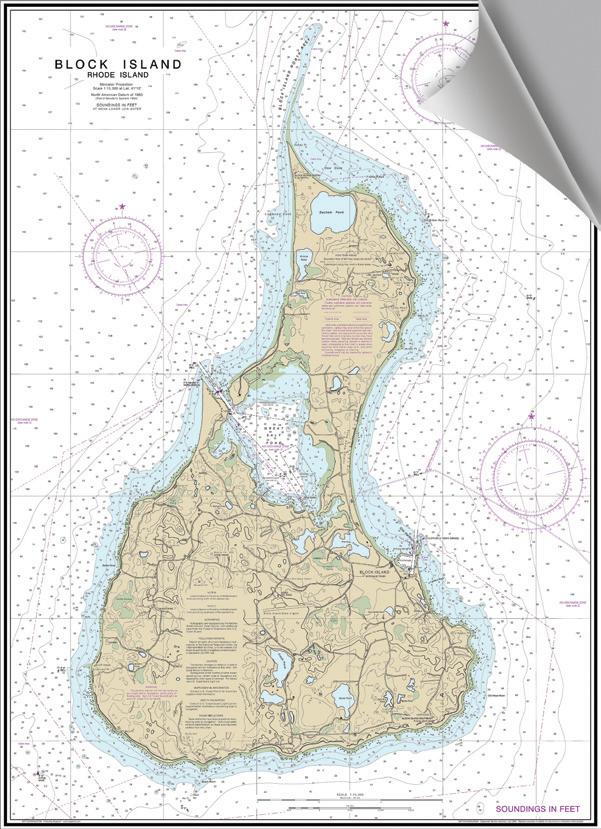
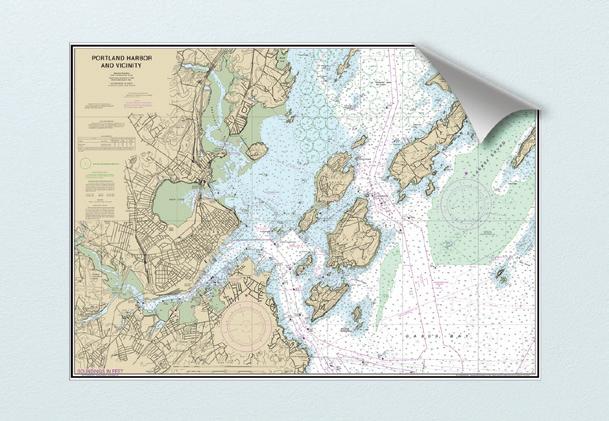

For the longbow, the author summarizes the 66,000-year history of the bow and arrow as instruments of hunting and killing. His discussion of the English and Welsh longbow of the 14th century—the rulers who deployed it, and the archers who wielded it—is heavy on English, French, and Scottish military and political maneuvering. De Villiers describes the longbow as the acme of “accuracy, speed of re, and deadliness:” a length of yew wood activated with stout string which, when deployed en masse, swayed the course of nations and elevated peasants into the rst class of citizen soldiers in Medieval Europe.
•
•
•
•
•
In the violin, de Villiers sees an instrument that “is capable of teasing out every emotion in the wide human catalogue.” After glancing into the antecedents of the violin family in Europe, he lands in sixteenth and seventeenth century Italy, where the familiar characters of Andrea Amati, Antonio Stradivari, and Giuseppe Guarneri built instruments of enduring artistry and mystique. e ins and outs of centuries of speculation into what makes the Stradivarius such a valued instrument occupies much of this chapter. Traversing this welltrampled ground leads to one of the few really satisfying insights in the book—care of the Philadelphia violin maker Christopher Germain. “Stradivari’s secret was that he was a genius and that he did a thousand things right, not one thing right. Saying his success came down to just one trick is like saying that if I had the same kind of paint as Michelangelo, I could have painted the Sistine Chapel.”
e schooner forms the central chapter of the book. e author’s love of the subject is apparent, yet this love is not matched by a command of the subject. It is not even clear at rst what de Villiers means by schooner. To readers already familiar with sailing or maritime history, the term schooner will bring to mind a wide range of vessels from di erent places and times: two hundred years of coasting schooners on the American East Coast; one hundred years of lumber schooners and steam schooners
60 SEA HISTORY 181, WINTER 2022–23
• PEEL & STICK technology
No frame necessary
Printed on self-adhesive matte fabric
Easy to peel off and reapply – does not leave a sticky residue behind
Can be attached to almost all smooth surfaces including walls and windows
Popular harbors, islands and bays
offer
Low-tack adhesive leaves no residue behind. A great addition to your home or office decor. 888-839-5551 • sales @ maptech.com • www.maptech.com Visit www.maptech.com to see the extensive collection online. Popular Destinations Available
24 x 34 inches Decorative Nautical Charts
a unique way to define your space by displaying your favorite boating destination. Just peel the backing off and apply no frame needed! These charts are not intended for navigation and are for decorative purposes only.
D ecorative Makesa GREAT GIFT!
on the Paci c Coast. Pilot schooners out of New York and sharp-model trading schooners out of Baltimore; letter-of-marque schooners in war and revenue-cutter schooners in peace. America’s Cup contenders and polar explorers. ere are the pinky schooners, Marblehead schooners, sharpshooter schooners shing in the Atlantic, whaling schooners. e list goes on, re ecting a great diversity of forms developed to suit diverse purposes and conditions. e author, however, largely ignores this variety and proceeds from the assumption that schooner means solely the shing schooners of New England and Maritime Canada, as represented by the Bluenose, which the author knows a great deal about from his earlier book.
e chapter includes a short, selective history of random watercraft that skips from ancient dugouts and reed boats to coracles, canoes, kayaks, Viking longboats, and Senegalese pirogues, with notes on Phoenician and Roman designs and Chinese junks. A brief page about the colonial origins of the American shing schooner lacks nuance and is followed by an extended description of the process of building a wooden schooner in a late-nineteenth century American or Canadian shipyard. e link between wood and schooner is most clear in the section, although many opportunities to expound on human ingenuity among shipwrights and carpenters go unexplored.
From here, de Villiers entirely switches his subject to clipper ships. He calls clippers “the apotheosis and successor” of the schooner, a simplistic and inaccurate elision undermined by his assertion that “clippers weren’t true schooners” but were “postschooners.” Apples aren’t true oranges, either. His clipper discussion, touching on the speed records of the usual suspects—Flying Cloud , Cutty Sark, and Sovereign of the Seas —and on the reckless hard driving that typi ed clipper voyages, adds nothing to our understanding of the subject, and, if anything, leaves the reader rightly wondering what wood has to do with the skill of clipper captains or the price of tea in China.
“Wooden vessels date to the earliest dugouts and coracles,” de Villiers explains at the book’s start, “but none in their long history showed the combination of versatility, brute utility, and elegance of the
schooner and the schooner’s apotheosis, that rakish beauty the clipper ship.” A key shortcoming of de Villiers’s project is that by adopting this premise and reducing the world of wooden watercraft to just shing schooners and clippers, he leaves so much of the true story unexplored. Watercraft are excellent examples of ingenuity and achievement in wood, but the world of them is amazingly varied. Everywhere we look on the world’s waters and in the literature of the sea, we nd beautiful and useful vessels skillfully wrought in wood to meet every kind of human need a oat.
e history de Villiers presents just skims the surface of this story, rendering the maritime portion of the book ultimately unful lling and disappointing. Knowledgeable readers will be frustrated, and novice readers will be misinformed.

 M ichael R. H arrison Nantucket, Massachusetts
M ichael R. H arrison Nantucket, Massachusetts
e Tragic Sinking of Gloucester’s Patriot by Captain W. Russell Webster, USCG (Ret.) ( e History Press, Charleston, SC, 2022, 144pp, index, isbn 978-14671-5086-6; $21.99pb)
e story is not about the 2009 sinking. It hardly could be. By the time word reached the Coast Guard that the shing vessel Patriot was in trouble, Captain Matteo Russo and his father-in-law, John Orlando, had already entered the freezing cold January waters o Massachusetts, as their boat sank in what seemed to be a quick, catastrophic, and tragic post-midnight event. e author reconstructs the moments prior to the sinking using two signi cant sources, NOAA whale monitoring buoys that tracked engine noises the night of the event, and, more importantly, an account from the captain’s brother, an experienced sherman who knew how to interpret the revving and slowing of the engine in
SEA HISTORY 181, WINTER 2022–23 61
Tugboats and Shipyards: The Russells of New York Harbor, 1844–1962
Hilary Russell, Jr.
Tugboats and Shipyards: The Russells of New York Harbor, 1844–1962
 by Hilary Russell Jr.
by Hilary Russell Jr.
“… In a rare glimpse of a bygone era, Russell takes us through the growth of the family marine businesses, based in gritty Newtown Creek, Queens. There, the family built their tugs and operated them in the harbor, along the coasts, up the Hudson River, and eventually into the Great Lakes… The book is at its best in the “Captain’s Tales” chapter, a compendium of frst person stories.” —Greg Rossel, WoodenBoat
$31 – Order through AbeBooks, PayPal, or mail a check to: Berkshire Boat Building School, POB 578, Sheffeld, MA, 01257. Questions? call 413 229-2549

relation to the timing of trawling and bringing a net full of sh on board. e sounds ominously cut out at the same time that a re alarm went o , alerting the alarm company and setting events in motion ashore.
For Captain Webster, a career Coast Guard o cer who oversaw numerous highpro le search-and-rescue cases during his time in command of New England units, the story begins then. How did the Coast


Baylor University
Guard respond, and was its response appropriate? Keeping in readers’ minds the fact that Russo and Orlando stood little to no chance of survival, Webster recreates the response in a minute-to-minute accounting, tracking phone calls and other messages up and down the Coast Guard chain of command. His study focuses on rescue watchstander normalcy bias. Inexperienced watchstanders, he explains, may hesitate deploying rescue resources to vessels apparently in distress, for various reasons. Such was the case with Patriot.
Webster’s research proves that the Coast Guard’s response expanded well beyond the search-and-rescue e ort that was launched about two hours after the sinking that January night in 2009. It reached the highest levels of Coast Guard leadership, the admirals who saw the Patriot ’s sinking as a problem emblematic of the need for service-wide reforms that would instill a bias—not for normalcy, but for action. e tragic loss of Orlando and Russo, while seemingly inevitable in their particular situation that night, may yet prevent future loss of life.

Available on Amazon.com and at www.hellgatepress.com
 John G alluzzo Hanover, Massachusetts
John G alluzzo Hanover, Massachusetts
62 SEA HISTORY 181, WINTER 2022–23
“...An absolutely splendid read.”
Craig L. Symonds, Professor Emeritus of History, U.S. Naval Academy
“What a story, and how well told!”
Eric C. Rust, Professor of History,
“…Real, relevant, and deeply meaningful to anyone who has set sail and headed into harm’s way.”
— James Stavridis, Ph.D., Admiral, US Navy (Retired)
122 Years on the Old Bay Line by Jack Shaum (Arcadia Publishing and e History Press, Mount Pleasant, South Carolina, 2022, 168pp, illus, notes, biblio, index, isbn 978-1-63499-399-9; $25.99pb)
Armada: e Spanish Enterprise and England’s Deliverance in 1588 by Colin Martin and Geo rey Parker (Yale University Press, Feb. 2023, 768pp, illus, notes, index, isbn 978-0-30025-986-5; $40hc)
Audubon at Sea: e Coastal & Transatlantic Adventures of John James Audubon edited by Christoph Irmscher and Richard J. King (University of Chicago Press, Chicago, 2022, 333pp, illus, index, isbn 978-0-226-75667-7; $30hc),
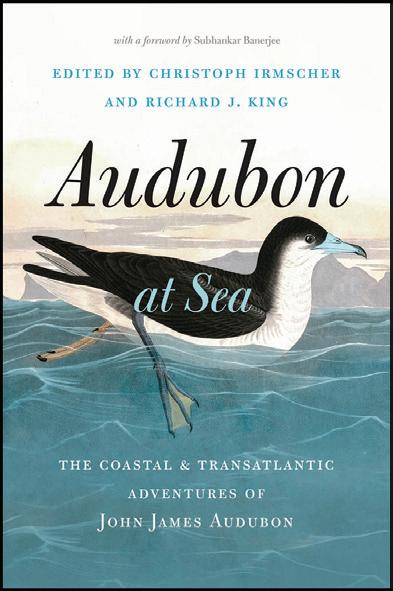
e Black Joke: e True Story of One Ship’s Battle Against the Slave Trade by A. E. Rooks (Scribner, New York, 2022, 400pp, illus, notes, biblio, index, isbn 9781-98212-826-5; $29hc)
e Curse of the Somers: e Secret History behind the US Navy’s Most Infamous Mutiny by James P. Delgado (Oxford University Press, Oxford, UK, 2023, 288pp, illus, notes, biblio, index; isbn 978-019757-522-2; $24.95hc)
Death by Fire and Ice: e Steamboat Lexington Calamity by Brian E. O’Connor (Naval Institute Press, Annapolis, Maryland, 2022, 232pp, illus, isbn 978-1-68247804-2 $29.95hc)
e Far Land: 200 Years of Murder, Mania, and Mutiny in the South Paci c by Brandon Presser (PublicA airs, Hachette Book Group, New York, 2022, 327pp, maps, notes, biblio, index, isbn 978-1-5417-5857-5; $30hc)
Foreign Jack Tars: e British Navy and Transnational Seafarers during the Revolutionary and Napoleonic Wars by Sara Caputo (Cambridge University Press, Cambridge, UK, 2022, 320pp, illus, notes, index, isbn 978-1-00919-979-7; $99hc)
181, WINTER 2022–23
New & Noted
e Golden Age of Piracy in China, 1520–1810: A Short History with Documents by Robert J. Antony (Rowman & Little eld, Lanham, Maryland, 2022, 180pp, illus, maps, gloss, notes, index, isbn 978-1-5381-6152-4; $79hc)
Halfway to America: e Tragic Sinking of the William Nelson by Je Wright (Cordura Books, Phoenix, Arizona, 2022, 135pp, biblio, isbn 978-1-66782-839-8; $16.99pb)
Into Enemy Waters: A World War II Story of the Demolition Divers Who Became the Navy Seals by Andrew Dubbins (Diversion Books, New York, 2022, 352pp, illus, biblio, index, isbn 978-1-63576-772-8; $28.99hc)
Kalmar Nyckel: e Tall Ship of Delaware by Samuel W. Heed, Esq. (Arcadia Publishing, Charleston, South Carolina, 2022, 126pp, illus, isbn 979-1-4671-0853-9; $24pb)



Mao’s Army Goes to Sea: e Island Campaigns and the Founding of China’s Navy by Toshi Yoshihara (Georgetown University Press, Washington, DC, 2022, 200pp, maps, notes, biblio, index, isbn 978-164712-281-2; $104.95hc)
May We Be Spared to Meet on Earth: Letters of the Lost Franklin Arctic Expedition edited by Russell A. Potter, Regina Koellner, Peter Carney, and Mary Williamson (McGill-Queen’s University Press, Montreal, 2022, 481pp, illus, notes, biblio, index, isbn 978-0-2280-1139-2; $44.95hc)
Never Say P*g: e Book of Sailor’s Superstitions by R. Bruce MacDonald (Harbour Publishing, Madeira Park, BC, 2022, 176pp, illus, isbn 978-1-55017-979-8; $18.95hc)
Nightmare on the Scottie: e Maiden Voyage of a Doomed King Crabber by Stephen D. Orsini (Basalt Books, Pullman, Washington, 140pp, illus, biblio, isbn 9781-63864-000-4; $18.95pb)
Out of the Depths: A History of Shipwrecks by Alan G. Jamieson (Reaktion Books, London, UK, 2022, 320pp, illus, biblio, index, isbn 978-1-78914-619-6; $35hc)
Port Newark and the Origins of Container Shipping by Angus Kress Gillespie (Rutgers University Press, New Brunswick, New Jersey, 2022, 265pp, illus, notes, index, isbn 978-1-9788-1871-2; $33.95hc)
Rebuilding a Blue Nation: Maritime Policies of the Portuguese New State, 1933–1974 by Alvaro Garrido (Sussex Academic Press, Brighton, UK, 2022, 272pp, illus, notes, index, isbn 978-178976-014-9; $99.95hc)
Shipwrecked and Rescued: Cars and Crew by Larry Jorgensen (G. L. Management, LLC, Mansura, Louisiana, 2022, 85pp, illus, isbn 978-0-578-38234-0; $22pb)
Shipwrecks and the Bounty of the Sea by David Cressy (Oxford University Press, Oxford, UK, 2022, 336pp, illus, appen, biblio, notes, index, isbn 978-0-19286339-3; $40hc)
Soul of the Hurricane: e Perfect Storm and an Accidental Sailor by Nelson Simon (Chicago Review Press, Chicago, 2022, 229pp, illus, isbn 978-1-64160-4086; $27.99hc)
Sub Culture: e Many Lives of the Submarine by John Medhurst (Reaktion Books, London, UK, 2022, 256pp, illus, biblio, notes, index, isbn 978-1-78914-6370; $22.50hc)
Unconventional Lawmaking in the Law of the Sea by Natalie Klein (Oxford University Press, Oxford, UK, 2022, 464pp, biblio, index, isbn 978-0-19289-782-4; $99hc)
Wind, Fire, and Ice: e Perils of a Coast Guard Icebreaker in Antarctica by Robert M. Bunes (Lyons Press, Guilford, Connecticut, 2021, 283pp, illus, biblio, index, isbn 978-1-4930-6034-4; $32.95hc)
SEA HISTORY
63
NATIONAL MARITIME HISTORICAL SOCIETY
AFTERGUARD J. Aron Charitable Foundation, Inc. Atlantic Salt Matt Brooks & Pam Rorke Levy CACI International, Inc. Caddell Dry Dock & Repair Co. George W. Carmany III In Memory of James J. Coleman Jr. Christopher J. Culver Brian D’Isernia Eckert Trust Henry L. & Grace Doherty Charitable Foundation In Memory of Ignatius Galgan ADM & Mrs. Jay L. Johnson, USN (Ret.) In Memory of Charles R. Kilbourne Arthur M. Kimberly Trust VADM Al Konetzni Jr., USN (Ret.) In Memory of H. F. Lenfest Richardo R. Lopes Guy E. C. Maitland McAllister Towing & Transportation Co. CAPT James A. Noone, USN (Ret.) Ronald L. Oswald ADM Robert J. Papp Jr., USCG (Ret.) Estate of Walter J. Pettit Sr. e Pollin Group, LLC In Memory of Capt. Joseph Ramsey, USMM In Memory of Charles A. Robertson Dr. Timothy J. & Laurie Runyan e Schoonmaker Foundation In Memory of Howard Slotnick Capt. Cesare Sorio John & Anne Stobart David & Beverly Verdier Betsy & omas A. Whidden William H. White Jean Wort
BENEFACTORS ARS Investment Partners Bank of America Byers Foundation RADM Joseph F. Callo, USN (Ret.) CAPT Sally McElwreath Callo, USN (Ret.) Susan Curtin VADM Dirk Debbink, USN (Ret.) Richard T. du Moulin David S. Fowler J. D. Power Family Hon. John Lehman Dr. Jennifer London Lori, James II, & Jim Mathieu John & Anne Rich Scarano Boat Building, Inc. H. C. Bowen Smith Norma Stanford In Memory of Peter Stanford Philip & Irmy Webster
PLANKOWNERS Dayton Carr Coast Guard Aviation Association Donjon Marine Co. George L. Dow Erie Basin Marine Associates In Memory of William J. Green Capt. Howard R. Hill Jr. Royal Holly Ruth R. Hoyt/Anne H. Jolley Foundation, Inc. Sir Lindsay Owe Jones Neil E. Jones H. Kirke Lathrop Norman Liss Carolyn & Leonard Mizerek William G. Muller Jacqueline Natter Brand Navy League of the United States Pritzker Military Foundation Red Hook Terminals erese Shaheen Charles Townsend Sidney Stern Memorial Trust Jeremy Weirich Dr. David & Mary K. Winkler
SPONSORS Paul M. Aldrich American Maritime Congress Charles B. Anderson Deborah Antoine John Appleton John Armitage e Artina Group James R. Barker CAPT Donald Bates, USN (Ret.) Lawrence Behr Richard J. Bodor John B. Caddell II Dr. John & Rachel Cahill Dr. Allan C. Campbell Je rey & Dr. Sharon Cannon Chesapeake Bay Maritime Museum J. Barclay Collins Gerald F. B. Cooper William J. Coxey Jr. C. W. Craycroft Dr. William S. & Donna Dudley VADM Robert F. Dunn, USCG (Ret.) Dr. John Finerty Mrs. D. L. Fleischmann Craig L. Fuller In Memory of D. Harry W. Garschagen Elizabeth Gibson Burchenal Green ADM Jonathan Greenert, USN (Ret.) Lee Ferguson Gruzen Robert S. Hagge Jr. Independence Seaport Museum RADM Eric C. Jones, USCG Dr. Reginald H. Jones Benjamin Katzenstein L3 Harris Technologies Cyrus C. Lauriat Amy T. Lent Paul Jay Lewis Com. Chip Loomis III Ann Peters Marvin Eugene Mattioni Capt. Je rey McAllister David J. & Carolyn D. McBride McCarter & English, LLC Peter McCracken Dr. Joseph F. Meany Jr. Charles H. Miller Michael C. Morris Robert E. Morris Jr. Mystic Seaport Museum Janis Nagy New York Shipping Association New York Yacht Club Wynn & Patricia Odom Erik & Kathy Olstein Joanne O’Neil Matthew J. Pallay e Betty Sue and Art Peabody Fund Brian R. Phillips Charles Raskob Robinson David & Susan Rockefeller Safran Helicopter Engines USA Lee H. Sandwen Sandy Hook Pilots Conrad Sche er Dorothea Schlosser George Schluderberg Seip Family Foundation Philip & Janet Shapiro Family Foundation Douglas H. Sharp CDR William H. Skidmore, USN (Ret.) C. Hamilton Sloan Foundation Sharon Slotnick James Staley Philip E. Stolp Daniel R. Sukis Elsa ompson RADM Frank orp IV, USN (Ret.) Alix orne Richard Tilghman Roy Vander Putten Otokar Von Bradsky omas Wayne Weeks Marine, Inc. Dr. Paul Zabetakis
DONORS Benjamin Ackerly Edwin L. Adler Advanced Mechanical Enterprises Peter Anderson Carter S. Bacon Jr. Dr. William Baker Vicki Black Ernest T. Bartol Charles R. Beaudrot Jr. W. Frank Bohlen Christopher & Elizabeth Boylan RADM David C. Brown, USMS (Ret.) Dennis Brugger Ronald L. Buchman CAPT Patrick Burns, USN (Ret.) Leonard Caiger RADM Nevin P. Carr Jr., USN (Ret.) Capt. Ned Chalker James W. Cheevers Benjamin Clark Mark Class CAPT Richard W. Cost, USNR (Ret.) Jack Creighton CAPT Roger L. Crossland, USN (Ret.) Robert Ian Danic Michael Davenport James P. Delgado omas Diedrich George & Tellie Dixon Scott W. Dow Richard H. Dumas CAPT Mitchell Edson, USN (Ret.) Jacqueline Eldridge William Elliott William V. Engel Ben P. Fisher Jr. Robert P. Fisher Jr. Nicholas Raposo Benjamin Green Sonia Hallenbeck Dr. David Hayes Charles Hennighausen William L. Henry Jessica Hitchen Joseph C. Hoopes Steven A. Hyman Timothy A. Ingraham J. Russell Jinishian Gallery Gary Jobson Henry Kaminski Robert F. & Sue Kamm John Karpousis Robert C. Kennedy Jr. CDR Robert E. Kenyon III, USNR (Ret.) Mary Burrichter & Bob Kierlin Dr. Brett M. Klyver Kobrand Corp. & Marco Sorio K. Denise R. Krepp David R. Lamb CDR C. R. Lampman, USN (Ret.) James P. Latham Frederick C. Leiner Robert Lindmark James M. Lundberg Jessica MacFarlane Babcock MacLean Walter C. Meibaum III Je erson D. Meighan Dr. Arthur M. Mellor Richard S. Merrell Christopher W. Metcalf CAPT R. G. Moore, USCG (Ret.) omas A. Moran CAPT Vance H. Morrison, USN (Ret.) Michael Morrow John & Elizabeth Murphy Navy League Capt. Eric Nielsen Jill Nosach Alan O’Grady Richard G. Pelley Eleanor J. Perkins Nathaniel Philbrick Carla R. Phillips Carl A. Pirolli Mr. & Mrs. Norman H. Plummer Jennifer N. Pritzker Andrew A. Radel Phineas Reeves Roland Rexha Albert Reynolds In Memory of Bert Rogers William M. Rosen Capt. Carlos A. Rosende Robert Sappio Greg Schlosberg Bill Skarich Edmund Sommer III Andrew Sillen Patricia Steele David Stulb Diane & Van Swearingin Capt. Raymond ombs Memorial Fund of the New Hampshire Charitable Foundation omas Howard Townsend Steven J. Traut Russell R. Tripp Lee P. Washburn Gerald Weinstein Chase Welles Daniel Whalen George C. White Richard C. Wolfe
PATRONS CAPT John E. Allen, USN (Ret.) Philip & Sherida Allor Matt & Rita Andis Silas Anthony Jr. Anthony J. Balut Robert Baly John D. Barnard VADM omas J. Barrett, USCG (Ret.) Hal Barstow Steve B. Batterman Allan H. Beck Mr. & Mrs. Vincent Bella ore Dudley Bierau James H. Brandi Margaret Brandon Henry S. Burgess Robert P. Burke Jose O. Busto In Memory of Joseph Anthony Cahill Charles J. Cannon Elliot Carlson Judith L. Carmany Mark G. Cerel David D. Chomeau James M. Clark Jr. Dr. Gerard J. Cli ord Jr. Stephen Clineburg Sharon E. Cohen Leo Convery John C. Couch BMCM Joseph Cross, USCG (Ret.) Samuel D. Crum Jr. Morgan Daly Ms. Joan M. Davenport William A. Davidson Jeannie Davis David Delahunt Mr. & Mrs. Philip C. DiGiovanni Francis DuCoin Reynolds duPont Jr. Peter E. Egeli James Enochs Ken Ewell Rev. Robert Fain Charles C. Fichtner Edward Fogarty James J. Foley Jr. HMC Philip E. Galluccio, USN (Ret.) Je rey Garrison Capt. Chris Gasiorek Peter C. & Kathy R. Gentry Capt. Dwight Gertz Susan Gibbs omas A. Giegerich James R. Gi ord Huntley Gill John Gladsky, Jr. Celeste Anne Goethe Herbert E. Greenbacker Richard J. Greene Marc Grisham Ruth Noble Groom Ray Guinta T. Morris Hackney Robert M. Hall CAPT Roger P. Hartgen, USCG (Ret.) Capt. Peter Hartsock John Hayes Nathan L. & Helen Hazen Samuel Heed J. Callender Heminway Dana & Sara Hewson Judge Lynn N. Hughes Marius Ilario MD Andrew MacAoidh Jergens Niels M. Johnsen Paula J. Johnson Robert P. Johnson Horace Jordan Richard Julian James & Barbara Kerr James L. Kerr Mr. & Mrs. Chester W. Kitchings Jr. R. Joyce Kodis Donald R. Kritsch Miles A. Kulukundis John L. Langill Alexander R. Lerner Peter & Carolyn Lind Louis & Linda Liotti John L. Lockwood George C. Lodge Jr. James L. Long Adrian & Mary Loughborough Stephen Lyman Douglas & Diane Maass Lawrence Manson Marchant Maritime Maritime Heritage Prints omas L. Mason Diana Q. Mautz Ben McCaul Leander McCormick-Goodhart William McCready Kevin C. & JoAnn McDermott Alan R. McKie Vincent Miles Mineral Springs Farm Michael G. Moore Walter N. Morosky Jr. John Mulvihill Chris O’Brien James T. O’Donnell Patrick Onions Je ery Opper Christopher Otorowski Roger Ottenbach Wes Paisley Michael Palmieri COL Bruce E. Patterson, USA James S. Perry John C. Perry Andrew Pesek Alan D. Peterson Peter B. Poulsen David Prohaska Mr. & Mrs. John Randall CAPT Michael J. Rauworth, USCG (Ret.) Mr. & Mrs. William P. Rice CAPT W. E. Richardson, USN (Ret.) Mr. & Mrs. Peter Roehsler Dr. Albert Roper Richard M. Rosenberg Timothy Schoolmaster Larry C. Schramm Howard Schutter CDR John E. Scott, USN (Ret.) Robert W. Scott Lee Shafer Mr. & Mrs. John R. Sherwood III Marjorie Shorrock Lada Simek Jerry Smith Matthew Smith Richard Snowdon David T. Spell Jr. Jerry Stewart Marty Sutter Swimmer Family Trust CAPT Craig S. Swirbliss, USCG (Ret.) RADM Cindy ebaud, USN (Ret.) Craig ompson Charles Tobin Capt. John Torjusen Peter N. Trielo Joseph Truglia Sandra Ulbrich Capt. Harold Vanderploeg Frederick A. Van Mourik Capt. Sam Volpentest Richard S. Wake eld William R. Walsh Terry Walton Capt. Lee Frederick Werth William U. Wester eld Blunt White Nathaniel S. Wilson William L. Womack Richard Woods In Memory of Woodson K. Woods Carole M. Yeager Chet Zegler Davi Zehler James Zimmer CAPT Channing M. Zucker, USN (Ret.)
64 SEA HISTORY 180, AUTUMN 2022
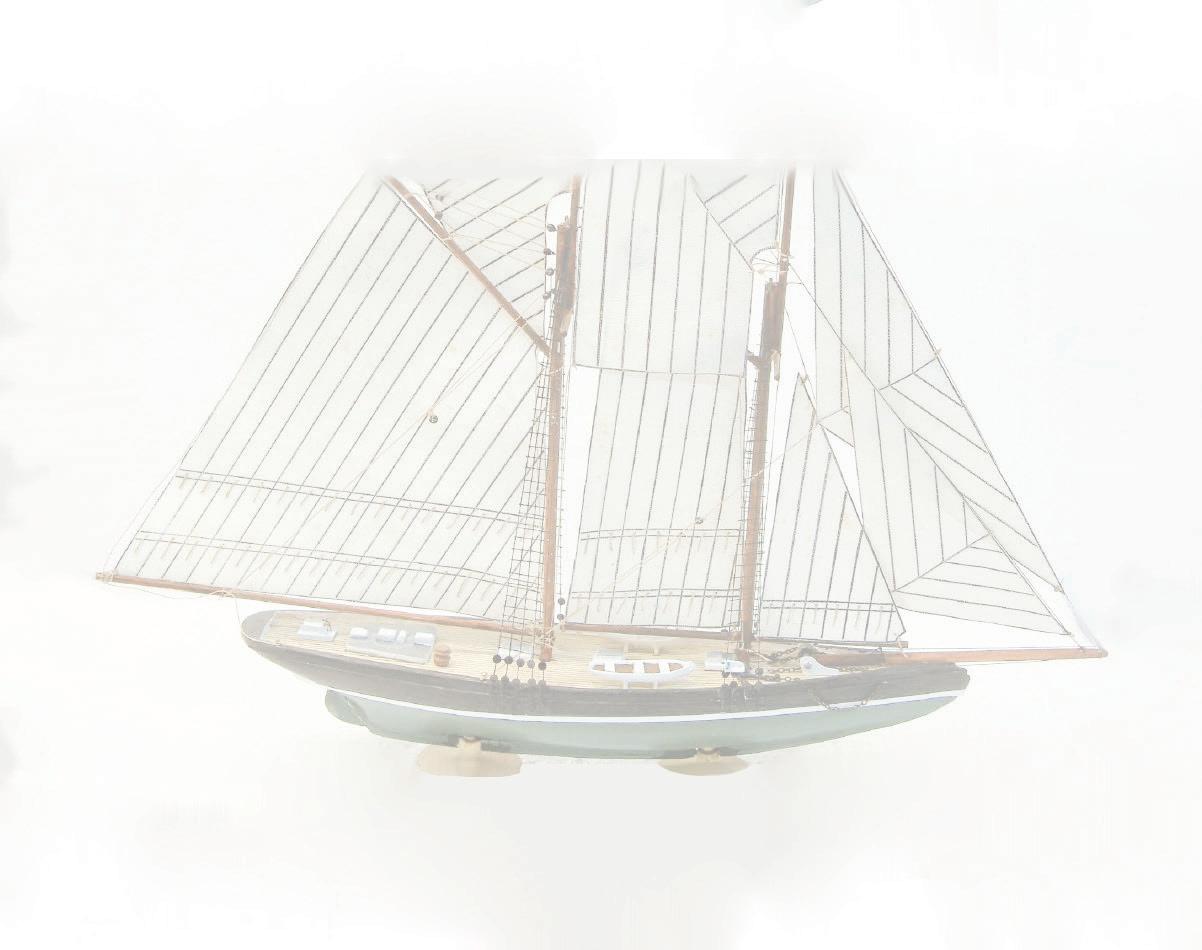


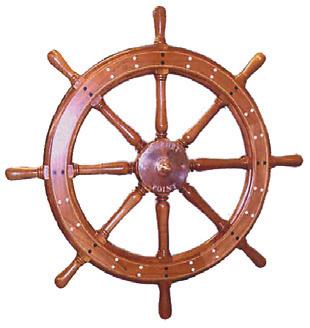

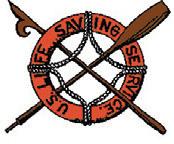


R. Michael Wall Ship Model Broker for sales and acquisitions = Collection Management and Appraisals
| wall@shipmodel.com
SHIP MODELS Since 1975 Wall ad-Sea History2022.qxp_Layout 1 1/5/22 12:53 PM Page 1
Ships by Ray Guinta
ship model maker who has been commissioned by the National Maritime Historical Society and the USS Intrepid Museum in NYC. TRADITIONAL WOODEN SHIP'S WHEELS
2.25”x 2” South Shore Boatworks #SH149 Revised
Preserving history, artifacts, and architecture of the Life-Saving Service and the U.S. Coast Guard
includes quarterly issues of Wreck & Rescue Journal
invitation
our
and
year.
U.S. LIFE-SAVING SERVICE HERITAGE ASSOCIATION
www.shipmodel.com
| 978-281-1166
Model
P.O. Box 74 Leonia, NJ 07605 201-461-5729 www.modelshipsbyrayguinta.com e-mail: raymondguinta@aol.com Experienced
SOUTH SHORE BOATWORKS HALIFAX, MA • 781-248-6446 www.southshoreboatworks.com Handmade in the U.S.A. by Third Generation Master Craftsman Bob Fuller.
SOUTH SHORE BOATWORKS HANSON, MA • 781-248-6446 WWW.SOUTHSHOREBOATWORKS.COM
USLSSHAMembership
plus an
to
annual meeting
conference, held in a different, historical area of the U.S. each
ww w.uslife-savingservice.or g uslssha @ gmail.com
CENTER FOR AMERICAN MARINEART

We are in a race to document and preserve important marine artworks before they are lost to posterity. Join us in our mission at AmericanMarineArt.com

.
WWW . AMERICANMARINEART . COM
Winslow Homer, Breezing Up (det.),
1873–76,
oil on canvas, Gift of the W L. and May T. Mellon Foundation at the National Gallery of Art, Washington, DC










































 —Jessica MacFarlane, NMHS Executive Director
—Jessica MacFarlane, NMHS Executive Director


















 by Peter Rindlisbacher, 2022
by Peter Rindlisbacher, 2022
























































 by Richard J. King
by Richard J. King






























































 John Grady Fairfax, Virginia
John Grady Fairfax, Virginia









 Salvatore M ercogliano, P h D Fuquay-Varina, North Carolina
Salvatore M ercogliano, P h D Fuquay-Varina, North Carolina






 M ichael R. H arrison Nantucket, Massachusetts
M ichael R. H arrison Nantucket, Massachusetts
 by Hilary Russell Jr.
by Hilary Russell Jr.




 John G alluzzo Hanover, Massachusetts
John G alluzzo Hanover, Massachusetts










